hub-and-spoke system
description: form of transport topology optimization in which traffic planners organize routes as a series of "spokes" that connect outlying points to a central "hub"
96 results
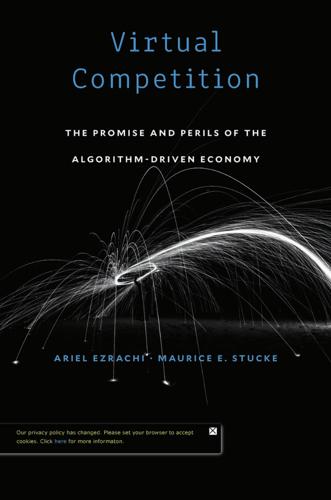
Virtual Competition
by
Ariel Ezrachi
and
Maurice E. Stucke
Published 30 Nov 2016
It is important to note how the algorithm-fueled hub and spoke differs from our first scenario—the Messenger—which considered the computer as a mere extension of the humans’ illegal agreement. In an algorithmdriven hub and spoke, the computer does not merely execute the orders of humans; rather, it is the competitors’ use of the same pricing algorithm that stabilizes prices and dampens competition. It is also important to distinguish between the traditional hub and spoke conspiracy, in which the immediate aim is horizontal collusion, and each vertical link is in furtherance of that aim, from an algorithm-driven hub and spoke. The latter may, of course, be the result of an intentional attempt to dampen competition, but it may also occur due to unintentional alignment and use of similar algorithms to monitor prices.
…
As messengers, algorithms are neither a negative nor positive force; rather, they are a technological extension of the human will. 6 Hub and Spoke H AVING CONSIDERED the “simple” Messenger scenario, we next consider instances in which computer algorithms are used as the central “hub” to coordinate competitors’ pricing or activities. While the competitors do not directly contact or communicate with each other, the overall impact of the practice is akin to horizontal collusion. Traditional Hub and Spoke Hub-and-Spoke conspiracies are not unique to the online environment or antitrust. After all, both cocaine and price-fi xing cartels may be facilitated by such arrangements.
…
Supreme Court noted, “an unlawful conspiracy may be and often is formed without simultaneous action or agreement on the part of the conspirators.”3 But to show a single hub-and-spoke conspiracy, rather than multiple independent conspiracies, there must be a rim: there must be some overall awareness of the conspiracy and that “each defendant knew or had reason to know of the scope of the conspiracy and . . . reason to believe that their own benefits were dependent upon the success 46 Hub and Spoke 47 of the entire venture.”4 In a hub-and-spoke price-fi xing conspiracy, the competitors who form the wheel’s spokes must be aware of the concerted effort to stabilize prices.

The Data Warehouse Toolkit: The Definitive Guide to Dimensional Modeling
by
Ralph Kimball
and
Margy Ross
Published 30 Jun 2013
So our concepts of dimensional modeling are often applied in this architecture, despite the complete disregard for some of our core tenets, such as focusing on atomic details, building by business process instead of department, and leveraging conformed dimensions for enterprise consistency and integration. Hub-and-Spoke Corporate Information Factory Inmon Architecture The hub-and-spoke Corporate Information Factory (CIF) approach is advocated by Bill Inmon and others in the industry. Figure 1.9 illustrates a simplified version of the CIF, focusing on the core elements and concepts that warrant discussion. Figure 1.9 Simplified illustration of the hub-and-spoke Corporate Information Factory architecture. With the CIF, data is extracted from the operational source systems and processed through an ETL system sometimes referred to as data acquisition.
…
See G/L (general ledger) ch7¶7 generic dimensions, abstract ch2¶249 geographic location dimension ch11¶52 G/L (general ledger) ch7¶7 chart of accounts ch7¶9 currencies, multiple ch7¶23 financial statements ch7¶34 fiscal calendar, multiple ch7¶31 hierarchies, drill down ch7¶33 journal entries ch7¶24 period close ch7¶15 periodic snapshot ch7¶8 year-to-date facts ch7¶21 GMT (Greenwich Mean Time) ch12¶40 goals of DW/BI ch1¶9 Google Analytics (GA) ch15¶57 governance business-driven ch4¶91 objectives ch4¶95 grain ch2¶18 accumulating snapshots ch2¶53 atomic grain data ch3¶25 budget fact table ch7¶40 conformed dimensions ch4¶81 declaration ch3¶24 retail sales case study ch3¶17, ch3¶23, ch3¶30, ch3¶96 dimensions, hierarchies and ch11¶19 fact tables ch1¶31, ch1¶34, ch1¶40, ch1¶41, ch1¶61 accumulating snapshot ch1¶40 periodic snapshot ch1¶40 transaction ch1¶40 periodic snapshots ch2¶50 single, facts and ch11¶17 transaction fact tables ch2¶47 granularity ch11¶15 GROUP BY clause ch1¶62 growth Lifecycle ch17¶19 market growth ch3¶202 H Hadoop, MapReduce/Hadoop ch21¶14 HCPCS (Healthcare Common Procedure Coding System) ch14¶9 HDFS (Hadoop distributed file system) ch21¶12 headcount periodic snapshot ch9¶23 header/line fact tables ch2¶185 header/line patterns ch6¶51, ch6¶65 healthcare case study ch14¶3 billing ch14¶11 claims ch14¶11 date dimension ch14¶23 diagnosis dimension ch14¶24 EMRs (electronic medical records) ch14¶7 HCPCS (Healthcare Common Procedure Coding System) ch14¶10 HIPAA (Health Insurance Portability and Accountability Act) ch14¶9 ICD (International Classification of Diseases) ch14¶10 images ch14¶44 inventory ch14¶45 measure type dimension ch14¶38 payments ch14¶11 retroactive changes ch14¶49 subtypes ch14¶32 supertypes ch14¶32 text comments ch14¶43 heterogeneous products ch10¶43 hierarchies accounting case study ch7¶74 customer dimension ch6¶24, ch8¶54 dimension granularity ch11¶19 dimension tables, multiple ch3¶77 drill down, ETL development ch20¶15 employees ch9¶37 ETL systems ch19¶113 fixed-depth positional hierarchies ch2¶160 G/L (general ledger), drill down ch7¶32 management, drilling up/down ch9¶45 many-to-one ch3¶62 matrix columns ch4¶204 multiple ch2¶84 nodes ch7¶58 ragged/variable depth ch2¶166 slightly ragged/variable depth ch2¶163 trees ch7¶58 high performance backup ch19¶302 HIPAA (Health Insurance Portability and Accountability Act) ch14¶8 historic fact tables extracts ch20¶51 statistics audit ch20¶53 historic load data, ETL development ch20¶25 dimension table population ch20¶26 holiday indicator ch3¶54 hot response cache ch8¶201 hot swappable dimensions ch2¶246, ch10¶52 household dimension ch10¶17 HR (human resources) case study ch9¶1 bus matrix ch9¶26 employee profiles ch9¶3 dimension change reasons ch9¶17 effective time ch9¶12 expiration ch9¶12, ch9¶13 fact events ch9¶23 type 2 attributes ch9¶23 hierarchies management ch9¶1, ch9¶3 recursive ch9¶37 managers key as foreign key ch3¶93 embedded ch9¶41 packaged analytic solutions ch9¶28 packaged data models ch9¶28 periodic snapshots, headcount ch9¶23 skill keywords ch9¶54, ch9¶59, ch9¶61 bridge ch9¶65, ch9¶66 text string ch9¶68 survey questionnaire ch9¶67, ch9¶74 text comments ch9¶74 HTTP (Hyper Text Transfer Protocol) ch15¶16 hub-and-spoke CIF architecture ch1¶107, ch1¶110 hub-and-spoke Kimball hybrid architecture ch1¶112 human resources management case study. See HR (human resources) ch9¶1 hybrid hub-and-spoke Kimball architecture ch1¶112 hybrid techniques, SCDs ch2¶150 SCD type 5 (add mini-dimension and type 1 outrigger) ch2¶150, ch5¶73 SCD type 6 (add type 1 attributes to type 2 dimension) ch2¶153, ch5¶76, ch5¶80, ch5¶81 SCD type 7 (dual type 1 and type 2 dimension) ch2¶156, ch5¶82, ch5¶87 hyperstructured data ch21¶9 I ICD (International Classification of Diseases) ch14¶9 identical conformed dimensions ch4¶80 images, healthcare case study ch14¶44 impact reports ch10¶24 incremental processing, ETL system development ch20¶77 changed dimension rows ch20¶81 dimension attribute changes ch20¶89 dimension table extracts ch20¶78 fact tables ch20¶92 new dimension rows ch20¶81 in-database analytics, big data and ch21¶45 independent data mart architecture ch1¶103, ch1¶104, ch1¶105, ch1¶106 indicators abnormal, fact tables ch8¶97 as textual attributes ch2¶87 dimension tables ch3¶55 junk dimensions and ch6¶42 satisfaction, fact tables ch8¶93 Inmon, Bill ch1¶107 insurance case study ch16¶2 accidents, factless fact tables ch2¶56 accumulating snapshot, complementary policy ch16¶37 bus matrix ch16¶56, ch16¶57 detailed implementation ch16¶58 claim transactions ch16¶60, ch16¶62, ch16¶65, ch16¶69, ch16¶73, ch16¶74 claim accumulating snapshot ch16¶73 junk dimensions and ch16¶61 periodic snapshot ch16¶42, ch16¶82 timespan accumulating snapshot ch16¶78 conformed dimensions ch16¶42 conformed facts ch16¶43 dimensions ch16¶20 audit ch16¶21 degenerate ch16¶30 low cardinality ch16¶31 mini-dimensions ch16¶26 multivalued ch16¶28 SCDs (slowly changing dimensions) ch16¶21 NAICS (North American Industry Classification System) ch16¶29 numeric attributes ch16¶29 pay-in-advance facts ch16¶44 periodic snapshot ch16¶39 policy transactions ch16¶16, ch16¶33 premiums, periodic snapshot ch16¶40 SIC (Standard Industry Classification) ch16¶29 supertype/subtype products ch16¶36, ch16¶47 value chain ch16¶10 integer keys ch3¶116 sequential surrogate keys ch3¶125 integration conformed dimensions ch4¶76 customer data ch8¶100, ch8¶101, ch8¶105 customer dimension conformity ch8¶105 single customer dimension ch8¶101 dimensional modeling myths ch1¶124 value chain ch4¶48 international names/addresses, customer dimension ch8¶26 interviews, Lifecycle business requirements ch17¶48 data-centric ch17¶55 inventory case study ch4¶6 accumulating snapshot ch4¶30 fact tables, enhanced ch4¶18 periodic snapshot ch4¶6 semi-additive facts ch4¶13 transactions ch4¶23 inventory, healthcare case study ch14¶48 invoice transaction fact table ch6¶67 J job scheduler, ETL systems ch19¶166 job scheduling, ETL operation and automation ch20¶116 joins dimension-to-dimension table joins ch2¶213 fact tables, avoiding ch8¶110 many-to-one-to-many ch8¶111 multipass SQL to avoid fact-to-fact joins ch2¶53 journal entries (G/L) ch7¶24 junk dimensions ch2¶99, ch6¶42 airline case study ch12¶31 ETL systems ch19¶116 insurance case study ch16¶62 order management case study ch6¶42 justification for program/project planning ch17¶21 K keys dimension surrogate keys ch2¶69 durable ch2¶72 foreign ch3¶93, ch10¶38 managers key (HR) ch9¶46 natural keys ch2¶72 supernatural keys ch2¶72 smart keys ch3¶127 subtype tables ch10¶47 supernatural ch2¶72 supertype tables ch10¶47 surrogate ch2¶173, ch3¶116, ch3¶119, ch3¶220, ch3¶120, ch11¶29 assigning ch2¶125 degenerate dimensions ch2¶78 ETL system ch19¶8, ch19¶11, ch19¶13, ch19¶27, ch19¶31, ch19¶33, ch19¶34 fact tables ch1¶31, ch1¶34, ch1¶40 generator ch19¶110 lookup pipelining ch20¶63 keywords, skill keywords ch9¶54 bridge ch9¶59 text string ch9¶61 Kimball Dimensional Modeling Techniques.
…
Index Symbols 3NF (third normal form) models ch1¶21 ERDs (entity-relationship diagrams) ch1¶22 normalized 3NF structures ch1¶23 4-step dimensional design process ch2¶11, ch3¶5 A abnormal scenario indicators ch8¶97 abstract generic dimensions ch2¶249 geographic location dimension ch11¶52 accessibility goals ch1¶303 accidents (insurance case study), factless fact tables ch16¶77 accounting case study ch7¶3 budgeting ch7¶36 fact tables, consolidated ch7¶80 G/L (general ledger) ch7¶7 chart of accounts ch7¶9 currencies ch7¶20 financial statements ch7¶34 fiscal calendar, multiple ch7¶31 hierarchies ch7¶59 journal entries ch7¶24 period close ch7¶16 periodic snapshot ch7¶9 year-to-date facts ch7¶22 hierarchies fixed depth ch7¶53 modifying, ragged ch7¶70 ragged, alternative modeling approaches ch7¶74 ragged, bridge table approach ch7¶78 ragged, modifying ch7¶70 ragged, shared ownership ch7¶67 ragged, time varying ch7¶68 ragged, variable depth ch7¶58 variable depth ch7¶62 OLAP and ch7¶86 accumulating grain fact tables ch1¶40 accumulating snapshots ch2¶53, ch4¶30, ch6¶89 claims (insurance case study) ch16¶65 complex workflows ch16¶101 timespan accumulating snapshot ch16¶78 ETL systems ch19¶132 fact tables ch4¶41, ch13¶201 complementary fact tables ch4¶33 milestones ch4¶42 OLAP cubes ch4¶45 updates ch4¶44 healthcare case study ch14¶16 policy (insurance case study) ch16¶40 type 2 dimensions and ch6¶96 activity-based costing measures ch6¶60 additive facts ch1¶35, ch2¶38 add mini dimension and type 1 outrigger (SCD type 5) ch2¶150 add mini-dimension (SCD type 4) ch2¶147 multiple ch5¶62, ch5¶64, ch5¶65, ch5¶66, ch5¶68, ch5¶69 add new attribute (SCD type 3) ch2¶144, ch5¶51, ch5¶62 multiple ch5¶61 add new row (SCD type 2) ch2¶140, ch5¶36 effective date ch5¶44 expiration date ch5¶44 type 1 in same dimension ch5¶50 addresses ASCII ch8¶26 CRM and, customer dimension ch8¶20 Unicode ch8¶27 add type 1 attributes to type 2 dimension (SCD type 6) ch2¶153 admissions events (education case study) ch13¶17 aggregate builder, ETL system ch19¶157 aggregated facts as attributes ch2¶228 CRM and, customer dimension ch8¶35 aggregate fact tables ch2¶59 clickstream data ch15¶54 aggregate OLAP cubes ch1¶27, ch2¶59 aggregate tables, ETL system development ch20¶114 agile development ch1¶132 conformed dimensions and ch4¶96 airline case study ch12¶2 bus matrix ch12¶4 calendars as outriggers ch12¶37 class of service flown dimension ch12¶30 destination airport dimension ch12¶33 fact tables, granularity ch12¶7 origin dimension ch12¶33 passenger dimension ch12¶14 sales channel dimension ch12¶18 segments, linking to trips ch12¶20 time zones, multiple ch12¶42 aliasing ch6¶14 allocated facts ch2¶188 allocating ch6¶59 allocations, profit and loss fact tables ch2¶191 ALTER TABLE command ch1¶59 analytics big data management ch21¶19 GA (Google Analytics) ch15¶57 in-database, big data and ch21¶45 analytic solutions, packaged ch9¶28 AND queries, skill keywords bridge ch9¶59 architecture big data best practices backflow ch21¶35 boundary crashes ch21¶38 compute resources ch21¶44 data highway planning ch21¶28 data quality planning ch21¶33 data value ch21¶34 ecosystems ch21¶32 fact extractor ch21¶31 in-database analytics ch21¶45 performance improvements ch21¶40 prototypes ch21¶23 streaming data ch21¶37 DW/BI alternatives ch1¶100 enterprise data warehouse bus architecture ch1¶77, ch4¶52 hub-and-spoke CIF architecture ch1¶107, ch1¶110 hybrid hub-and-spoke Kimball architecture ch1¶112 independent data mart architecture ch1¶103, ch1¶104, ch1¶105, ch1¶106 MapReduce/Hadoop ch21¶14 RDBMS, extension ch21¶8 real-time processing ch20¶127 archiving ch19¶23, ch19¶174 artificial keys ch3¶116 ASCII (American Standard Code for Information Interchange) ch8¶26 atomic grain data ch1¶59, ch3¶25 attributes aggregated facts as ch2¶228 bridge tables, CRM and ch8¶64 changes ch20¶89 detailed dimension model ch18¶40 expiration ch9¶11 flags ch2¶87 indicators ch2¶87 null ch2¶90, ch3¶95 numeric values as ch2¶179 pathstring, ragged/variable depth hierarchies ch2¶169 product dimensions ch4¶82 SCD type 3 (add new attribute) ch5¶51 multiple ch5¶61 audit columns, CDC (change data capture) ch19¶43 audit dimensions ch2¶252, ch6¶85 assembler ch19¶78 insurance case study ch16¶32 key assignment ch20¶70 automation, ETL system development errors ch20¶120 exceptions ch20¶120 job scheduling ch20¶116 B backflow, big data and ch21¶35 backups ch19¶305 backup system, ETL systems ch19¶171 archiving ch19¶174 compliance manager ch19¶26 dependency ch19¶195 high performance ch19¶302 lights-out operations ch19¶304 lineage ch19¶195 metadata repository ch19¶215 parallelizing/pipelining system ch19¶22 problem escalation system ch19¶197 recovery and restart system ch19¶179 retrieval ch19¶174 security system ch19¶204, ch19¶205 simple administration ch19¶303 sorting system ch19¶192 version control system ch19¶185 version migration system ch19¶187 workflow monitor ch19¶189 banking case study ch10¶4 bus matrix ch10¶4 dimensions household ch10¶20 mini-dimensions ch10¶28, ch10¶33 multivalued, weighting ch10¶21 too few ch10¶7 facts, value banding ch10¶39 heterogeneous products ch10¶43 hot swappable dimensions ch10¶52 user perspective ch10¶45 behavior customers, CRM and ch8¶70 sequential, step dimension and ch8¶78 study groups ch2¶225, ch8¶71 behavior tags facts ch8¶43 time series ch2¶222, ch8¶38 BI application design/development (Lifecycle) ch17¶98, ch17¶211 BI applications ch1¶80 BI (business intelligence) delivery interfaces ch19¶27 big data architecture best practices backflow ch21¶35 boundary crashes ch21¶38 compute resources ch21¶44 data highway planning ch21¶28 data quality planning ch21¶33 data value ch21¶34 ecosystems ch21¶32 fact extractor ch21¶12 in-database analytics ch21¶45 performance improvements ch21¶40 prototypes ch21¶23 streaming data ch21¶37 data governance best practices ch21¶60 dimensionalizing and ch21¶47 privacy ch21¶62 data modeling best practices data structure declaration ch21¶56 data virtualization ch21¶60 dimension anchoring ch21¶52 integrating sources and confined dimensions ch21¶48 name-value pairs ch21¶58 SCDs (slowly changing dimensions) ch21¶55 structured/unstructured data integration ch21¶54 thinking dimensionally ch21¶49 management best practices analytics and ch21¶19 legacy environments and ch21¶20 sandbox results and ch21¶23 sunsetting and ch21¶26 overview ch21¶3 blobs ch21¶10 boundary crashes, big data and ch21¶38 bridge tables customer contacts, CRM and ch8¶68 mini-dimensions ch10¶33 multivalued CRM and ch8¶17, ch8¶20, ch8¶26, ch8¶34, ch8¶35, ch8¶36, ch8¶37, ch8¶50, ch8¶54 time varying ch2¶219 multivalued dimensions ch2¶216, ch19¶144 ragged hierarchies and ch7¶79 ragged/variable depth hierarchies ch2¶166 sparse attributes, CRM and ch8¶67 bubble chart, dimension modeling and ch18¶31 budget fact table ch7¶39 budgeting process ch7¶36 bus architecture ch4¶53 enterprise data warehouse bus architecture ch2¶121 business analyst ch17¶201 Business Dimensional Lifecycle ch17¶5 business-driven governance ch4¶91 business driver ch17¶202 business initiatives ch3¶7 business lead ch17¶203 business motivation, Lifecycle planning ch17¶19 business processes characteristics ch3¶5 dimensional modeling ch2¶15, ch11¶13 retail sales case study ch3¶21 value chain ch4¶4 business representatives, dimensional modeling ch18¶12 business requirements dimensional modeling ch18¶17 Lifecycle ch17¶9, ch17¶42 documentation ch17¶57 forum selection ch17¶32, ch17¶38 interviews ch17¶48, ch17¶72 launch ch17¶47 prioritization ch17¶60 representatives ch17¶42 team ch17¶39 business rule screens ch19¶69 business sponsor ch17¶18 Lifecycle planning ch17¶18 business users ch17¶204 perspectives ch10¶45 bus matrix accounting ch7¶3 airline ch12¶4 banking ch10¶4 detailed implementation bus matrix ch2¶127 dimensional modeling and ch18¶48 enterprise data warehouse bus matrix ch2¶124 healthcare case study ch14¶3 HR (human resources) ch9¶28 insurance ch16¶2, ch16¶10 detailed implementation ch16¶57 inventory ch4¶7 opportunity/stakeholder matrix ch4¶69 order management ch6¶6 procurement ch5¶4, ch5¶18 telecommunications ch11¶4 university ch13¶4 web retailers, clickstream integration ch15¶63 C calculation lag ch6¶97 calendar date dimensions ch2¶93 calendars, country-specific as outriggers ch12¶37 cannibalization ch3¶101 cargo shipper schema ch12¶27 case studies accounting ch7¶3 budgeting ch7¶38 consolidated fact tables ch7¶83, ch7¶89 G/L (general ledger) ch7¶8, ch7¶8, ch7¶9, ch7¶9, ch7¶10, ch7¶16, ch7¶22 hierarchies ch7¶59, ch7¶60 OLAP and ch7¶86 airline ch12¶2 calendars as outriggers ch12¶43 class of service flown dimension ch12¶35 destination airport dimension ch12¶38 fact table granularity ch12¶7 origin dimension ch12¶38 passenger dimension ch12¶16 sales channel dimension ch12¶21 time zones, multiple ch12¶40 CRM (customer relationship management) analytic ch8¶11 bridge tables ch8¶59 complex customer behavior ch8¶74 customer data integration ch8¶106, ch8¶107, ch8¶112 customer dimension and ch8¶17 fact tables, abnormal scenario indicators ch8¶97 fact tables, satisfaction indicators ch8¶93 fact tables, timespan ch8¶85 low latency data ch8¶122 operational ch8¶11 step dimension, sequential behavior ch8¶81 education ch13¶4, ch13¶17 accumulating snapshot fact table ch13¶6, ch13¶41 additional uses ch13¶38 admissions events ch13¶17 applicant pipeline ch13¶7 attendance ch13¶37 change tracking ch13¶20 course registrations ch13¶18, ch13¶28 facility use ch13¶33 instructors, multiple ch13¶29 metrics, artificial count ch13¶22 research grant proposal ch13¶14 student dimensions ch13¶20 term dimensions ch13¶19 electronic commerce clickstream data ch15¶1, ch15¶4, ch15¶7, ch15¶9, ch15¶11, ch15¶14, ch15¶19, ch15¶58, ch15¶60 profitability, sales transactions and ch15¶65 financial services ch10¶2, ch10¶4, ch10¶21 dimensions, household ch10¶17 dimensions, too few ch10¶6 healthcare ch14¶3, ch14¶6 billing ch14¶12 claims ch14¶12 date dimension ch14¶23 diagnosis dimension ch14¶26 EMRs (electronic medical records) ch14¶7 HCPCS (Healthcare Common Procedure Coding System) ch14¶10 HIPAA (Health Insurance Portability and Accountability Act) ch14¶9 ICD (International Classification of Diseases) ch14¶10 images ch14¶49 inventory ch14¶50 measure type dimension ch14¶38, ch14¶40 payments ch14¶12 retroactive changes ch14¶49 subtypes ch14¶35 supertypes ch14¶35 text comments ch14¶48 HR (Human Resources Management) bus matrix ch9¶28 employee hierarchies ch9¶37 employee profiles ch9¶3, ch9¶12, ch9¶17, ch9¶23 hierarchies ch9¶37, ch9¶45 managers key ch9¶41, ch9¶46 packaged data models ch9¶28, ch9¶34, ch9¶36 periodic snapshots ch2¶22, ch4¶7 skill keywords ch9¶54, ch9¶56, ch9¶58, ch9¶59, ch9¶61, ch9¶66 survey questionnaire ch9¶67, ch9¶74 insurance ch16¶2, ch16¶4, ch16¶7 accident events factless fact table ch16¶76 accumulating snapshot ch16¶37, ch16¶65 bus matrix ch16¶14, ch16¶61 claim transactions ch16¶67, ch16¶70, ch16¶73, ch16¶78 conformed dimensions ch16¶45 conformed facts ch16¶46 degenerate dimension ch16¶30 dimensions ch16¶31, ch16¶32, ch16¶49 dimensions, audit ch16¶32 dimensions, low cardinality ch16¶31 dimensions, multivalued ch16¶27 junk dimensions ch16¶61 mini-dimensions ch16¶26 multivalued dimensions ch16¶48 NAICS (North American Industry Classification System) ch16¶29 numeric attributes ch16¶30 pay-in-advance facts ch16¶47 periodic snapshot ch16¶42 policy transaction fact table ch16¶33 policy transactions ch16¶17, ch16¶34 premiums, periodic snapshot ch16¶43 SCDs (slowly changing dimensions) ch16¶21 SIC (Standard Industry Classification) ch16¶29 supertype/subtype products ch16¶39, ch16¶51 timespan accumulating snapshot ch16¶69 value chain ch16¶10 inventory accumulating snapshot ch4¶31 fact tables ch4¶16, ch4¶37, ch4¶41 periodic snapshot ch4¶7 semi-additive facts ch4¶13, ch4¶16, ch4¶17 transactions ch4¶25, ch4¶38, ch4¶40 order management ch6¶6 accumulating snapshots ch4¶31, ch4¶45, ch4¶48 audit dimension ch6¶92 customer dimension ch6¶26, ch6¶28, ch6¶32 deal dimension ch6¶40 header/line pattern ch6¶49 header/line patterns ch6¶49, ch6¶51 invoice transactions ch6¶75 junk dimensions ch6¶46 lag calculations ch6¶97 multiple currencies ch6¶52 product dimension ch6¶20, ch6¶21, ch6¶275, ch6¶22, ch6¶206 profit and loss facts ch6¶87 transaction granularity ch6¶84 transactions ch6¶11, ch6¶47 units of measure, multiple ch6¶99 procurement ch5¶4, ch5¶7 bus matrix ch5¶7 complementary procurement snapshot fact table ch5¶18 transactions ch5¶7, ch5¶9 retail sales ch3¶16 business process selection ch3¶23 dimensions, selecting ch3¶32 facts ch3¶15, ch3¶35, ch3¶38, ch3¶41, ch3¶43, ch3¶144 facts, derived ch3¶38 facts, non-additive ch3¶41 fact tables ch3¶43 frequent shopper program ch3¶108 grain declaration ch3¶25 POS schema ch3¶103 retail schema extensibility ch3¶107 telecommunications ch11¶4 causal dimension ch3¶85, ch10¶200 CDC (change data capture) ETL system ch19¶8 audit columns ch19¶43 diff compare ch19¶45 log scraping ch19¶46 message queue monitoring ch19¶47 timed extracts ch19¶44 centipede fact tables ch2¶176, ch3¶144 change reasons ch9¶15 change tracking ch5¶19, ch5¶23 education case study ch13¶20 HR (human resources) case study, embedded manager's key ch9¶41 SCDs ch5¶21 chart of accounts (G/L) ch7¶9 uniform chart of accounts ch7¶13 checkpoints, data quality ch20¶95 CIF (Corporate Information Factory) ch1¶107, ch1¶110 CIO (chief information officer) ch16¶8 claim transactions (insurance case study) ch16¶60 claim accumulating snapshot ch16¶65 junk dimensions and ch16¶62 periodic snapshot ch16¶73 timespan accumulating snapshot ch16¶69 class of service flown dimension (airline case study) ch12¶30 cleaning and conforming, ETL systems ch19¶201 audit dimension assembler ch19¶78 conforming system ch19¶84 data cleansing system ch19¶62 quality event responses ch19¶57 quality screens ch19¶52 data quality improvement ch19¶58 deduplication system ch19¶80 error event schema ch19¶71 clickstream data ch15¶1 dimensional models ch15¶19, ch15¶26 aggregate fact tables ch15¶54 customer ch15¶31, ch15¶33 date ch15¶31, ch15¶33 event dimension ch15¶26 GA (Google Analytics) ch15¶57 page dimension ch15¶21 page event fact table ch15¶41 referral dimension ch15¶29 session dimension ch15¶27 session fact table ch15¶30 step dimension ch15¶58 time ch15¶32, ch15¶34 session IDs ch15¶15 visitor identification ch15¶18 visitor origins ch15¶11 web retailer bus matrix integration ch15¶63 collaborative design workshops ch2¶8 column screens ch19¶67 comments, survey questionnaire (HR) ch9¶74 common dimensions ch4¶76 compliance, ETL system ch19¶11 compliance manager, ETL system ch19¶26 composite keys ch1¶42 computer resources, big data and ch21¶44 conformed dimensions ch2¶109, ch4¶76, ch11¶33 agile movement and ch4¶96 drill across ch4¶77, ch4¶79 grain ch4¶81 identical ch4¶80 insurance case study ch16¶42 limited conformity ch4¶88 shrunken on bus matrix ch4¶86 shrunken rollup dimensions ch4¶82 shrunken with row subset ch4¶84 conformed facts ch2¶44, ch4¶14 insurance case study ch16¶43 inventory case study ch4¶11 conforming system, ETL system ch19¶84 consistency adaptability ch1¶200 goals ch1¶9 consolidated fact tables ch2¶160 accounting case study ch7¶80 contacts, bridge tables ch8¶68 contribution amount (P&L statement) ch6¶201 correctly weighted reports ch10¶22 cost, activity-based costing measures ch6¶60 COUNT DISTINCT ch8¶49 country-specific calendars as outriggers ch12¶37 course registrations (education case study) ch13¶18 CRM (customer relationship management) ch8¶1 analytic ch8¶11 bridge tables customer contacts ch8¶68 multivalued ch8¶61 sparse attributes ch8¶67 complex customer behavior ch8¶70 customer data integration ch8¶100 multiple customer dimension conformity ch8¶105 single customer dimension ch8¶101 customer dimension and ch8¶17 addresses ch8¶26 addresses, international ch8¶27 counts with Type 2 ch8¶49 dates ch8¶34 facts, aggregated ch8¶35 hierarchies ch8¶54, ch8¶55 names ch8¶26 names, international ch8¶27 outriggers, low cardinality attribute set and ch8¶51 scores ch8¶36 segmentation ch8¶36 facts abnormal scenario indicators ch8¶103 satisfaction indicators ch8¶98 timespan ch8¶89 low latency data ch8¶115 operational ch8¶11 overview ch8¶5 social media and ch8¶8 step dimension, sequential behavior ch8¶78 currency, multiple fact tables ch2¶194 G/L (general ledger) ch7¶8 order transactions ch6¶52 current date attributes, dimension tables ch3¶56 customer contacts, bridge tables ch8¶68 customer dimension ch6¶23, ch6¶24, ch6¶29, ch6¶34 clickstream data ch15¶32 CRM and ch8¶17 addresses ch8¶26 addresses, international ch8¶27 counts with Type 2 ch8¶49 dates ch8¶35 facts, aggregated ch8¶35 hierarchies ch8¶52, ch8¶56 names ch8¶26 names, international ch8¶27 outriggers, low cardinality attribute set and ch8¶51 scores ch8¶36 segmentation ch8¶36 factless fact tables ch6¶34 hierarchies ch6¶24 multiple, partial conformity ch8¶15 single ch8¶11 single versus multiple dimension tables ch6¶29 customer matching ch8¶14 customer relationship management. case study.
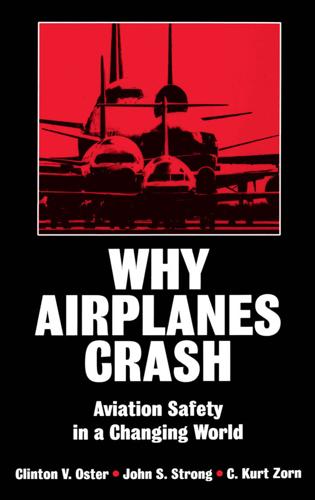
Why Airplanes Crash: Aviation Safety in a Changing World
by
Clinton V. Oster
,
John S. Strong
and
C. Kurt Zorn
Published 28 May 1992
Homebuilt aircraft An airplane built from a kit or from basic material; these planes are not subject to the same standards as commercial aircraft, but are restricted as to where and when they can fly. Horizontal stabilizer The fixed horizontal component of an aircraft's tail assembly which controls up and down movement of the tail. Hub and spoke system A pattern of airline service that links outlying communities to a central hub airport. Hub and spoke flights are often arranged to match the collection and distribution of passengers from a number of spoke communities so that connections to cities beyond the hub are facilitated. The International Civil Aviation Organization (ICAO) An agency of the United Nations, composed of contracting countries, whose purpose is to develop the principles and techniques of international air navigation, transport, and safety.
…
Deregulation's route freedoms have allowed airlines to exploit the service advantages of hub and spoke route systems. By having a group of aircraft from many destinations all converge at an airport at about the same time, a great many connecting opportunities then can be offered passengers. If too many flights converge at one time, however, airport and airspace capacity can be strained, with congestion-related delays, declines in service quality, and much greater pressure on air traffic control to keep aircraft from colliding in the air or on the ground. In addition to the impacts of intensified hubbing, the increase in traffic volume stimulated in part by deregulation's lower fares, coupled with the 1981 dismissal of striking Professional Air Traffic Controllers Organization (PATCO) controllers has increased pressure throughout most of the nation's air traffic control system.
…
The first is the impact of a carrier's financial situation on its safety performance. Second, is the impact of industry consolidation on safety. Third, is the impact of increased traffic handled through intensified hub and spoke route systems. These issues are of current concern in the United States and are becoming of increased concern in Canada and Australia as these countries' airline industries adapt to a less restrictive economic environment. As the economic regulatory environment changes in Europe and perhaps other regions of the world, they are likely to become worldwide concerns. Financial Performance Deteriorating or persistently poor financial performance can increase pressure for cost-cutting by carriers.
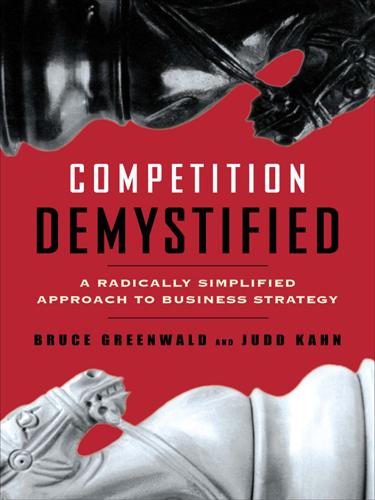
Competition Demystified
by
Bruce C. Greenwald
Published 31 Aug 2016
It could focus its local advertising where its route structure was most dense. There were substantial regional economies of scale for the airline that dominated a hub airport, as well as the benefits of needing to fly fewer planes to service its routes. But all the cost and revenue advantages of a hub-and-spoke system were vulnerable to intense competition from weaker carriers who, in order to fill their seats, dropped prices below what it cost to fly the passengers. When one airline dominated a hub, it made money. When two well-established airlines served a single hub city, they often managed to keep prices stable and profitable. But a third carrier, especially one trying to break into a new market, with low labor and other fixed costs, and with an aggressive management out to earn their wings, could wreak havoc on the incumbents’ income statements.
…
See Marketing Aetna Aggression avoiding costs nature of Airbus Aircraft industry Airline Deregulation Act Airline industry barriers to entry buyouts customer loyalty programs deregulation direct competition avoidance government regulation hub-and-spoke system industry map market segments market share stability price competition in returns technology travel agent relations yield management AMD (Advanced Micro Devices) Intel v. America Japan v. manufacturing productivity American Airlines America Online. See AOL Amoco Anheuser-Busch Coors v. market share stability Miller v.
…
Only the customers benefited. Of the many unanticipated changes induced by deregulation, the most far-reaching was the emergence of a hub-and-spoke route system. Under the pressure of competition, the trunk carriers realized that they could lower costs and fill more seats by funneling traffic through hub cities, where long-distance and short-haul flights converged. A single hub connected directly to 40 cities at the ends of its spokes would link 440 city pairs with no more than one stop or change of planes. The airline could concentrate its maintenance and passenger service facilities in the hub airports. It could focus its local advertising where its route structure was most dense.

Skygods: The Fall of Pan Am
by
Robert Gandt
Published 1 Mar 1995
The idea was that you could make money flying a passenger from New York to Europe it you also sold him a ticket to or from somewhere else in your system—Kansas City, Denver, Dallas. Each time Pan Am was poised to build a true domestic system that fed its international web, it had, instead, done something egregiously inappropriate, like buying a regional airline (National, 1980), which it then proceeded to dismantle instead of expanding into a hub-and-spoke operation. Or building a nonfeeder “halo” operation (the Northeast Shuttle, 1987) that was disconnected from the rest of the airline. Now it was too late. There was no money left to build anything. Even the shuttle was for sale. Pan Am’s summer of 1989 came and went, mostly without passengers. Almost all advance bookings had been wiped out by the disaster at Lockerbie.
…
The truth was that almost nobody was making money flying the North Atlantic. Historically, the Pacific had been Pan Am’s only real moneymaker, which was why, of course, United Airlines had bought it from Ed Acker in 1985. The Atlantic had become a cheap-fare market, with too many carriers flying too many seats for ridiculously low fares. The other major players on the Atlantic—United, American, TWA—fed their international flights from strong hub-and-spoke domestic systems—something Pan Am had never developed. The idea was that you could make money flying a passenger from New York to Europe it you also sold him a ticket to or from somewhere else in your system—Kansas City, Denver, Dallas.
…
Delta was one of the first airlines to construct a hub-and-spoke system, concentrating its activity at “hubs” like Atlanta, Dallas, Cincinnati, and Salt Lake City, with feeder routes—“spokes”—radiating outward to its hundreds of satellite destinations. The “Big Three”—American, United, and Delta—had all prospered under deregulation, developing hub-and-spoke networks, frequent-flier programs, computer reservations systems, and sophisticated yield management strategies that enabled them to overwhelm their regional competitors. While American and United, both flush with cash, spent over a billion dollars buying up the routes of Pan Am, TWA, Continental, and Eastern, Delta had held back.

Model Thinker: What You Need to Know to Make Data Work for You
by
Scott E. Page
Published 27 Nov 2018
If all 45 friendships existed, then the person’s clustering coefficient would equal 1, the maximal possible value. The clustering coefficient for the entire network equals the average of the clustering coefficients of the individual nodes. Figure 10.1: A Hub-and-Spoke Network and a Geographic Network Figure 10.1 shows two networks with thirteen nodes: a hub-and-spoke network and a geographic network. In the hub-and-spoke network, the hub has degree 12 and all other nodes have degree 1, for an average degree of less than 2. The degree distribution is unequal. The hub has a distance of 1 to every node. All other nodes have a distance of 1 to the hub and a distance of 2 to the other nodes.
…
This network, therefore, does not seem to have much of an effect on the likelihood of disease spread. Next, consider the hub-and-spoke network. The first node to get the disease could be the hub or a spoke. If the hub catches the disease, then it could spread the disease to any one of the spokes. We would expect the disease to spread, even for a low probability of spreading. If a spoke caught the disease, then the only possible node that could catch the disease is the hub. And as we just learned, if the hub catches the disease, the disease will spread even for low probabilities of spreading. For the hub-and-spoke network, R0 is less informative because if the hub catches the disease, the disease will spread.
…
The organization of this chapter follows the same structure-logic-function format we applied to distributions. We first characterize the structure of networks using statistical measures of degree, path length, clustering coefficient, and community structure. Then we discuss common classes of networks: random networks, hub-and-spoke networks, geographic networks, small-world networks, and power-law networks. After that we turn to the logic of how networks form. We construct micro-level processes that produce the network structures we see. Last, we take up function, the question of why network structure matters. Here we focus on five implications.

Tubes: A Journey to the Center of the Internet
by
Andrew Blum
Published 28 May 2012
Many engineers use the airport analogy: in addition to the handful of global megahubs, there are hundreds of regional hubs, which exist to capture and redistribute as much of the traffic within their area as is practical. But as with the airlines, the smaller nodes of this hub-and-spoke system are always pressured by the tendency toward global consolidation. As Internet networks (or airlines) merge, the big hubs become even bigger—sometimes with a significant loss of efficiency. In Minnesota, the local network engineers refer to this as the “Chicago problem.” Two small competing Internet service providers in rural Minnesota might find themselves sending and receiving all their data to and from Chicago, by buying capacity on the paths of one of the big nationwide backbones, like Level 3 or Verizon.
…
On his maps, Krisetya portrayed this by showing the most heavily trafficked routes between cities, such as between New York and London, with the thickest lines—not because there were necessarily more cables there (or some single, superthick cable) but because that was the route across which the most data flowed. This was an insight that dated back to that first report. “If you look inside the Internet cloud a fairly distinct hub-and-spoke structure begins to emerge at both an operational (networking) and physical (geopolitical) level,” it explained. The Internet’s structure “is based upon a core of meshed connectivity between world cities on coastal shores—Silicon Valley, New York and Washington, DC; London, Paris, Amsterdam and Frankfurt; Tokyo and Seoul.”
…
See also specific hub Hubs + Spokes: A TeleGeography Internet Reader (TeleGeography), 26 Hugh O’Kane Electric Company, 165, 166, 167 Hurricane Electric, 121, 266 IBM, 52 IMP (interface message processor) beginning of Internet and, 36, 39–49 expansion of Internet and, 50 first successful transmission of, 48 India, 204 “information highway”: Internet as, 19–20, 63–64 ING Canada, 124 International Brotherhood of Electrical Workers, 166 Internet backbone of, 14, 18 cables as “inter” part of, 97 capitalization of, 106–7 centers of, 9, 108–9, 112–13, 268 decentralization of, 54 earth’s connection to, 101–3 efficiency of, 231 essence of, 47, 135 expansion of, 6, 49–57, 109, 118, 138 fail-safe for, 100 286 as fantasy, 8 fickleness of, 261 founding ideology of, 54, 133 geography of, 28 globalization of, 70–71, 87, 193 Gore as inventor of, 63 “ground truth” of, 29 as handmade, 118 history of, 35–57, 107, 147 as hub-and-spoke system, 109–10 as human construction, 158 images of, 5, 6–8, 9, 18, 34, 107–8, 229–30, 266–68 as “information highway,” 19–20, 63–64 Kleinrock as a father of, 41–42 light of, 162, 163 limits of, 3 as math made manifest, 163 meshed connectivity of, 27, 64–65 most important places on, 127 myths about, 40 openness/publicness of, 30–31, 73–75, 116, 117–18, 124, 133 as overlap of geographical and physical elements, 19 photographs of, 21 prevalence of, 3, 34 questions about what is the, 2–10, 264–68 quintessence of, 163 reality of, 9 as self-healing, 200 as series of tubes, 5–6 shutdown of Blum’s, 1–4, 18, 144, 264 smell of, 44, 49 structure of, 27, 54, 64–65, 87 threats to, 116–17 uneven distribution of, 262 as unfinished, 67 uniqueness of, 106 usage of, 3, 34, 55, 66–67 Internet Assigned Numbers Authority, 29, 30, 31, 45 Internet exchanges “IX” as center of Internet, 108–9, 112–13 characteristics of largest, 111–13 competition among, 133–35 definition of, 109 gap between average-size and large, 130 as hub-and-spoke system, 109–10 location of, 113 peering and, 121–22, 126, 127, 129, 130 problems of, 109–11 rationale for, 109 security at, 113–16 See also specific exchange Internet Explorer (Microsoft), 57 Internet Heritage Site and Archive, Kleinrock, 44–45 “Internet Mapping Project” (Kelly), 7–8 Interxion, 140 Inventing the Internet (Abbate), 35–36 IP addresses, 29, 30, 31–32 The IT Crowd (TV show), 108, 143 Jagiellonian University (Poland): Traceroute example for, 31–32 Japan, 27, 33, 111, 113, 196, 198, 199, 201, 208 Jobs, Steve, 267 JPNAP (Tokyo), 111, 113 Juniper routers, 99–100 Justice Department, US, 123 Karlson, Dave, 244–45 Kelly, Kevin, 7, 8–9 Kenya, 198 Kingdom Brunel, Isambard, 203, 253 Kirn, Walter, 38 Kleinrock Internet Heritage Site and Archive (UCLA), 44–45 Kleinrock, Leonard, 36, 41–49, 51, 52, 69, 158 Kozlowski, Dennis, 195 KPN, 148, 155, 266 Krisetya, Markus, 13–17, 21, 23, 25, 26–27, 28, 45 Kubin-Nicholson Corporation, 13–14, 16–17, 21 landing stations, cable, 193, 202, 203.
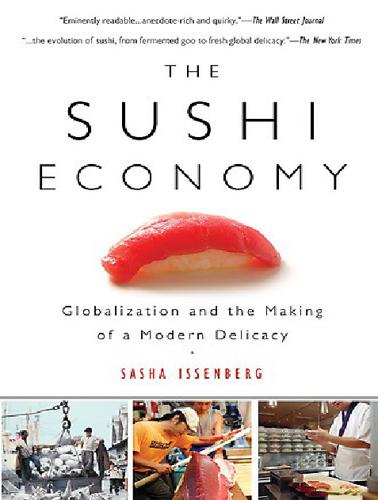
The Sushi Economy: Globalization and the Making of a Modern Delicacy
by
Sasha Issenberg
Published 1 Jan 2007
Shinji ended up in the fish business only when, after graduating from college with an economics degree and no career prospects, his rugby coach introduced him to a relative who worked at Toiichi. Shinji took the entrance test and became an auctioneer at Tsukiji, handling sales of “sushi fish,” as non-tuna seafood for the raw market is classified. After a few years, he joined the family business, and in 1985 inherited the store. It was a precipitous time to become a fishmonger. The hub-and-spoke network of municipal fish markets and local retailers had long provided the Japanese their central source of protein, given the abundance of seafood in all parts of the country and the limited availability of livestock in most of them. (There is little dairy in traditional Japanese cuisine because farmers never practiced large-scale animal husbandry.)
…
Kliss also decided he didn’t need a dockside presence in Gloucester and instead set up shop in an old Hood milk factory in the industrial suburb of Lynn. It was a long way from any open water, but minutes from Boston’s Logan Airport and more or less equidistant between Cape Cod and the north shore. Kliss was relying on a hub-and-spoke mentality; he would just dispatch trucks to Gloucester docks when fish came in and bring them back to Lynn for processing. He would have someone run a truck along Cape Cod to do the same there. It demanded more flexibility than being able to sit on the wharf like Godfried and wait for boats to come in, but would help reduce the most significant fixed costs an agent faces.
…
See China; sushi economy Gibraltar globalization and black market seafood sushi economy Tsukiji Market (Tokyo) See also sushi economy Gloucester, Massachusetts Glynn, Andy Godfried, Mark “Golden Age of American food chemistry,” “Golden Arches Theory of Conflict Prevention” (Friedman) Gomi, Yoshitomo good, tuna becoming a Google satellite maps gratuities, pooling Griffin, Albert hake hakozushi (box sushi) hamachi handling standards for fish handrolls “hard cargo,” harvesting tuna Hawaii haya-zushi (“quick sushi”) head sushi chef Hepburn, Audrey Hibino, Terutoshi hierarchical division of labor, sushi bars Hirohito (Emperor of Japan) Hitch, Steve Hollywood and sushi home chefs Hori, Takeaki horse mackerel (aji) horseradish to kill toxins Hoshizaki, Sadagoro hub-and-spoke mentality Hudson, Rock hunter-gatherers hurricanes Hussein, Saddam ICCAT (International Commission for the Conservation of the Atlantic Tuna) iceboxes ice for insulating fish Iida, Toichiro Iida, Tsunenori Imaizumi, Teruo, 90 immigrants to California, 81–82 inari India ingredients, adding innovation, promise of intelligence gathering on tuna ranching intermediate wholesaler (nakaoroshi) International Commission for the Conservation of the Atlantic Tuna (ICCAT), 232 internment of Japanese inventory, checking inventory control, sushi chefs Islam, Seif alIzawa, Arata JAL.
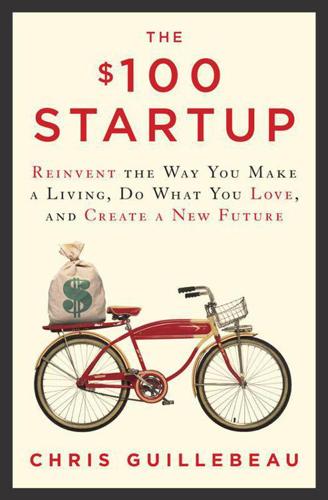
The $100 Startup: Reinvent the Way You Make a Living, Do What You Love, and Create a New Future
by
Chris Guillebeau
Published 7 May 2012
Strategies to do this include outsourcing, affiliate recruitment, and partnerships. Use the hub-and-spoke model of maintaining one online home base while using other outposts to diversify yourself. When it comes to outsourcing, decide for yourself what’s best. The decision will probably come down to two things: the kind of business you’re building and your personality. Carefully chosen partnerships can create leverage; just make sure that’s what you want to do. Use the One-Page Partnership Agreement for simple arrangements. *I’m grateful to Chris Brogan for the term outposts as well as the general concept of the hub and spoke applied to building a brand.
…
As a business grows and the business owner begins itching for new projects, he or she essentially has two options for self-made franchising: Option 1: Reach more people with the same message. Option 2: Reach different people with a new message. Either option is valid, and both can be rewarding. For the first option, it may be helpful to think of the “hub-and-spoke” model when building a brand, especially online. In this model, the hub is your main website: often an e-commerce site where something is sold, but it could also be a blog, a community forum, or something else. The hub is a home base with all the content curated by you or your team and ultimately where you hope to drive new visitors, prospects, and customers.
…
Clients tell Gary where they want to go, which airline their miles are coming from, and any restrictions they have on their travel dates. Then Gary gets to work, combing databases to check on availability, phoning the airlines, and taking advantage of every loophole. It may sound strange to pay $250 for something you could do on your own for free, but the value Gary provides through the service is immense: Many of the trips he arranges would otherwise cost $5,000 or more. He specializes in first- and business-class itineraries, and some of them feature as many as six airlines on a single award ticket. You want a free stopover in Paris en route to Johannesburg?
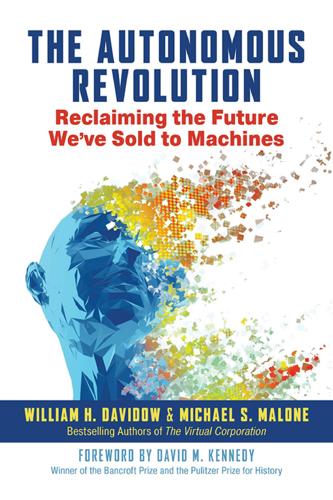
The Autonomous Revolution: Reclaiming the Future We’ve Sold to Machines
by
William Davidow
and
Michael Malone
Published 18 Feb 2020
Part-time workers now perform jobs that once came with salaries, health care, and other benefits. A part-time Uber worker displaces the fleet taxi driver. A skilled union electrician suddenly finds himself doing part-time work via TaskRabbit. A lot more people are going to be working in the gig economy. But perhaps the most significant phenomenon of all is what we would call the hub-and-spoke business model, in which a small, highly compensated core group works for a company that organizes the work of hundreds, thousands, and tens of thousands of subcontractors. Uber has about 12,000 employees and contracts with approximately 1.5 million drivers worldwide—a 100 to 1 ratio.54 Facebook tops that, with about 25,000 employees and approximately 2 billion active users who provide the company with monetizable content for free, a ratio of 8,000 to 1.55 These companies illustrate another of the important commercial trends identified at the start of this chapter: that the sharing economy will drive the transformation of a whole range of commercial enterprises.
…
Hotels will not go away. Many people will never use shared office space or even consider sharing a stranger’s car. But new business models will exert price pressures on many capital-intensive businesses, making it much more difficult for them to grow and compete. From a commercial and social point of view, the hub-and-spoke model of business in the shared economy may be of greater significance than the asset-sharing aspect. It might be said that the “secret sauce” of the shared economy is the principle that the more workers you can outsource, the better it will be for the owners and senior management. A permanent employee is a double-edged sword.
…
The transition from tribal cultures to agricultural communities depended on the development of better modes of transportation—wagons drawn by horses and oxen and ships that could transport goods. Cities would never have been viable without the means to get food and energy (firewood at first, and later coal and other petroleum products) in from the countryside and the goods that they manufactured out to distant markets. The railroad created densely populated industrial cities and the hub-and-spoke pattern of suburban infrastructure, in which homes were built along railroad lines. The automobile created a more sprawling, two-dimensional suburban infrastructure, in which homes, businesses, and shopping centers could be located anywhere a car could reach. A lot of the economic and employment growth of the post–World War II period was created by building those highways, shopping centers, and detached houses.

Aerotropolis
by
John D. Kasarda
and
Greg Lindsay
Published 2 Jan 2009
Competition proved fatal for Braniff, Dallas’s hometown airline since 1928 and one of the fastest growing in America until deregulation. Four years later it was defunct, followed by Eastern and Pan Am within a decade and more than a hundred others in their wake. The surviving majors scrambled to be more efficient in the face of the industry’s first perfect storm. (There would be so many others in the years to come.) Suddenly able and expected to fly to and from every city, they found it impossible to do so profitably. American Airlines was the first to stop trying and to switch to a hub-and-spoke system instead. The advantage was mathematical: Routes increased exponentially as the number of cities served increased arithmetically.
…
R., 279, 282 Gordon, Gerry, 43–44, 45 Gore, Al, 343, 344–45 Gou, Terry, 396–97, 432 Granholm, Jennifer, 183 Great Depression, 210 Greater Philadelphia Chamber of Commerce, 176 Greater Westchester Homeowners Association, 29 Great Tea Race, 385–86 green cities, New Songdo City as, 4, 356–357; New York as, 356 greenhouse gases: from air travel, 333;from cattle, 232–33; global emissions of, 333 Green Metropolis (Owen), 356–57 Greenpeace, 346; opposition to Heathrow expansion by, 15 Green Revolution, 233 Guangzhou, China: Africans living in, 320; airport plans in, 373, 379; designed as aerotropolis hub, 377, 383–84; FedEx hub outside, 372–73; size and growth of, 373, 378, 380, 383 Guangzhou Economic and Technological Development Zone (GETDZ), 384 Guardian, The, 292 Guenzel, Robert, 188 Haddock, Ronald, 204, 205 Hamilton, Ontario, aerotropolis plans in, 193 Hamzeh, Assem and Dina, 287–89 Hansen, James, 343 Harvey, David, 136 Hatoyama, Yukio, 403 Hawley, Amos, 7, 11, 185, 424, 425 Hayden, Tom, 31 health care: aerotropolis dedicated to, 277; cities as medical hubs for, 269; globalization of, 267, 268; medical tourism and, 265–76; reforms, 267; as service industry, 168; U.S. cost of, 267–68 health care reform, medical tourism as boon to, 274 Heathrow Airport, 13–17, 176; economic engine surrounding, 15; expansion of, 15–17, 168, 343, 351–52; high-speed rail to, 351–52, 432; as victim of its own success, 14 Hennig, Joe, 128–29 Henry Ford Museum, 206 Heritage Creek, Ky., 64, 89–90 Hewlett, Bill, 365 High Court, British, 16 Highland Ranch, Colo., 139 High Point, N.C., 111 high-speed rail (HSR), 351–52, 432 Hilverda De Boer, 215, 216 Hobbes, Thomas, 207 Hong Kong, China, 24; as aerotropolis, 378, 382; capacity challenges facing, 372; connected via high-speed rail to Pearl River Delta, 378; economy of, Hong Kong (cont. ) 374; as export gateway, 372; Pear River Delta managed by, 375, 376, 377–78, 380–81; political autonomy of, 377; smiley curve managed by, 374–75, 380 Hong Kong International Airport, 372 Hon Hai Precision Industry, 396 housing: carbon footprint of, 431; greenhouse gases from, 336, 337 housing bust, 394 Hsieh, Tony, 70–71, 74 Huang, Bunnie, 367 hub-and-spoke, 95 Hubbert, M. King, 330 Hubbert’s Peak, 330 hubs, hubbing, 95–107; population within, 99 Hughes Aircraft, 27, 28 Hui, Stanley, 380 Human Genome Project, 349 humanity, as urban species, 10 Human Rights Watch, 253 Hunan Sunzone Optoelectronics, 409 Hyderabad, India, 277–78, 279, 281 Iberia (airline), 16 IBM, 9, 172, 368 Immelt, Jeff, 202–203, 388, 426 Incheon International Airport, 4, 354 Inconvienent Truth, An (Gore), 345 India: aerotropolis plans in, 19, 277–79; airline expansion in, 276, 282; aviation infrastructure in, 278–79, 282–85; democracy in, 280; economy of, 277–78, 279, 285; infrastructure spending in, 279–82; medical tourism in, 275–77 Indian Airways, 278 Indira Ghandi International Airport, 279, 284–85 Infosys, 281, 283 infrastructure, government spending on, 10, 178, 279–82 Innovator’s Dilemma, The (Christensen), 370 Instant Age: aerotropolis as product of, 6; Amazon Prime as product of, 76; cities of, 12–13, 19–20, 23–24; competitiveness among cities in, 175, 192–93, 195, 352; globalization in, 17; increasing connectivity in, 414; price of speed vs. oil in, 338 instant cities, 353–58; badly planned, 4, 261, 353, 355; hobbled by utopianism, 355; near airports, 358; New Songdo City as template for, 357 Intercity Railway, 406 Intergovermental Panel on Climate Change, 230 International Air Transport Association, 346 International Enegery Agency, 342, 344 International Floral and Gift Center, 110 International Monetary Fund (IMF), 353–54 Internet: aerotropoli as physical, 9–10; aviation as physical, 176; Dulles as capital of, 41–42; as early military project, 28; economic boom of, 210; globalization fostered by, 176; retail accelerated by, 76–77; Silicon Valley shaped by, 12; social networking as fuel of, 113; start-ups and, 42–43; as utility, 357 Inventec, 397 iPad, 371 Iranian Revolution, 342 Irvine Business Complex, 37 Irvin Industries, 211 iWonder, 371 Jackson, Jesse, Jr., 52, 57; airport proposal of, 53–56 Jacobs, Jane, 22, 186, 201 Japan, 391, 393, 403; car ownership in, 187; floral market in, 223; high-speed rail in, 351 jatropha curcas, 347 Jebel Ali Free Zone Authority, 292–93 Jebel Ali harbor, 294–95 Jet Age, launched by Boeing 707s, 27 Jet Airways, 278 JetBlue, 22, 405 jet fuel, peak price of, 337 Jet Propulsion Laboratory, CalTech, 28 Jevons, William Stanley, 328 Jevons Paradox, 328–29, 344, 351 J.
…
“And they have always valued family and extended family. Wherever they go, they always find a gateway home.” The American hub at DFW was the world’s first. Its opening in 1981 was to the modern era of aviation what the interstate highway system was to the postwar car culture: the innovation that made everything else possible. The hub-and-spoke system, with its waves of flights to anywhere and everywhere, created a critical mass of connectivity—so much that the laws of nature governing how we live, how we work, and how far we’ll travel to do either on any given day were seemingly repealed. One unintended consequence was several thousand Tongans appearing on its door-step; another was a six-foot-two, 297-pound tackle screaming “Mate ma’a Tonga!”

Frugal Innovation: How to Do Better With Less
by
Jaideep Prabhu Navi Radjou
Published 15 Feb 2015
Such business models include: software as a service (SaaS) in computing; power by the hour in aircraft engines; massive open online courses (MOOCs) in education; hub-and-spoke and yield management models in airlines; online retailing; and cloud computing. By flexing their assets, airlines such as Southwest Airlines, easyJet and Ryanair have created a new, low-cost market segment for flyers within the US and Europe, and have succeeded in challenging long-haul incumbents. First, the low-cost carriers rebased the existing airline business model by maximising the time that their most valuable assets – their aircraft – spend in the air, and reducing the time they spend on the ground. Second, they use a hub-and-spoke model that maximises reach while minimising the typical journey distance.
…
(Daru) 169 data, sharing with partners 59–60 data analytics 206 Datta, Munish 183 De Geer, Jacob 40 Decathlon 126–7, 128 deceleration of energy consumption 53, 54 decentralisation 47, 50, 51–2, 53–4, 66–7 Defence Advanced Research Projects Agency (DARPA) 49 Delabroy, Olivier 206, 207 delayed differentiation 57–8 Deloitte 14, 171 demand forecasts 58 democratisation of innovation 50–1, 127, 132, 166 deregulation 53, 54 design 75, 88–9 inclusive 194–5 for longevity 121 modular 67, 90 for next-generation customers 121–2 for postponement 67 for sustainability 82–4, 92, 93, 120–1, 195–6 see also CAD; C2C; E&I; R&D design-led organisations 71 designers 88, 93, 152 Detourbet, Gérard 4–5, 199 Deutsche Telekom 194 developed economies 190, 207 consumers 2, 9, 102, 189, 206 energy sector 52–3 frugal innovation in xvii frugality in 8, 218 development costs 22, 36 development cycle 21, 23, 42, 72, 129, 200 DHL 143 differentiation 57–8, 76, 150 digital disrupters 16–17 digital enrichment 89 digital integration 65–6 digital monitoring 65–6 digital prototyping 52 digital radiators 89 digital tools 47, 50, 53, 62, 164, 170 for tracking customer needs 28–9, 29–31 digitisation 53, 65–6, 174 disruptive innovation 10–11, 40, 70, 91, 170, 199 “disruptive value solutions” 191–3 distributed energy systems 53–4 distributed manufacturing 9 distribution 9, 54, 57, 96, 161 distributors 59–60, 76, 148 DIWO (do it with others) 128 DIY (do-it-yourself) 9, 17–18, 89, 128, 130–1, 134–6 health care 109–12 see also TechShops; FabLabs Doblin 171 doing better with less 12–16, 215 doing less for less 205–6 doing more with less 1–3, 16, 177, 181, 206, 215 Dougherty, Dale 134 dreamers 144 Dreamliner (Boeing) 92 dreams 140–1 DriveNow 86 drones 61, 150 Drucker, Peter 179 drug development 22, 23, 35, 171 see also GSK; Novartis drug manufacture 44–6 Dubrule, Paul 172–3 Duke 72 DuPont 33, 63 durability 83, 124 dynamic portfolio management techniques 27, 33 Dyson 71 E E&I (engage and iterate) principle xviii, 19–21, 27–34, 41–3, 192 promoting 34–41 e-commerce 132 e-learning 164–5 e-waste 24, 79, 87–8, 121 early movers 45, 200, 215 easyCar 85 easyJet 60 Eatwith 85 eco-aware customers 22, 26, 215 eco-design principles 74 see also C2C eco-friendly behaviour 108 eco-friendly products 3, 73–7, 81–2, 93, 122, 153, 185, 216 Ecomobilité Ventures 157 economic crisis 5–6, 46, 131, 180 economic growth 76–7 economic power, shifting 139 economic problems 153, 161–2 economies of scale 46, 51, 55, 137 Ecover 82 EDC (Cambridge University Engineering Design Centre) 194–5 Edelman Good Purpose survey 101 Trust Barometer 7 EdEx 61, 112 Edison, Thomas 9, 149, 151 education 16–17, 60, 61, 112–14, 135–6, 164–5, 181–3 efficacy 181–3 efficiency 33, 60, 71, 154, 209 Ehrenfeld, John 105 Eisenhower, Dwight D. 93 electric cars 47, 86, 172 electricity consumption 196 generation 74, 104 electronic waste see e-waste electronics, self-build 51 Ellen MacArthur Foundation 76, 81 emerging markets 16, 35, 40, 94, 190, 198, 205 aspirations 119–20, 198 cars aimed at 4–5, 16, 198–9 competitors 16, 205–6, 216 consumers 197–8, 198, 199, 203 distribution models 57 IBM and 199–202 infrastructure 56, 198, 207 innovation in 4, 39–40, 188–9, 205–6 products tailored to 38, 198–9, 200–2 Siemens and 187–9 suppliers 56 testing in 192 wages in 55 in Western economies 12–13 emissions 47, 78, 108 see also carbon emissions; greenhouse gas emissions employees 14, 37, 39, 84, 127, 174–5, 203–8, 217 as assets 63–5 cutting 153 empowering 65, 69–70 engaging 14, 64–5, 178–9, 180, 203–8, 215 health care for 210–11 incentives 7, 37, 38–9, 91–2, 184, 186, 207–8 and MacGyvers 167 Marks & Spencer 187 mental models 193–203 motivation 178, 180, 186, 192, 205–8 performance 69, 185–6 recruiting 70–1 training 76, 93, 152, 170, 189 younger 14, 79–80, 124, 204 see also organisational change empowering consumers 22, 105, 106 empowering employees 65, 69–70 empowering prosumers 139–43 energy 51, 103, 109, 119, 188, 196, 203 generation 52–4, 74, 104, 197 renewable 8, 53, 74, 86, 91, 136, 142, 196 energy companies 52–4, 99, 103 energy consumption 9, 53, 54, 107, 196 homes 54, 98–100, 106–9 reducing 74, 79, 91, 108, 159, 180 energy costs 161, 190 energy efficiency 12, 54, 75, 79, 191, 193–4, 194, 206 factories 197 Marks & Spencer 180–1, 183 workplaces 80, 193–4 energy sector 52–4, 197 engage and iterate see E&I engaging competitors 158–9 engaging customers 19–21, 24–6, 27–33, 34, 35, 38–9, 42–3, 115, 128, 170 advertising 71–2 engaging employees 14, 64–5, 178–9, 180, 203–8, 215 engaging local communities 52, 206–7 engaging prosumers 139–43, 143–6 “enlightened self-disruption” 206 “enlightened self-interest” 172 entrenched thinking 14–16 entrepreneurial culture 76 entrepreneurs 150, 163–4, 166 engaging with 150, 151, 152, 163–4, 168, 173–6, 207 environmental cost 11 environmental degradation 7, 105 environmental footprint 12, 45, 90–1, 97, 203 environmental impact 7, 27, 73, 77, 90, 92, 174, 196 environmental problems, solving 82, 204 environmental protection agencies 74, 76 environmental responsibility 7, 10, 14, 124, 197 environmental standards 80, 196 environmental sustainability 73–5, 76, 85, 186 Ericsson 56 Eschenbach, Erich Ebner von 86 Esmeijer, Bob 32 Essilor 57, 146, 161 ethnographic research 29–31, 121–2, 157–8 Etsy 132 EU energy consumption 54 sustainability regulation 8, 78, 79, 216 Europe 12–13, 22, 40, 44, 120, 161, 188 ageing populations 194 energy consumption 54 frugal innovation in 215–16, 218 greener buildings 196 horizontal economy 133 incomes 5–6 regulation 8, 78, 79, 216 sharing 85, 138–9 tinkering culture 18, 133–4 European Commission 8, 103, 137 Eurostar 10, 163 evangelists 145 EveryoneOn 162 evolutionary change 177–9 execution agility 33–4 Expedia 173, 174 expert customers 146 “experts of solutions” 164 Expliseat 121 ExploLab 42 “Eye Mitras” 146 F F3 (flexible, fast and future) factories 66–7 Faber, Emmanuel 184 FabLabs 9, 134–5 Facebook 16, 29, 62, 133, 144, 146, 147, 150 factories 66–7, 134, 197 see also micro-factories “factory in a box” 134 factory-agnostic products 67 Fadell, Tony 99 failures 33–4, 42 at launch 22, 25, 141, 171 FastWorks 41, 170 FDA (Food and Drug Administration) 39, 79 FDIC (Federal Deposit Insurance Corporation) 13, 17, 161 FedEx 65, 154 Ferrero 57 FGI Research 29 FI (frugal intensity) 10–11, 189–93 FIAM Italia 88–9 Fields, Mark 70 FieldTurf 75, 76 financial habits 115–16 financial measurements 118 financial services 13, 18, 57, 63, 124–5, 135, 161–2, 201 underserved public 13, 17, 161–2 Finland 103 first-mover advantage 45, 200 FirstBuild 52, 152 fixed assets 46, 161 fixers 146 flexibility 33, 35, 65, 90, 143 of 20th-century model 23, 46, 51, 69 lattice organisation 63–4 manufacturing 57, 66, 191 of sharing 9–10, 124 supply chain 57–8 flexible logistics 57–8, 191 flexing assets xviii–xix, 44–6, 65–72, 190 employees 63–5, 69–71 manufacturing 46–54, 65 R&D 67 services 60–3, 65 supply chain 54–60, 65, 66–7, 67–8 FLOOW2 161 Flourishing: A Frank Conversation about Sustainability (Ehrenfeld and Hoffman, 2013) 105 FOAK (First of a Kind) 142 “follow me home” approach 20 Food and Drug Administration see FDA Ford, Henry 9, 70, 98, 129, 165 Ford Motor Company 50, 58, 70, 89, 165–7, 171 Forrester Research 16, 25, 143 Frampton, Jez 142 France 5–6, 40, 93, 133, 138, 172, 194 consumer behaviour 102, 103 Francis, Simon 71 Franklin, Benjamin 134, 218 freight costs 59 Fried, Limor 130 frugal competitors 16–18, 26, 216 frugal consumers 197–200 frugal economy 5–12 frugal engineering 4, 40 frugal health-care 208–13 frugal innovation xvii–xx, 4, 10–16, 215–18 six principles xvii–xx frugal intensity see FI frugal manufacturing 44–54 frugal mindset xvii–xviii, 198–203 frugal organisations 63–5, 69 see also organisational culture frugal services 60–3, 216 frugal supply chain 54–60 frugality 5, 8, 119–20, 204, 218 fuel consumption, reducing 106–7 fuel costs 121 fuel efficiency 8, 12, 24, 47, 78, 131, 197 Fujitsu 11, 29–31 future customers 193–5, 205 FutureLearn 61, 112, 113 G GAFAs (Google, Apple, Facebook and Amazon) 150, 155, 211, 216 gamification 108, 112, 113–14, 162 Gap 7 Gartner 59–60 Gates, Bill 138 GDF Suez 53–4 GDP (gross domestic product) 104 GE (General Electric) 9, 21, 40, 139, 149–53, 161, 171, 215 additive manufacturing 49 “culture of simplification” 170 learning from start-ups 40–1 micro-factory 52 GE Aviation 49 GE Distributed Power 53 GE Garages 152 GE Healthcare 40 GE Ventures 151 Gebbia, Joe 163 General Electric see GE General Motors see GM Genzyme 45 Gerdau Corporation 159 Germany 66, 85, 93, 103, 136, 156, 194 ageing workforce 13, 49, 153 impact of recession 5, 7 market 85, 189 Mars distribution in 57, 161 Gershenfeld, Neil 134 Ghosn, Carlos 4, 198–9, 217 Giannuzzi, Michel 73, 76 Gibson, James 120 giffgaff 147–8 Gillies, Richard 185 GlaxoSmithKline see GSK Global Innovation Barometer 139 global networks 39–40, 52, 152–3, 202 Global Nutrition Group (PepsiCo) 179 global recovery of waste (GROW) 87–9 global supply chains 36, 137 Global Value Innovation Centre (GVIC) (PepsiCo) 190–2 GlobeScan 102 GM (General Motors) 21, 50, 68, 155, 166 see also Opel goals 94, 178, 179–89, 217 “big, hairy audacious” 90–1, 158–9, 179, 191–2 good-enough approach 27–8, 33–4, 42, 170, 188–9, 200 Google 17, 38, 63, 130, 136, 150, 155, 172 Gore, Bill 63–4, 69 Gore, Bob 63 Gore, Vieve 63 governments 6–7, 7–8, 13, 109, 161 Graeber, Charles 201 Greece 5, 6 greenhouse gas emissions 102, 196 reducing 8, 78, 78–9, 95 see also carbon emissions gross domestic product see GDP Groth, Olaf 153 GROW (global recovery of waste) 87–9 growth 6, 13, 76–7, 79, 80, 104–5 of companies 72, 100 sustainability 72, 76–7, 79–80 GSK (GlaxoSmithKline) 35–6, 36–7, 39, 45, 215 GSK Canada 29 gThrive 118 GVIC (Global Value Innovation Centre) (PepsiCo) 190–2 Gyproc 160 H hackers 130, 141–2 Haier 16 “handprint” of companies 196 Harley-Davidson 66, 140 Hasbro 144 Hatch, Mark 134–5 health care 13, 109–12, 135, 153, 161, 198, 202–3, 208–13 health insurance 109, 208–13 heat, harvesting 89 Heathrow Airport 195 Heck, Stefan 87–8 Heineken 84 Herman Miller 84 HERs (home energy reports) 109 Hershey 57 Higgs Index 90 Hilton 10, 163 Hippel, Eric Von 130 Hoffman, Andrew 105 home energy reports (HERs) 109 homes 157–8 energy 53, 103, 109 horizontal economy 133–9 horizontal ecosystems 154–5 Hosking, Ian 195 Howard, Steve 78 hub-and-spoke models 60 HubCap 107–8 human-sized factories 63, 64 Hurtiger, Jean-Marie 1–2 HVCs (hybrid value chains) 161–2 hybrid make/move model 57–8 hybrid value chains (HVCs) 161–2 hyper-collaboration 153–76, 190–1 I I-Lab 206–7 Ibis 173 IBM 17, 39, 142, 154, 171, 171–2, 199–202 R&D in Nairobi 200–2 ideas42 109 ideators 144–5 IDEO 121 IKEA 78, 100, 108, 132, 142, 194 IME (Institute of Mentorship for Entrepreneurs) 175 Immelt, Jeff 170, 217 immersion 29–31, 31–2, 193–4 Impact Infrastructure 197 improvisation 27, 179, 182 Inc. magazine 81–2 incentives 7, 37, 38–9, 91–2, 184, 186, 207–8, 213 inclusion 7, 13 inclusive design 194–5 Inclusive Design Consortium 195 incomes 5, 6, 102, 194 India 40, 57, 102, 191, 200, 216 aspirations 119, 198 emerging market 4, 12, 38, 146, 169, 197, 205, 207 frugal innovation 4–5, 169 mobile phones 56, 198 Renault in 4–5, 40, 198–9 selling into 119, 187–8 Indiegogo 137, 138, 152 industrial model 46, 55, 80–1 industrial symbiosis 159–60 inequality 6, 13 inflation 6 infrastructure 46, 92–3, 198, 207 ingenuity xx, 2, 14, 18, 70, 76, 164, 166, 217 jugaad xvii, 199 Ingredion 158–9 InHome 157–8 innovation 14, 23, 40, 50–1, 70, 153, 200 costs 10–11, 150, 168, 171 democratisation 50–1, 127, 132, 166 disruptive 10–11, 40, 70, 91, 170, 199 process 28–34, 43 speed 10–11, 129, 150, 167–8, 173 technology-led 26 see also frugal innovation; prosumers; R&D innovation brokering 168–9, 173–6 Innovation Learning Network 203 innovative friends xx, 150–3, 176 see also hyper-collaboration InProcess 121–2, 157–8 Institute of Mentorship for Entrepreneurs (IME) 175 insurance sector 116 intellectual capital 171–2 Interbrand 142 Interface 90–1, 123 interfaces 98, 99 internal agility 169–70 internet 62, 65, 85, 103, 106, 133, 174, 206 Internet of Things 32, 106, 150, 169, 174 Intuit 19–21, 29, 145 inventors 50–1, 134, 137–9, 149, 150–1 inventory 54, 58 investment crowdfunding 137–9 in R&D 15, 22, 23, 28, 141, 149, 152, 171, 187 return on 22, 197 investors 123–4, 180, 197, 204–5 iPhones 16, 100, 107, 131, 148 Ispo 84 Italy 6, 103, 133 iteration 20–1, 31, 36, 38, 41, 52, 170, 179, 200, 213–14 iZettle 40 J Janssen Healthcare Innovation 111 Japan 8, 22, 40, 52, 102, 196, 200 ageing population 6, 194 ageing workforce 2, 13, 49, 153 austerity 5, 6 environmental standards 78–9 and frugal innovation 215–16, 218 horizontal economy 133 regulation 216 robotics 49–50 Jaruzelski, Barry 23 Jawbone 110 Jeppesen Sanderson 145 jiejian chuangxin 200, 202 Jimenez, Joseph 45 Jobs, Steve 68–9, 164 John and Catherine T.
…
It makes the world’s lightest aircraft seats entirely out of titanium, each weighing just 4 kilograms. The seats can save an airline up to $500,000 per plane per year on fuel cost alone. Although an Expliseat costs more than rival products, each seat can be assembled and installed within minutes and can be used 100,000 times without deteriorating. Furthermore, its ergonomic design and lower bulk provide an extra 5 centimetres of legroom and better shock absorption. Although Expliseat’s economy-class seats may not match the $400,000 business-class seats for comfort, low-cost airlines are eager to offer something extra for those on a tight budget. Design for next-generation customers Tim Brown, CEO of IDEO, an international design and consulting company, challenges designers to “invent for the future consumer”.
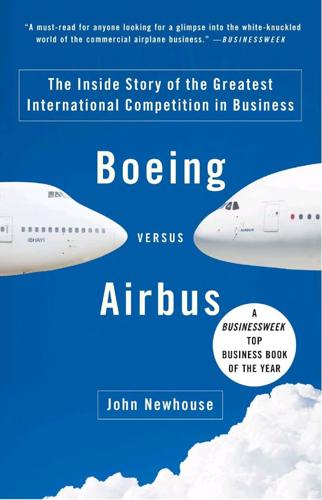
Boeing Versus Airbus: The Inside Story of the Greatest International Competition in Business
by
John Newhouse
Published 16 Jan 2007
CHAPTER SEVEN The Very Large Airplane AFTER THE AIRCRAFT industry’s downturn in the early 1990s, it appeared that the only new airliner likely to be built for the next several years would be a superjumbo. A much bigger airplane, the argument ran, would increase the number of passengers who could be flown between major urban centers connected by the hub-and-spoke airlines. Seat mile costs had to come down, and only the very large commercial transport—the VLCT as it was then labeled—would allow airlines to accomplish that, provided, of course, they could fill all those seats. The unknown but unavoidably huge cost of building the very large airplane, or VLA, as it was also known, was intimidating.
…
AIRBUS AND ESPECIALLY Boeing each gambled massively on two new airplanes that represent radically different approaches to the market. There is probably no precedent for such a divergence. The A380, because it can carry a huge number of passengers, is designed to fit within the hub-and-spoke pattern of air travel that the big airlines have favored. An A380 could take 550 passengers from Tokyo to, say, Los Angeles or New York, where many of them would then transfer to flights going to Denver, Phoenix, Cleveland, and so on. And, Airbus argues, this superjumbo airplane will be cheaper to operate than other aircraft, partly because it will burn less fuel per passenger.
…
Credit wasn’t a problem—there was a great deal of money chasing airplanes; airlines were borrowing 120 percent of the net purchase of their new aircraft. And they were busily expanding their hub airports. Airline deregulation, a useful step in principle, was never about building a strong industry; it was about lowering ticket prices by creating competition. And it did give rise to a commodity marketplace, hence competition. But most airlines either didn’t favor deregulation or, like Delta Airlines, openly opposed it. United Airlines, the nation’s largest carrier at the time, was the only strenuous advocate. The other big airlines had been reluctant to give up a regulated environment, which had offered an unstable industry protection against its prodigal tendencies.
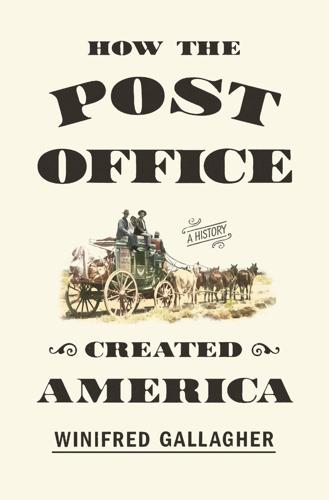
How the Post Office Created America: A History
by
Winifred Gallagher
Published 7 Jan 2016
(One of their first projects was building a fort, called the Campus Martius, to protect themselves from the understandably aggrieved Native Americans they sought to displace.) Marietta got a post office in 1794, but by the time of statehood in 1803, it was one of just eighteen in all of sprawling Ohio. Delivering a letter from the East Coast to Ohio required heroic efforts from the post. In 1800, Postmaster General Habersham inaugurated the “hub and spoke” circulation system, in which large, centralized “distributing post offices” sorted an entire region’s mail, then dispersed it to the spokes, or local “common” post offices, where the recipients retrieved it. Most of the new state’s postal facilities were strung along the great Ohio River or its tributaries, which were the best means of transportation in wild terrain and the inspirations for its early “river roads.”
…
The new Highway Post Offices that were installed inside some trucks and buses were slower, prey to traffic jams, and less efficient than the smooth-sailing Railway Post Offices had been; they swayed more, which made sorting more difficult and induced more motion sickness. The mail had to be processed somewhere, however, and the post was forced to return to its old hub-and-spokes circulation system centered on large regional distributing post offices. This back-to-the-future strategy worked reasonably well in the burgeoning suburbs and exurbs, where the big trucks could sail into giant new mail processing centers that were custom-built for the purpose and conveniently positioned just off the new freeways.
…
To curb the contractors’ profitable practice of flying junk mail, he changed the basis of their compensation to the size of a plane’s cargo space rather than the mail’s weight. Partly to sweeten this bitter medicine, he also offered the carriers ten-year rather than four-year contracts. In exchange for this added security, the airlines greatly expanded their routes at no cost to the government. The act also empowered Brown to extend or consolidate airmail routes as he saw fit. When the new postal contracts were awarded to just the three large airlines, later United, American, and TWA, that had been personally invited to attend what was dubbed the postmaster general’s “Spoils Conference,” the charge that the post was bankrolling cronyism and discriminating against the smaller carriers led to the sensational scandal of 1934.
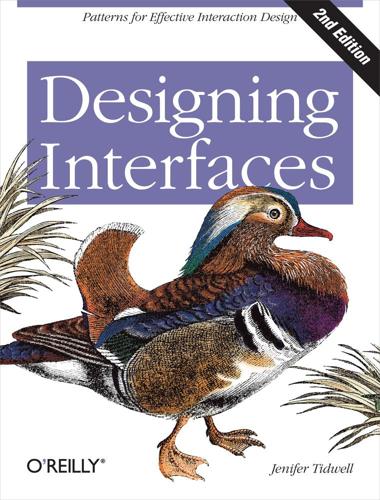
Designing Interfaces
by
Jenifer Tidwell
Published 15 Dec 2010
Now let’s look at a few models found in typical sites and apps: Hub and spoke Most often found on mobile devices, this architecture (Figure 3-1) lists all the major parts of the site or app on the home screen, or “hub.” The user clicks or taps through to them, does what she needs to do, and comes back to the hub to go somewhere else. The “spoke” screens focus tightly on their jobs, making careful use of space—they may not have room to list all the other major screens. The iPhone home screen is a good example; the Menu Page pattern found on some websites is another. Figure 3-1. Hub and spoke Fully connected Many websites follow this model.
…
Now, if these are pages that users can reach via search results, it’s doubly important that Figure 3-10 be put on each page. Visitors can click these to get to a “normal” page that tells them more about where they actually are. How Put a button or link on the page that brings the user back to a “safe place.” This might be a home page, a hub page in a hub-and-spoke design, or any page with full navigation and something self-explanatory on it. Exactly what it links to will depend upon the application’s design. Examples Websites often use clickable site logos as home-page links, usually in the upper left of a page. These provide an Escape Hatch in a familiar place, while helping with branding.
…
Getty Museum website, In other libraries global navigation, Navigational Models, Design Conventions for Websites, Why defined, Navigational Models Fat Menus pattern and, Why Liquid Layout pattern and, Design Conventions for Websites GNOME application themes., What This Means for Desktop Applications Good Defaults pattern, Deferred Choices, What, Use when, In other libraries, Why, Examples, In other libraries about, Use when, In other libraries, Why, Examples, In other libraries Deferred Choices pattern and, Deferred Choices New-Item Row pattern and, What Good website, Examples, Examples Google Analytics, Examples, In other libraries Google Books, Examples Deep-linked State pattern and, Examples Google Docs, How, Examples, Examples Center Stage pattern and, How Responsive Disclosure pattern and, Examples text editor, Examples Google Finance, Examples Google Labs, Examples Google Maps, What, Examples, Examples Alternative Views pattern and, What Datatips pattern and, Examples Escape Hatch pattern and, Examples Google News, What Vertical Stack pattern and, What Google Public Data Explorer, What Dynamic Queries pattern and, What Google Trends, Examples Google website, Examples, What Text Clear Button pattern and, What Thumbnail-and-Text List pattern and, Examples Grid of Equals pattern, How, Why, Repeated Visual Motifs about, How repeated visual motifs and, Repeated Visual Motifs Thumbnail Grid pattern and, Why Grooveshark website, Examples, Examples Hover Tools pattern and, Examples Progress Indicator pattern and, Examples Gunn, Tim, What H Habituation pattern, Habituation, Habituation, Habituation, Habituation Hairlines pattern, The Patterns about, The Patterns Hanna Andersson website, What Thumbnail Grid pattern and, What Henry, Ed, Examples HermitageMuseum.org website, What Home Link pattern, In other libraries Hotmail website, In other libraries Hsieh, Tony, What hub and spoke navigational model, Navigational Models Hulu website, Examples, In other libraries human behavior, A Means to an End, The Basics of User Research, Users’ Motivation to Learn, Users’ Motivation to Learn, The Patterns, Users’ Motivation to Learn, Users’ Motivation to Learn, Users’ Motivation to Learn, Users’ Motivation to Learn, Safe Exploration, Users’ Motivation to Learn, The Patterns, The Patterns, Safe Exploration about, Users’ Motivation to Learn, Safe Exploration, The Patterns, Safe Exploration basics of user research for, The Basics of User Research, Users’ Motivation to Learn, Users’ Motivation to Learn motivation to learn and, Users’ Motivation to Learn, The Patterns, Users’ Motivation to Learn, The Patterns tool usage and, A Means to an End, Users’ Motivation to Learn, Users’ Motivation to Learn I IA (information architecture), Use Cases for Lists list displays, Use Cases for Lists iBird Explorer, Examples iGoogle, Examples, Examples Image Browser pattern, In other libraries images, Images, Examples as backgrounds, Examples visual design considerations, Images Incremental Construction pattern, Incremental Construction about, Incremental Construction indicators, How, How, The Patterns, What, What, Examples, Examples dynamic, How Loading Indicators pattern and, What, Examples, Examples Progress Indicator pattern and, The Patterns, What static, How information graphics, The Basics of Information Graphics, Organizational Models: How Is This Data Organized?

Mapmatics: How We Navigate the World Through Numbers
by
Paulina Rowinska
Published 5 Jun 2024
Today, Anchorage is home to the hubs of giants such as FedEx, UPS and the United States Postal Service, where aeroplanes stop to refuel and sort the cargo, sending it on to correct destinations.* All that explains why, in April 2020, when commercial flights stopped almost entirely due to COVID-19 restrictions, and the shipping of goods bought online spiked, Anchorage became one of the world’s busiest airports – and, for one day, the busiest. Most major airlines – both commercial and cargo – work in a hub-and-spoke system, which means that their flights start or end in one of the hub airports, where passengers change to the connecting flight to their destination. For example, at the time of writing, the world’s busiest international airport is in Dubai. The biggest city in the United Arab Emirates is conveniently located along the great circles connecting London and Perth in Australia.
…
v=UMNfagIz0hs. between Singapore and New York: Ethan Klapper and Zach Griff, ‘The World’s Longest Nonstop Flights, Updated’, The Points Guy, 14 June 2023, https://thepointsguy.com/news/the-worlds-longest-nonstop-flights-updated/. the connecting flight to their destination: Kevin Bonsor, ‘How Airlines Work: Hubs and Spokes’, HowStuffWorks, 2001, https://science.howstuffworks.com/transport/flight/modern/airline3.htm. the world’s busiest international airport is in Dubai: ‘Busiest Airports in the World’, OAG, accessed 17 May 2023, https://www.oag.com/busiest-airports-world. the relatively small city of Helsinki, the capital of Finland: Becca Rowland, ‘Great Circle Routes & Flight Paths’, OAG, 6 November 2019, https://www.oag.com/blog/great-circle-routes-flight-paths.
…
By keeping the string tight, you ensure that the route is the shortest possible – and you’ll see that it’s exactly like a rainbow in Figure 1.9. FIGURE 1.9: The shortest path from Munich to San Francisco is an arc of a great circle. Airlines schedule their flights as close to great circles as possible because these are the shortest routes joining two points on the Earth. While actual routes will deviate from great circles to take advantage of strong winds, avoid difficult weather conditions and stay out of no-fly zones, they still don’t resemble the straight lines we’re so tempted to draw on a flat map. This explains why airlines sometimes place their hubs in rather surprising places. Flying through Alaska For one day, on 25 April 2020, the international airport in Anchorage, Alaska, became the busiest in the world.
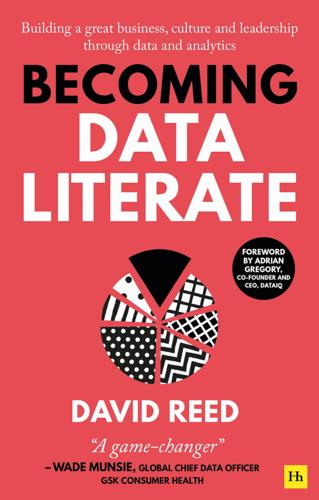
Becoming Data Literate: Building a great business, culture and leadership through data and analytics
by
David Reed
Published 31 Aug 2021
At one mobile network operator, 60% of analysts were embedded, taking part in line of business meetings as well as having their own team meetings. Their presence alongside stakeholders helps because it means they adopt the same ways of working. The downside of a non-centralised data function, whether federated or hub-and-spoke, is that it usually requires more management effort (and a degree of political skill) to maintain effectiveness and motivation. Meeting schedules can become congested where practitioners are also engaging with their stakeholder function, for example, while specific resources, such as digital platforms, may be blocked by the governance rules in regulated industries.
…
Table 2.1: Data offices within the organisation (%) Centralised or centre of excellence 43.2 Distributed or federated 27.0 Hub-and-spoke 13.5 Consulting 13.5 Other 2.7 Roles Translating tasks into roles Data and analytics tasks can be assigned to roles in a wide variety of ways, including by historical role definitions, specific skills, resource availability, urgency and so forth.
…
Elements of its activities may sit separately within lines of business, such as data engineering being part of IT, or as stand-alone functions, such as advanced analytics or data science. According to DataIQ research, while 34.5% of organisations have a centralised data department, the same percentage have federated data while 13.8% operate on a hub-and-spoke basis. That means nearly half of data teams (48.3%) could find themselves working alongside stakeholders rather than their own peers. Data science operates in a more consolidated way with 40.7% having a centralised function and 26.7% a team working within a centralised analytics function (see Figure 7.1).
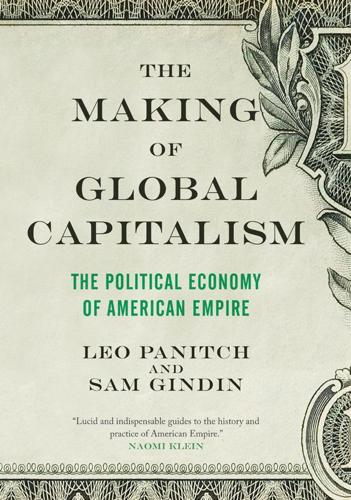
The Making of Global Capitalism
by
Leo Panitch
and
Sam Gindin
Published 8 Oct 2012
Indeed they usually became hostile to the idea of any such challenge, not least because they saw the American state as the ultimate guarantor of capitalist interests globally. The dense linkages binding these states to the American empire were also institutionalized, of course, through NATO and the hub-and-spokes networks of intelligence and security apparatuses between Washington and the other capitalist states. The containment of Communism, whether in the Cold War in Europe or the very hot wars in East Asia, was largely about ensuring that as many of the world’s states as possible would be open to the accumulation of capital.
…
According to Acheson’s account of the meeting, “On this main point there was no debate.”25 Since the US insisted on confining Marshall Aid to Western Europe, and was especially committed to reconstituting an economically viable West German state, the Truman Doctrine was designed to avoid making it look as if it was the US rather than the USSR that was responsible for dividing Europe.26 It heralded the new geopolitical and military links that came to bind the core capitalist states to the American empire. These links would soon be institutionalized—not only through NATO, but also through the hub-and-spokes network that linked other states’ intelligence and security apparatuses to those of the US. But American policymakers recognized that in Europe it was domestic left-socialist or Communist forces, whose popular support was likely to be increased in the context of the economic crisis, that were the main problem.
…
Integrating Europe The accelerated push towards economic and monetary union in the 1980s, emerging at a time when Europe was mired in internal stagnation, needs to be understood in the context of the continuing integration of European and American capitalism. The abandonment of the Bretton Woods framework, wherein all European currencies had been fixed in a hub-and-spokes relationship to the dollar, was initially compensated for by the European states adopting a “currency snake” designed to prevent competitive devaluations; but “the instability of the snake reflected the fact that the 1970s was a low point for European cooperation.”1 The formation of the European Monetary System in 1979—“the most significant development in the EC arising out of the long crisis from 1969 to 1983”—was the first major step towards the common currency, a development that the US did not oppose.2 What it was much more concerned about, even in the wake of the election that brought Mrs.
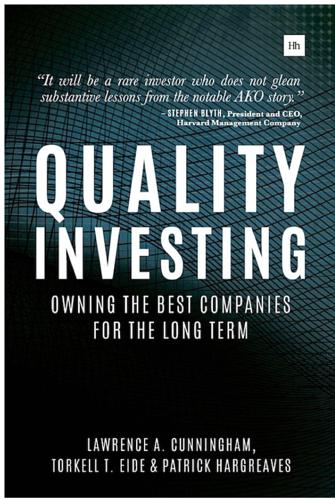
Quality Investing: Owning the Best Companies for the Long Term
by
Torkell T. Eide
,
Lawrence A. Cunningham
and
Patrick Hargreaves
Published 5 Jan 2016
In Germany, for example, despite global consolidation of industries from paint to beer, markets remain fragmented and competitive thanks to tenacious family-run mid-size firms. Other share donators are companies with entrenched cost or management structures that impair adaptability. The airline industry provided many examples: older airlines shackled by legacy costs, aging fleets, and the old hub-and-spoke business model fell prey to low-cost airlines delivering much cheaper point-to-point travel. Obviously, having sizable share donators among competitors does not in itself make a company great, but the advantage is worth analyzing and can add value to quality companies that are able to capitalize on it.
…
Concentration in any part of a company’s value chain harbors hidden risks that can degrade its economics. An example is the impact of Global Distribution Systems (GDS) on the airline industry. Through the 1990s, before the advent of direct internet distribution, GDS became the primary way customers bought airline tickets. Although begun by the airlines, GDS became the gateway to a vast network of travel agents, who along with travelers were the ultimate beneficiaries. While airlines have recovered some ground through direct internet sales from their websites, GDS still generates more than 60% of bookings and 70% of revenues.
…
The more routine low-cost tactics give only short-term advantages because they can be copied. For example, pallets – portable wooden packing platforms – were first used for stocking merchandise in deep-discount retailers but are now a common sight at many supermarkets. Low-cost airlines like Southwest pioneered shorter aircraft turnaround times, but traditional airliners soon followed suit. In contrast, low-cost squared companies construct a business model, organization, and culture that drives low cost in each step of every process throughout the operation. The depth of cost consciousness adds protection that ordinary cost-minimization tactics do not.

The Seventh Sense: Power, Fortune, and Survival in the Age of Networks
by
Joshua Cooper Ramo
Published 16 May 2016
Baran traveled the country for most of 1961 and 1962, classified presentation and slide rules in hand, trying to persuade skeptical generals and engineers. It was a nearly impossible task. He recalled a visit to the towering AT&T switching headquarters on Broadway in lower Manhattan, an implacable temple of the high priests of hub-and-spoke network design. That one building handled more telephone and telex traffic than nearly any other single point on earth. No doubt the place ranked very high on Moscow’s first-strike list. So Baran expected a friendly reception. After all, he’d be telling a bunch of men with a uranium death sentence that he’d found a way to get them off the Soviet target plan.
…
Every block of stone has a sculpture inside it, Michelangelo once said, and it is the task of the sculptor to discover it. Every network has a topology. It is the task of every general or trader or entrepreneur to discover and use it. Topologies linger everywhere there is connection. Though networks can be designed in countless ways, they all have topologies. The fishnets of Baran, the hub and spokes of a data center, the ever-changing mesh of a trading system, are maps of connection. As a result, the risk that lingers in any one place in the system also exists in nearly any other linked place. Constant connection produces, as an unsettling result, constant threat. Topology is not marked out merely by a description of how we connect.
…
The race for speed lights something competitive: The faster I go, the faster you feel you need to go, the more powerfully you feel your slowness. The centripetal charm of acceleration, the way that speed attracts us and then makes us demand even more speed, honestly surprised the earliest architects of steamships and rail and airlines and roads. They underguessed how popular their tools of space–time compression would be. Surely the maximum number of people who would ever want to zip from L.A. to New York would be about a thousand per week, jet airline pioneers assumed. Would more than a few hundred engineers really want their own computers? Gordon Moore asked at a dinner party shortly after Intel proposed putting his chips in the first PCs.

The Future Is Asian
by
Parag Khanna
Published 5 Feb 2019
Mao’s victory in China prompted many US lawmakers to urge President Harry Truman to adopt an “Asia First” strategy aimed at containing the advance of communism in East Asia. The United States committed to stationing more troops in Japan and South Korea, continued to deploy its navy to deter mainland aggression against Taiwan, and established the ANZUS Treaty with Australia and New Zealand in 1951. The United States’ “hub-and-spoke” alliance system became the scaffolding of Asian order. The US military also surged into Southeast Asia. In Vietnam, the United States had provided covert support for the nationalist Ho Chi Minh’s forces to oust the Japanese from the country’s north. Upon declaring independence from France in 1945, Ho Chi Minh had hoped for continued US support, but the United States instead assisted the colonial French army in the south, which sought to preserve the Indochinese Federation.
…
Its historical posture across the region is fading, not least because US leaders and society want to avoid overstretch and entanglements. In West Asia, the failures of policy in Iraq, Afghanistan, and Syria have demonstrated the limits to US influence, costing the country substantial credibility. In East Asia, the “pivot to Asia” failed to materialize as a successor to the Cold War hub-and-spoke alliance system, especially as the United States abandoned the Trans-Pacific Partnership (TPP) trade deal. Asians still hold the United States to be important but also feel that it is unpredictable and even incompetent. The United States’ justifications for remaining tethered to East Asia are weakening due to the incremental reconciliations under way.
…
The British Rolls-Royce has an entire supply chain for jet engine production spread across Southeast Asia. Since the Commercial Aircraft Corporation of China (COMAC) is still a long way from competing with Boeing and Airbus, both Western aircraft manufacturers depend heavily on rising orders from Gulf carriers such as Emirates and Asia’s other large carriers such as Turkish Airlines, Singapore Airlines, and Chinese and Japanese carriers. China will surpass the United States as the world’s largest domestic aviation market by 2024, with approximately 1.3 billion travelers per year versus 1.1 billion in the United States.53 By that time, India is projected to reach 450 million annual air travelers, Indonesia will account for 250 million, and Vietnam 150 million.
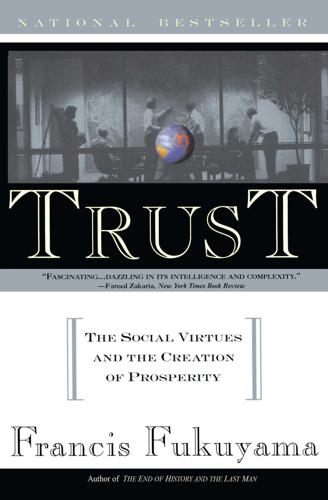
Trust: The Social Virtue and the Creation of Prosperity
by
Francis Fukuyama
Published 1 Jan 1995
Some observers note that many of the problems that emerged after Fred Wang took over the company were actually the result of his father’s management style. An Wang remained a highly autocratic CEO, unwilling to delegate authority. In 1972, when the company already had 2,000 employees, 136 people reported to him directly.3 An Wang was energetic and capable enough to make this typically Chinese hub-and-spoke management system work, and in some respects it increased esprit de corps throughout the company. But this management system is exceedingly difficult to institutionalize and hastened the company’s decline when the elder Wang retired. We will see these management practices repeated throughout the Chinese business world.
…
Under first-generation entrepreneur-managers, even if the business prospers and grows to a large scale, there is often no effort to move to a modern management system with a formal division of labor, a managerial hierarchy, and a decentralized, multidivisional form of organization. The company remains organized according to a highly centralized hub-and-spoke system, with the organization’s various branches all reporting directly to the founding entrepreneur.39 Chinese management style is frequently described as personalistic—that is, rather than relying on objective performance criteria, personnel decisions are made on the basis of the boss’s personal relations with his subordinates, even if they are not relatives.40 The second stage in the evolution of the family firm—assuming the business has been successful—occurs on the death of the founding patriarch.
…
Japan came to have one of the lowest percentages of family ownership (in terms of total market capitalization) among the industrialized countries, with only fourteen percent of all equity being owned by families or individuals in 1970.23 While Japanese industry is highly concentrated, ownership is much less so. Most Japanese corporations are owned by other institutions: pension funds, banks, insurance companies, and other corporations (particularly within the company’s own keiretsu, where cross-shareholding is commonly practiced). As they grew in scale, Japanese companies also abandoned the hub-and-spoke system of organization prevalent in many family-managed businesses for a hierarchical, multidivisional table of organization. The widespread use of professional managers even in preindustrial times has allowed the Japanese to create extremely durable economic organizations. The roots of the Daimaru department store chain go back a couple of centuries to the Shimomura family, and the Mitsui and Sumitomo keiretsu are even older.

Design of Business: Why Design Thinking Is the Next Competitive Advantage
by
Roger L. Martin
Published 15 Feb 2009
For a particularly stark example, think of the U.S. airline industry. The incumbent airlines—American, Delta, United, Northwest, and Continental—were so busy benchmarking against one another and honing the existing model that an upstart airline was able to reconfigure the industry by reimagining the entire flying experience. It cast aside the hub-and-spoke route system in favor of point-to-point direct flights and wooed travel-battered fliers with low prices, direct booking, and friendly staff. That upstart was Southwest Airlines, and today it flies more passengers per year than any other American airline. Before the recession hit in the first quarter of 2009, it had reported seventy consecutive profitable quarters, more than seventeen years of positive performance.
…
Before the recession hit in the first quarter of 2009, it had reported seventy consecutive profitable quarters, more than seventeen years of positive performance. The legacy airlines have not fared as well, to say the least. The bias toward reliability infects even corporate R&D departments, which you might think would be havens for design thinkers. But in cultures where status and rewards flow to reliability’s champions and the exploration of mysteries is frowned on, R&D departments tilt toward the “D” part of their mandate and skimp on the “R.” The great coup of P&G’s Connect + Develop initiative was to exploit that natural inclination in order to beef up its design-thinking capacity.
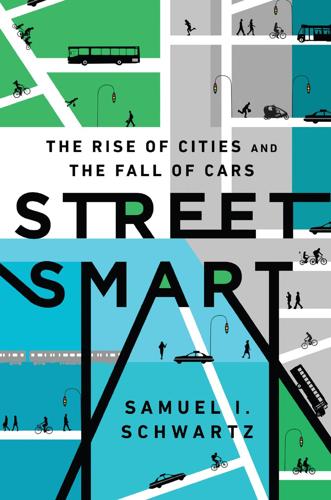
Street Smart: The Rise of Cities and the Fall of Cars
by
Samuel I. Schwartz
Published 17 Aug 2015
In a centralized system, the transportation nodes tend to concentrate in—no surprise—the center, and are linked in the same way that the outer edge of a wheel connects to the hub, by transport “spokes.” In a city or town with a single downtown, a map of the highest-capacity linkages—streets and roads, for example—would look like a hub-and-spoke, since most trips are from the periphery to the center. Many cities built before the late nineteenth century look a lot like this. But beginning with the growth of mechanized transportation, especially the first streetcars, cities started to adopt a grid pattern, in which streets meet at right angles.
…
Moreover, none of its ten bucolic villages has a Walk Score that exceeds 36. Connectivity has become an even more acute problem in the twenty-first century than in the twentieth, since fewer and fewer urban areas are truly concentrated enough to take advantage of the transportation efficiencies of a hub-and-spoke system. Though millions of commuters will continue to commute from outlying suburbs to Manhattan for a very long time, clustering is far more prevalent than centralizing. Whether within a medium-sized city like Columbus, or a megalopolis like Los Angeles, travel is just as likely to occur between the northwest quadrant and the southwest, as it is from either to the center.
…
However, attractors often got concentrated decades or centuries before contemporary planners started work; the planners don’t get to choose where attractors go. Lots of cities still have a traditional, single, prime destination—usually the original central business district, as with Boston, Massachusetts—and can satisfy many transportation needs with a traditional hub-and-spoke system. Paris, whose twenty arrondissements are laid out in a spiral, is a prime example of a radial spiderweb. Within the city’s core, the Metro lines circle the hub, while the city’s eight tram lines orbit the core—the T3 tramway alone carries riders on thirty million trips annually—and intersect inbound transit spokes.

Super Continent: The Logic of Eurasian Integration
by
Kent E. Calder
Published 28 Apr 2019
The United States and Eurasia In the end, the most critical uncertainty of all for Eurasian continentalism could be the American response to developments on the world’s oldest and largest continent. As the world’s preeminent superpower for most of the past seventy years and more, the United States has long held the capacity to shape events and institutional developments at various levels throughout the world. And one significant consequence of its global sway was to reinforce a “hub and spokes” of alliance relations that arguably inhibited the evolution of competing intra-Eurasian ties. Over the past forty years an America beset by globalization has begun to change in historic ways. Labor unions organize a smaller and smaller share of the American work force, with that share declining from 20 percent in 1983 to less than 11 percent in 2017.77 Income inequality is also rising sharply— in 1980 the top 1 percent of Americans earned on average 27 times more than the bottom 50 percent.
…
Yet it has rarely been able to respond effectively in cases of great-power conflict or to provide effective representation for nations that rose to renewed international prominence from the ashes of World War II defeat, such as Japan and Germany. Due in part to the inability of the UN to respond adequately to major global security challenges, the postwar security order also came, from the late 1940s on, to include a complex system of bilateral and multilateral alliances. In the Pacific, the US established a “hub-and-spokes” system of bilateral ties radiating out from its Washington hub, involving Japan (1951), Australia and New Zealand (1951), the Philippines (1951), and South Korea (1953).3 Nationalist China and South Vietnam, representing the anticommunist protagonists in continuing civil wars, were also included in the original framework Toward a New World Order 209 of bilateral ties, although those alliances later became defunct.4 Thailand was incorporated multilaterally through the 1954 Manila Pact establishing the Southeast Asia Treaty Organization (SEATO) and bilaterally through a 1966 US-Thai Treaty of Amity and Economic Relations.5 The Soviet Union and China also in February 1950 concluded a bilateral alliance with one another, nominally directed against Japan, which paralleled the emerging American structure.6 North Korea and the Soviet Union concluded a mutual-assistance treaty in 1961, while Vietnam also signed a Treaty of Friendship and Cooperation with the USSR following its accession to the Council for Mutual Economic Assistance in 1978.7 In the Atlantic, the Middle East, and the Americas, the prevailing postwar security structure ultimately became multilateral rather than bilateral.
…
It will likely persist in most of its European redoubts, but even there, in some of the newer democracies, it may be in danger.5 More pervasive is likely to be the “Beijing consensus” that economic development should be strongly prioritized over civil liberty.6 Certainly “distributive globalism” promotes this outcome, since it magnifies the geo-economic advantages of China’s geographic centrality in Eurasia by interconnecting the continent. Should Eurasian continentalism continue to deepen, as the analysis presented here suggests, and the autonomous role of the continent to rise, strongly influenced by China, the enduring post–World War II pattern of US global hegemony accompanied by a hub-and-spokes pattern of bilateral alliances centered on Washington, DC, could well be decisively compromised. In the short run, that would probably not have radical systemic consequences, as China would be loath to challenge the prevailing system directly or to impose a rule-based alternative of its own. More likely, as we have suggested, distributive globalism will grow more salient, in accordance with which China provides concrete, stabilizing benefits to key actors as the BRI itself proposes.
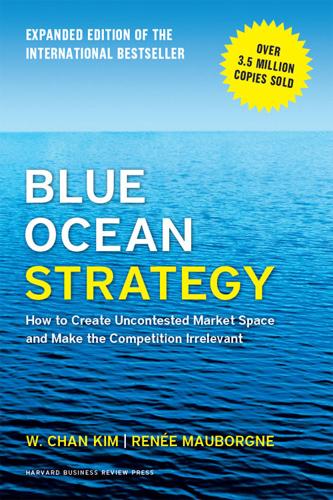
Blue Ocean Strategy, Expanded Edition: How to Create Uncontested Market Space and Make the Competition Irrelevant
by
W. Chan Kim
and
Renée A. Mauborgne
Published 20 Jan 2014
By applying the four actions of eliminating, reducing, raising, and creating, they differentiate their profiles from the industry’s average profile. Southwest, for example, pioneered point-to-point travel between midsize cities; previously, the industry operated through hub-and-spoke systems. Compelling Tagline A good strategy has a clear-cut and compelling tagline. “The speed of a plane at the price of a car—whenever you need it.” That’s the tagline of Southwest Airlines, or at least it could be. What could Southwest’s competitors say? Even the most proficient ad agency would have difficulty reducing the conventional offering of meals, seat choices, lounges, and hub links, with standard service, slower speeds, and higher prices into a memorable tagline.
…
Instead it can be created at the high end, as Cirque du Soleil, Starbucks, or Dyson did; at the low end, as Southwest Airlines or Swatch did; or in the middle range of a market. Even where blue oceans are created at the low end, as in the case of Southwest Airlines or Swatch, which have among the lowest price points and cost structures in the airline and watch industries, respectively, ask yourself, do you think of these as low cost alone? If you are like most, your answer is no. True, they are low cost and low priced, but they also stand out and are clearly differentiated in the eyes of buyers. Southwest Airlines stands out for its friendly, fast, ground-transportation-in-the-air feel, while Swatch’s stylish, fun designs set it apart and make it a fashion statement.
…
The four actions of creating a new value curve should be well guided toward building a company’s strategic profile with these characteristics. These three characteristics serve as an initial litmus test of the commercial viability of blue ocean ideas. A look at Southwest Airlines’ strategic profile illustrates how these three qualities underlie the company’s effective strategy in reinventing the short-haul airline industry via value innovation (see figure 2-6). Southwest Airlines created a blue ocean by breaking the trade-offs customers had to make between the speed of airplanes and the economy and flexibility of car transport. To achieve this, Southwest offered high-speed transport with frequent and flexible departures at prices attractive to the mass of buyers.

Click Here to Kill Everybody: Security and Survival in a Hyper-Connected World
by
Bruce Schneier
Published 3 Sep 2018
When we pair phones with cars, for example, we are authenticating each to the other and enabling the devices to communicate without our involvement after that. But that is only feasible if there are only a few devices that need to pair. When we have thousands of devices that need to communicate with each other, it will be impossible for us to manually pair all of them. And while the hub-and-spoke model of having all authentication going through central authorities—like our smartphones—will solve some of this, it won’t solve all of it. Attacks will have serious consequences. If I can impersonate you to your devices, I can take advantage of you. This is the identity theft of the future, and it’s scary.
…
Abbott Labs, 38, 41 Access Now, 214 accountability, 112, 128, 147 ACLU, 223 ad blockers, 16 African Union, 89 airline safety, 144 airplanes: bugs in, 41 remote control of, 1–2, 16 air traffic control, 210 Alexa (Amazon’s virtual assistant), 4, 61 Alexander, Keith, 118 algorithms: accurate inputs required by, 84 autonomous, 7, 82–87 data needed by, 84 hacking of, 83–84 machine learning, 82–83, 85, 111–12 physical agency of, 83 and robots, 86–87 security standards for, 111–12, 148 speed of, 84–85 Alibaba website, 169 Alphabet (Google’s parent company), 57 Alphonso, 58 Amazon, 57, 61, 62 Amnesia IoT botnet, 37 Amnesty International, 223 Anderson, Ross, 185 Andromeda botnet, 52 Angry Birds, 58 anonymity, 52, 53, 110, 199–200 Apple, 57, 60, 78, 174, 196 Applied Cryptography (Schneier), 32 Arab Spring, 67 arbitration agreements, 129 Arthur Andersen, 127 artificial intelligence (AI), 7, 86–87, 95, 148, 149, 219 Ashley Madison, hacking of, 78 AT&T, 113 Atomic Energy Commission (AEC), 149 attack vs. defense, 160–79 attack as US priority in, 73 attack easier than defense, 219 attacks changing in, 32–33 “defense dominant” strategy, 160 design for security vs. surveillance, 167–70 fixing vulnerabilities in, 162–67 in law enforcement, 173–76 offensive autonomous attack software, 85 and relationship between government and industry, 176–79 security as, 10, 16, 26–28 zero days in, 162, 163, 165 attribution, 52–55 in cyberattacks, 72, 203 detection evasion, 55 main points of, 54 authentication, 45–51 continuous, 47 differential, 47, 49 hub-and-spoke model of, 50 and identification, 51 and identity theft, 50–51, 171 and impersonation, 51 in Internet+, 49–51 methods of, 46 standards of, 109, 169 trade-off between security and usability in, 47 two-factor, 47, 49, 200 automobiles: aging, 39–40 bugs in, 41 driverless, 4, 205 industry regulation of, 182, 186 international markets for, 186, 187 Internet connection in, 6 manufacturer support of, 39–40 remote hacking of, 1, 3, 16 repair manuals for, 139 safety of, 139, 182 security standards for, 151 availability, attacks on, 78–82 Azimuth, 162 baby monitors, 133–35 backdoors, 26, 87, 88, 172, 174, 193–98, 220 Baker, Stewart, 204 balkanization, 157 banks, data manipulation attacks on, 81–82 Baratov, Karim, 30 Beckstrom, Rod, 19 Belan, Alexsey, 30 Bell, Alexander Graham, 152 best efforts, 122 Beyond Fear (Schneier), 211 “big data,” 57 biometrics, authentication via, 46, 47 Bismarck, Otto von, 220 bitcoin, 15, 74, 75, 77, 198, 218 blackouts, 29, 90 Blade Runner (film), 218 Blaster worm, 94 Bluetooth, 50, 58, 79 Bohm, Nick, 220 Border Gateway Protocol (BGP), 22, 23, 24, 115 Boston Marathon bombing (2013), 95, 202 Boston MBTA, 42 botnets, 26, 75, 77, 95, 139 Bowman Dam, Rye, New York, 79 breach disclosure laws, 137–38 bribery, 183 Brightest Flashlight, 58 BT, 113 Buckshot Yankee, 66 Budapest Convention on Cybercrime, 157 buffer overflow bug, 21 bug bounties, 36 bugs, 20–21, 41 CALEA (Communications Assistance for Law Enforcement Act) [1994], 168, 170 California, “Teddy Bears and Toasters” bill in, 187–88 Calo, Ryan, 149 Cameron, David, 197 Campos, Hugo, 63 CAN-SPAM Act (2003), 154 Caproni, Valerie, 193 “Capture the Flag” (hacking sport), 85 Carbon Black, 74 Carson, Rachel, Silent Spring, 183 caveat emptor, 131 Cellebrite, 174 cell towers, 32–33 fake, 168–70 Center on Privacy and Technology, 224 CEO fraud, 75 Challenger, 29 Check Point (Israeli company), 87 Cheney, Dick, 76, 93, 94 Chertoff, Michael, 198 Child Online Protection Act (1998), 154, 192–93 child porn, 183 China: and African Union headquarters, 89 censorship in, 67–68 and cybercrime law, 156, 158 cyberespionage by, 66, 67, 81 eavesdropping on communications, 195–96 hacking by, 45 intellectual property theft by, 66, 72–73 social control in, 67–68 China Telecom, 113 chips: general-purpose, 6 vulnerabilities in, 21 CIA, 73, 77, 165–67 Cisco Internet switches, 170 cities, smart sensors in, 4, 6 Citizen Lab, 64 Clapper, James, 66, 81 Clark, David, 23 class-action lawsuits, 129 class breaks: hacking via, 33, 95 use of term, 31–32 click fraud, 16, 75 cloud computing, 7, 190 Code for America, 223 Cogent ISP, 115 Cohen, Julie, 154 Comcast, 62, 113 Comey, James, 193–94 Commission on Enhancing National Cybersecurity, 180–81 complexity, 11, 27 and accidents, 80 theory of, 210 and unpredictability, 211 Computer Fraud and Abuse Act (1986), 42 computers: extensibility of, 24–26 as ubiquitous, 1–5, 19 vulnerabilities in, 30–32 confidentiality, threats to, 78–81 Consumers Union, 136, 145 copy protection, 25, 41, 62, 131, 154, 155, 205 Core Infrastructure Initiative, 115 corporations: CEO fraud in, 75 consumers controlled by, 59–64 data sought by, 57 infrastructure controlled by, 117 insecurity favored by, 56 profit maximization by, 118 regulation evaded by, 154–55 surveillance capitalism in, 57–59, 65, 209 CrashOverride, 2, 4–5 credential stealing, 45–47 credit card fraud, 16, 100 crime rate, public toleration of, 92 crimeware-as-a-service (CaaS), 76 cryptanalysis, differential, 33 cryptocurrencies, 172, 198 Cuban Missile Crisis (1962), 95 “cyber,” as umbrella term, 183–84 cyberattacks, 68–74, 116, 203, 217 Cyberbit (Israel), 65 cybercrime, 74–77, 156, 158 cyberdefense: “active,” 203 national agency for, 148 cyberespionage, see espionage Cyber Grand Challenge, 85 cyber incident data repository, 177 cyber peace, 213–14 cyberphysical systems, 7 cyber resilience, 211–12 cybersecurity, see Internet+ security Cybersecurity Improvement Act (2017), 180, 208 Cyber Shield Act (2017), 136 cyberstalking, 76 Cyber Threat Alliance, 177 cyberwar, 68–74 arms race in, 73, 116, 212–14 attribution in, 72 autonomous weapons in, 86 cyberespionage vs., 72 cyber mercenaries in, 70 limited response in, 71 “preparing the battlefield,” 69 and unpeace, 71–74 cyberweapons: in armed conflict, 72 autonomous, 86 instability of, 72, 212 manufacturers, 65 nonproliferation standards for, 158 theft of, 73 Daniel, Michael, 164 Darknet, 198 DARPA (US Defense Advanced Research Projects Agency), 85 data: accuracy of, 84 in adversarial machine learning, 84 anonymity of, 110 as byproduct, 57 “Collect it all,” 118 deletion of, 110 encryption of, 109, 171 integrity of, 80, 81, 109 jurisdiction over, 146 limits on collection of, 109 metadata, 174 natural bias of, 84 ownership of, 109 personal, control of, 62–63, 64, 109–11 sharing of, 177–79 storage and processing of, 174 Data and Goliath (Schneier), 110, 172 databases: encryption of, 171 threats to, 79, 80, 81 data brokers, 58 Data Encryption Standard (DES), 32, 33 DDoS (distributed denial-of-service) attack, 29, 130, 202 Deepwater Horizon disaster, 124 “defense dominance,” 160 see also attack vs. defense Democratic National Committee, Russian attacks on (2016), 30, 45, 78, 80 denial of service, 29, 79, 81, 130, 202 Department of Homeland Security, 117, 138 Derechos Digitales, Chile, 214 detection evasion, 55 Digital HKS, Harvard, 224 Digital Millennium Copyright Act (DMCA), 41–42, 62, 154, 193, 205–6, 220 digital rights management (DRM), 25, 62, 205 Digital Security Helpline, 214 DNSChanger malware, 37 Doctorow, Cory, 163 Dodd-Frank Act (2010), 126 Domain Name Service, 24, 115 security (DNSSEC), 24 domino effect, 210 “Don’t Panic,” 174 drones, 7, 80, 91, 95, 151, 200 Dyn, botnet attack against, 94, 202 Edgehill program (UK), 168 Electronic Communications Privacy Act (1986), 153 Electronic Frontier Foundation, 32, 223 Who Has Your Back?
…
Something fails, and the plane crashes. Common sense says that it’s super risky. Airlines compete with each other on all sorts of attributes. They compete on price and routes. They compete on seat pitch and legroom. They compete on amenities in their premium cabins. They compete on nebulous “feel good” emotions with evocative branding. But they don’t compete on safety. Safety—and security—is set by the government. Airlines and airplane manufacturers are required to comply with all sorts of regulations. And it’s all invisible to the consumer. No airline ever touts its safety or security records in advertisements. But every time I board a plane—182 times in 2017—I know that the flight will be safe.
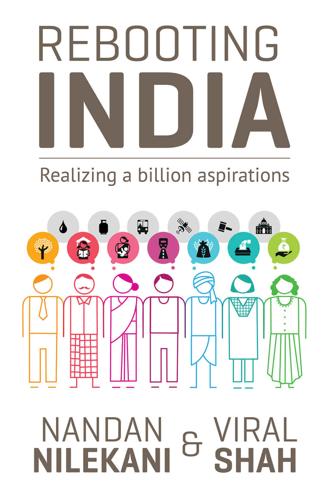
Rebooting India: Realizing a Billion Aspirations
by
Nandan Nilekani
Published 4 Feb 2016
We envision the EIN as an entity set up along the lines of a hub, with every participating entity being a spoke. Unlike a linear model, the hub-and-spoke system allows for the free flow of information among entities, whether it’s the central government or a gram panchayat. Delays and blocks can be flagged as soon as they arise; since every player in the system is aware of the problem, the impetus towards a speedy resolution is all the greater. The hub-and-spoke model also allows for asynchronous rollout, as we discussed in the case of Aadhaar, where different government bodies come on board at their own pace.
…
Once the EIN is implemented, info rmation from the last mile—details of how government money is actually being used on the ground—can be uploaded by states and government departments at their own pace. This asynchronous design will allow a complete picture of outcomes in the field to be built up over time. The hub-and-spoke model we propose combines transparency with accountability and makes expenditure information freely available, opening up endless possibilities for utilizing this data. We can build our own transparency portals to track local spending; both the government and interested citizens can combine available data to come up with new and interesting insights, and third-party developers can create apps that leverage this information to provide a better customer experience.
…
When an electronic trade is completed, the shares are automatically transferred from the seller to the buyer. Similarly, our bank accounts have largely become paperless. We no longer write cheques or money orders but make payments digitally. We no longer have to receive bank statements by post. We no longer buy railway, bus or airline tickets in a paper format. We buy insurance policies online and the insurance certificates are often in electronic form. Today, many banks have started offering loans online with an electronic approvals process, possible because a person’s financial history and credit score are accessible online for the bank to scrutinize.
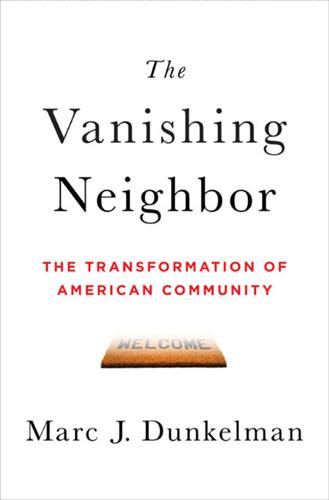
The Vanishing Neighbor: The Transformation of American Community
by
Marc J. Dunkelman
Published 3 Aug 2014
What replaced the Elks Club and the bowling leagues were more typically organs of the outer rings. Newer institutions tended to bring together individuals who, outside one point of contact, were less likely to be mutually familiar. In lieu of forming semiautonomous local chapters, national groups now more embraced a hub-and-spoke model, where organizers headquartered in Washington or elsewhere would reach out directly to members. The one-time supposition that members would attend a regularly scheduled tea was replaced by the request that members send donations designed to fund the work of professional staffers, who would then carry the banner.
…
And the efficiencies of our new capacity to harness information technology offer a window onto what could be another major transformation. The question is whether we can reverse-engineer the magic of township relationships into connections among the nation’s care providers. Today, in all too many cases, those in need are given help through a hub-and-spoke system: each is directly connected to the “patient,” but few are rarely, if ever, connected to one another. While that kind of system might have worked well during an earlier era, it stifles the efficiencies and innovations that might be harnessed by ensuring familiarity among those who are serving the same population.
…
Certainly the dichotomy couldn’t be chalked up to some blithe complaint about social isolation. Far from losing touch, technology had worked to connect Americans like never before. Over the course of a single generation, the cost of a telephone call had fallen dramatically.3 E-mail had emerged as an entirely new, free, and instantaneous form of communication. And with budget airlines driving the price of air travel down, families living hundreds of miles away could visit one another with much more regularity. My erstwhile comparisons of Cincinnati and Buffalo seemed to suggest that, amid all the new opportunities to connect, something else had been lost. The sorts of relationships my grandparents had taken for granted while raising their children—between neighbors and colleagues, often across generations—had withered, and others had begun to take their place.

Smart Cities: Big Data, Civic Hackers, and the Quest for a New Utopia
by
Anthony M. Townsend
Published 29 Sep 2013
The fable begins in the early 1960s with the publication of “On Distributed Communications” by Paul Baran, a researcher at the RAND think tank. At the time, Baran had been tasked with developing a scheme for an indestructible telecommunications network for the US Air Force. Cold War planners feared that the hub-and-spoke structure of the telephone system was vulnerable to a preemptive Soviet first strike. Without a working communications network, the United States would not be able to coordinate a counterattack, and the strategic balance of “mutually assured destruction” between the superpowers would be upset.
…
But the research community was hooked, so plans were made to hand over control to the National Science Foundation, which merged the civilian portion of the ARPANET with its own research network, NSFNET, launched a year earlier. In July 1988, NSFNET turned on a new national backbone network that dropped the redundant and distributed grid of ARPANET in favor of a more efficient and economical hub-and-spoke arrangement.20 Much like the air-transportation network today, consortia of universities pooled their resources to deploy their own regional feeder networks (often with significant NSF funding), which linked up into the backbone at several hubs scattered strategically around the country. Just seven years later, in April 1995, the National Science Foundation handed over management of the backbone to the private sector.
…
Much like the management crisis created by the spread of railroads a century before, airlines couldn’t keep up with the acceleration of commerce they were enabling. After a chance encounter on a long flight in 1953 between C. R. Smith, the president of American Airlines, and a young IBM salesman, IBM began planning a replacement for the company’s archaic paper-based ticketing system.23 By 1960, drawing directly on its work in the mid-1950s building the massive SAGE (Semi-Automatic Ground Environment) air-defense computer system for the United States Air Force, IBM installed the eponymous SABRE (Semi-Automatic Business Research Environment) for the commercial airline. For the first time, travel agents could call into a specially designed computer center where airline reps could instantly browse available seats.
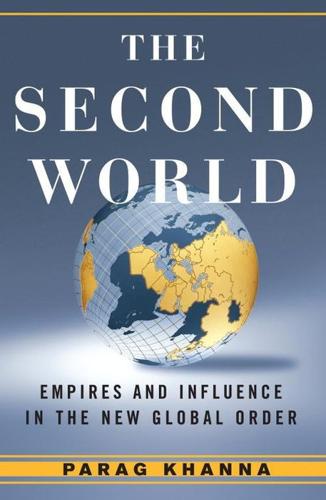
Second World: Empires and Influence in the New Global Order
by
Parag Khanna
Published 4 Mar 2008
This used to be called imperialism—but the new term for it is globalization. The United States, the EU, and China represent three distinct diplomatic styles—America’s coalition, Europe’s consensus, and China’s consultation—competing to lead the twenty-first century. During the Cold War, America’s anticommunist Truman Doctrine created robust “hub-and-spoke” alliances, as Prussia had in the nineteenth century.12 By contrast, its current “coalitions of the willing” style of conducting foreign policy negotiates diplomatic alignments on a transactional, issue-by-issue basis. America continues to demonstrate its eagerness to lead: It sets the tone in the UN Security Council and NATO, which commands operations well beyond its original European mandate into the Persian Gulf and Central Asia, and troubleshoots many disputes worldwide.
…
For Spykman, in contrast to Mackinder’s thesis that the Central Asian heartland is the pivot of global power, the Eurasian coastal region stretching from the Persian Gulf around the Indian subcontinent to the Pacific Rim is the most important zone of industrial and population growth. He thus revised Mackinder’s famous epigram about the heartland: “Who controls the Rimland rules Eurasia; who rules Eurasia controls the destinies of the world.”9 During the Cold War, America’s outside-in system of “hub-and-spoke” alliances with Australia and New Zealand (known as ANZUS), Japan, South Korea, Singapore, and the Philippines discouraged regional cooperation, and America still has strong bilateral economic ties to East Asian states (which account for 40 percent of its total trade)—specifically signing free trade agreements with most of China’s neighbors with the aim of maintaining their loyalty.
…
But European agro-technology ensures that Romania, something of a European Appalachia, can move from a peasant collective to a breadbasket for the region as well as a hub for low-cost industry beyond its trademark AK-47 assault rifles.4 Similarly, the EU’s threats of admission delays coaxed even perpetually schizophrenic Bulgaria to break up organized crime and human trafficking rings to qualify for billions in desperately needed subsidies.5 With the EU stamp of approval, Bulgarians are returning to work in refurbished factories, and Euro-hippies flock by car or on low-cost airlines to its Black Sea beaches. “Bulgaria is the new Costa del Sol!” a British tourist in Burgas chimed. Given the historical instability of the Balkans, the European empire will remain incomplete and vulnerable until the “Eastern Question” that vexed European statesmen a century ago is settled. Fortunately, the total population of the remaining western and southern Balkan countries—Serbia, Bosnia, Croatia, Macedonia, Albania—does not even add up to that of Romania, with no country larger in population than Manhattan.
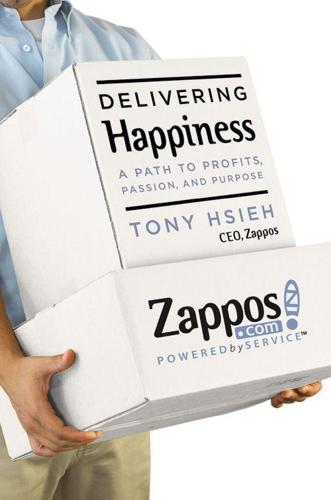
Delivering Happiness: A Path to Profits, Passion, and Purpose
by
Tony Hsieh
Published 6 Jun 2010
I realized that, whatever the vision was for any business, there was always a bigger vision that could make the table bigger. When Southwest Airlines first started, they didn’t see their target market as limited to just existing airline travelers, which was what all the other airlines did. Instead, they imagined their service as something that could potentially serve all the people who traveled by Greyhound bus or by train, and they designed their business around that. They offered short flights at cheap prices, instead of going with the more prevalent “hub and spoke” model that other airlines were using. They made it easy for customers to change flights without paying huge penalties.
…
We decided that we wanted to build our brand to be about the very best customer service and the very best customer experience. We believe that customer service shouldn’t be just a department, it should be the entire company. Advertising can only get your brand so far. If you ask most people what the “brand” of the airline industry as a whole is (not any specific airline, but the entire industry), they will usually say something about bad customer service or bad customer experience. If you ask people what their perception of the US auto industry is today, chances are the responses you get won’t be in line with what the automakers project in their advertising.
…
They made it easy for customers to change flights without paying huge penalties. And they turned their planes around at airports as fast as possible. They succeeded because they decided to play at a different table than the one that all the other airlines were playing at. Over a period of several months, I learned a lot about poker, but toward the end I started getting bored with playing in the California card rooms. Part of the reason was that I started noticing it was the same players who were showing up all the time, and many of them seemed to be playing full-time either because they didn’t have anything else to do or were trying to win their rent money for the month.

Cockpit Confidential: Everything You Need to Know About Air Travel: Questions, Answers, and Reflections
by
Patrick Smith
Published 6 May 2013
RJs today are responsible for a whopping 53 percent of all domestic departures in the United States. At first, their deployment tended to mirror that of their predecessor turboprops—“commuter planes” we used to call them—going hub-and-spoke on routes 300 miles or shorter. But larger, second-generation RJs proved able to capitalize on longer runs previously the sole domain of Airbuses and Boeings. Whether Chicago–Peoria or Chicago–New York, regional planes are profitable across a wide swath of markets. At any large airport today, legacy jets sit tethered to the gate looking wounded and worried. All around them maneuver nimble packs of RJs and LCCs, either circling voraciously or going happily about their business, depending how you see it.
…
Ethiopian is one of the proudest and arguably one of the safest airlines in the world. Following is a list of airlines that have gone fatality-free for at least the past thirty years. All qualifying airlines have been in existence since at least 1980: Aer Lingus Air Berlin Air Jamaica (now part of Caribbean Airlines) Air Malta Air Mauritius Air New Zealand Air Niugini (Papua New Guinea) Air Portugal Air Seychelles Air Tanzania All Nippon Airways Austrian Airlines Bahamasair Cathay Pacific Cayman Airways Finnair Hawaiian Airlines Icelandair Meridiana (Italy) Monarch Airlines (UK) Oman Air Qantas Royal Brunei Royal Jordanian Syrianair Thomsonfly (formerly Britannia Airways) Tunisair Tyrolean Airways (Austria) I chose 1980 to best account for the changeover period from older, first-generation jets and propliners to what most would consider modern fleets.
…
Currently only six airlines meet the group’s strict criteria for five-star status, awarded only to those “at the forefront of product and service delivery excellence, often setting trends to be followed by other airlines.” They are, alphabetically: Asiana Airlines (South Korea) Cathay Pacific (Hong Kong) Hainan Airlines (China) Malaysia Airlines Qatar Airways Singapore Airlines Dropping down a notch, thirty-two carriers manage to hit four-star status. This is where you’ll find most of the mainstay Asians and Europeans: Air France, Emirates, British Airways, Lufthansa, JAL, Korean, Qantas, Thai, Turkish, and South African Airways. Plus a few surprises, such as Kazakhstan’s Air Astana, Oman Air, and Canada’s tiny Porter Airlines. The sole U.S. finisher is jetBlue (that’s a stretch if you ask me, but for some reason, jetBlue always winds up getting its tails kissed).

The Myth of Capitalism: Monopolies and the Death of Competition
by
Jonathan Tepper
Published 20 Nov 2018
Large companies should not be allowed to carve markets up like the mob, dividing the turf. For example, the McCarran Ferguson Act exempted insurance companies from antitrust and subjected them to state regulation where they enjoy local monopolies. Similarly, the hub and spoke model of airports has created local monopolies and duopolies. Airlines should be forced to divest routes to restore competition Industries should not be exempt from antitrust supervision. Unions have specifically been exempted from antitrust, as collective bargaining does not represent a restraint of trade. However, many industries have gained exemption over the years, for example, the insurance industry.
…
Research analysts dismissed the incident, saying “consumers might not have much choice but to fly UAL due to airline consolidation, which has reduced competition over most routes.”2 Online news sites helpfully explained to readers what had happened with headlines like, “Airlines Can Treat You Like Garbage Because They Are an Oligopoly.”3 Once investors started focusing on United's dominant market position, the stock price in fact went up. The analysts were right. The American skies have gone from an open market with many competing airlines to a cozy oligopoly with four major airlines. To say that there are four major airlines overstates the true level of competition. Most US airlines dominate a local hub, unironically known as “fortress hubs,” where they face little competition and have a near monopoly.
…
They are even more attractive if industries have the appearance of competition, but are in fact local monopolies. Airlines are the perfect example. Buffett hated airlines, but when industries move from being competitive to tight oligopolies, he is willing to change his mind. For years, he hated airlines. In a 2002 interview with the British newspaper The Telegraph, he said, “If a capitalist had been present at Kitty Hawk back in the early 1900s, he should have shot Orville Wright. He would have saved his progeny money.”7 He thought airlines were a disaster for investors given high fixed costs, unions, and volatile fuel prices.

Flying Blind: The 737 MAX Tragedy and the Fall of Boeing
by
Peter Robison
Published 29 Nov 2021
It gave them a unique flat-tire look. Internal forecasts at the time figured Boeing would sell three hundred of the new planes. Southwest kicked off the line with a modest order of ten. United had been reducing its fleet of 737s, but as the hub-and-spoke strategy took hold, the airline unexpectedly bought back some of those it had sold and ordered large quantities of the new 128-seat 737-300. Other carriers followed. A valuable new market segment was forming, seemingly in spite of Boeing’s decisions across the previous decade and a half. * * * — It would be Airbus that rushed in with an altogether new product.
…
There was a public narrative, the one advanced by Boeing chief executive officer Dennis Muilenburg, his top engineers, and FAA officials to convince airline pilots and passengers—and maybe even themselves—that the plane was safe. The problem (as they all but said) was one badly run airline from Indonesia. They insisted that an updated checklist was all it would take for any competent pilot to manage the unlikely scenario that brought down the Lion Air plane. And then there was the private narrative. Behind the scenes, some of the largest and most respected airlines in the world were screaming that Boeing had hidden the existence of potentially deadly software inside their planes. Pilots for American Airlines in Texas were so distrustful that they recorded a tense meeting with Boeing executives.
…
Boeing had shipped to Cologne a hardwood box with massive hinges and a Yale lock, containing charts and diagrams about the plane’s performance, for the airline’s board to examine. It had neglected to include a key. The airline’s chief executive had to pry the box open with a hammer and a screwdriver. Two years behind the DC-9 in the race to put out a competing twin-engine plane, Boeing designed everything in the 737 for simplicity. The need to keep expenses down forced compromises, decisions that would one day hamstring Boeing’s attempts to shoehorn in more sophisticated technology. But as airlines became increasingly cost-conscious, the lack of expensive frills was a big reason why the red-headed stepchild of Boeing’s product line became its bestseller.

Exploding the Phone: The Untold Story of the Teenagers and Outlaws Who Hacked Ma Bell
by
Phil Lapsley
Published 5 Feb 2013
It’s economics: long-distance trunks are expensive to string from place to place and, unless those lines are going to be reasonably well utilized, the telephone company just can’t justify the expense. Don’t worry, though, your Miami operator has connections to operators in lots of other places, and one of those places probably has trunk lines to Denver. And if they don’t, well, they’ll have connections to other cities that will—kind of like the hub-and-spoke system airlines use today. Just like with air travel, if Bill lived in some tiny, faraway town that most people have never heard of, the route can get lengthy and complicated and hard to figure out, requiring multiple intermediate cities to get you there. A handy guidebook at the operator’s switchboard position provides a quick memory jogger for the most common routes.
…
Note that this Kingsbury is not related to the Nathan Kingsbury of the AT&T Kingsbury Commitment. 19 $20 per year: Ibid. 20 “Instead of erecting a line directly”: Kingsbury, Telephone and Telephone Exchanges, pp. 90–91, quoting from a letter from Bell to the investors of the Electrical Telephone Company in March 1878. 20 The switchboard . . . telephone central office or exchange: Telegraph central exchanges were apparently first patented in 1851 and in use by the late 1860s. Multiple parties, including Bell, thought of applying this hub-and-spoke architecture to the telephone. See ibid., pp. 77ff. 21 “It was believed that they would have the energy”: Murphy, Telephone: Wiring America, p. 81. 21 “warmer human voice”: Ibid. 21 American Speaking Telephone: Farley, Farley’s Telephone History Series, “page 4,” at http://www.privateline.com/TelephoneHistory2A /Telehistory2A.htm. 21 settled the lawsuit: Kingsbury, Telephone and Telephone Exchanges, p. 189, and Brooks, Telephone, pp. 71–72. 22 ticker symbol “T”: Domenic Vitiello and George E.
…
By 1973 MCI had persuaded the FCC to allow it to expand its product offering to include something called foreign exchange, or FX, service. MCI’s FX service allowed a big company—an airline, let’s say—to offer local telephone numbers that customers could call for free in almost any big city. These were AT&T-provided telephone numbers, but calls to these numbers got routed back to the airline’s corporate headquarters over MCI’s microwave network. For the airline this was a great deal, because MCI’s rates were less than AT&T’s. But as far as AT&T was concerned this was FCC-mandated financial suicide. It was bad enough that MCI got to skim cream, but to AT&T it was completely outrageous that MCI’s FX service required AT&T to actually help do it by providing the company phone numbers and a connection to Bell’s telephone network.
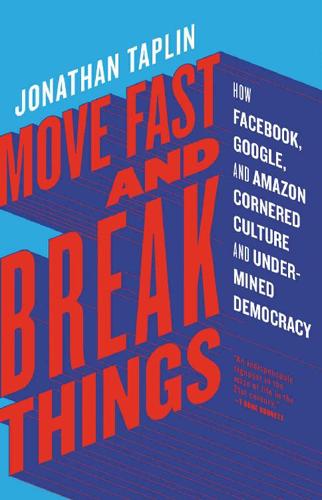
Move Fast and Break Things: How Facebook, Google, and Amazon Cornered Culture and Undermined Democracy
by
Jonathan Taplin
Published 17 Apr 2017
Google’s original “Don’t be evil” brand promise gave them a patina of social entrepreneurship that helps protect them from accusations of monopoly power tactics. As John Seely Brown has pointed out, the end of the decentralized Web that Engelbart and the PARC visionaries had imagined occurs at this point, when “we moved from products to platforms, which let the network effect play out in a hub and spoke model.” From this point on the economies of scale enjoyed by a platform whose users are measured in the billions becomes the ultimate metric for success. Thiel understood this, and from PayPal, the original founding group began to spread through Silicon Valley after eBay’s $1 billion acquisition of the company.
…
As the digital economy becomes a large component of our GDP and companies like Google, Apple, Amazon, Comcast, Verizon, and AT&T dominate the Fortune 100, a reexamination of some of the deregulatory nostrums of the Reagan era is in order. As Peter Thiel explains in Zero to One, the profit margins of true monopolies are extraordinary: “Google brought in $50 billion in 2012 (versus $160 billion for the whole airline industry), but it kept 21% of those revenues as profits—more than 100 times the airline industry profit margin that year. Google makes so much money it is now worth three times more than every U.S. airline combined.” The problem is that the enormous productivity of these companies, coupled with their oligopolistic pricing, generates a huge and growing surplus of cash that goes beyond the capacity of the economy to absorb through the normal channels of consumption and investment.
…
Clearly the increasing concentration of market share in the hands of a few US corporations ranges far beyond the tech sector, as Senator Elizabeth Warren pointed out in a speech she gave in June of 2016: In the last decade, the number of major U.S. airlines has dropped from nine to four. The four that are left standing—American, Delta, United, and Southwest—control over 80% of all domestic airline seats in the country.… A handful of health insurance giants—including Anthem, Blue Cross Blue Shield, United Healthcare, Aetna, and Cigna—control over 83% of the country’s health insurance market.… Three drug stores—CVS, Walgreens, and Rite Aid—control 99% of the drug stores in the country.
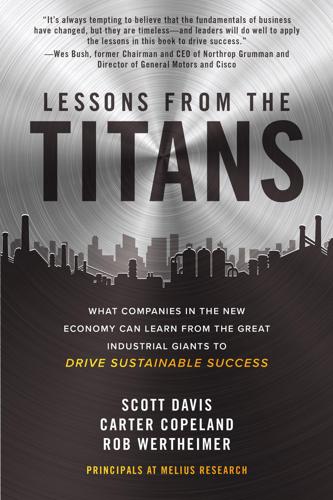
Lessons from the Titans: What Companies in the New Economy Can Learn from the Great Industrial Giants to Drive Sustainable Success
by
Scott Davis
,
Carter Copeland
and
Rob Wertheimer
Published 13 Jul 2020
Customers want to keep equipment for longer, changing their minds when the truck arrives for pickup, or they ask for something different when the truck arrives for delivery. Equipment in the field breaks and needs maintenance. The business is far more complicated than it looks, and it’s far more complicated than, for example, a FedEx style delivery system, which is generally a simple hub-and-spoke model. United Rentals knew early on that addressing customer dissatisfaction with deliveries was a major opportunity. Late deliveries also brought excess cost and lost pricing. Rental equipment might be only 2 percent of the cost of building a high-rise, but if the equipment is not there or not working, dozens of other processes stop.
…
Consequently, third parties often find the cost of investing in capital equipment and engineering expertise not worth the potential return. This dynamic is compounded by airline customer behavior. For an airline, the price points across TransDigm’s portfolio of parts are relatively low. Seat belts cost a minuscule fraction of what a spare part for an engine costs, but an airline needs both in order to be cleared for takeoff. TransDigm’s history of consistent on-time delivery and quality performance makes it rare for customers to switch providers. The risk isn’t worth it. Airlines cannot afford to miss out on several hundred thousand dollars of revenue if flights are canceled because a $200 spare part is not delivered on time or to specification.
…
Airbus sold the A320neo at a pace that took the aviation world by surprise, amassing more than 1,000 aircraft sales in just over six months. Boeing initially dismissed the need to respond to the A320neo’s success until longtime Boeing customer American Airlines was on the verge of signing an order for 500 A320neos. Overnight, Boeing scrapped the NSA concept and agreed to launch a re-engined version of its own 737, salvaging half the American Airlines order in the process. In the years that followed, both companies expanded the re-engining effort to their profitable widebody aircraft (A330 and B777). Unlike the well-trodden “lose billions and maybe make billions” path of clean-sheet aircraft development, re-engining saved billions in up-front development expenses when cash was a scarce commodity due to the failures of the 787, 747-8, and A380.
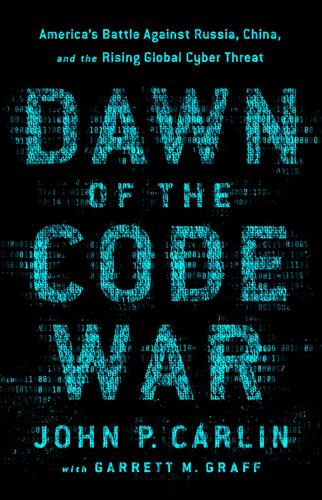
Dawn of the Code War: America's Battle Against Russia, China, and the Rising Global Cyber Threat
by
John P. Carlin
and
Garrett M. Graff
Published 15 Oct 2018
But the version that caught the eyes of researchers was different: more powerful and more sophisticated, particularly in its approach to assembling botnets. Until then, most botnets used a hub-and-spoke system—a hacker programmed a single command server to distribute orders directly to infected machines, zombie computers. The undead army could then be directed to send out spam emails, distribute malware, or target websites for denial-of-service attacks. That hub-and-spoke design, though, made botnets relatively easy for law enforcement or security researchers to dismantle. If you could knock the command server offline, seize it, or disrupt a hacker’s ability to communicate with it, you could usually break the botnet.
…
Inside the government, there had been until then a running analytic dispute about whether Anwar al-Awlaki had been “operational” or just “inspirational,” though the latter certainly proved worrisome enough. That dispute ended weeks after the Fort Hood bombing when we saw Umar Farouk Abdulmutallab, the so-called Underwear Bomber, try to blow up a transatlantic airliner en route to Detroit on Christmas Day 2009. Anwar al-Awlaki, the “sheikh,” as he was known in the terror camps in Yemen, personally helped recruit and train Abdulmutallab, even selecting an airliner as his target and helping him record a martyrdom video.11 Anwar al-Awlaki’s influence and leadership made him one of the prime targets for America’s counterterrorism effort by the start of the Obama administration.
…
Through in-depth analysis of domain registrant data, [we have] identified approximately 70 doppelganger domain names likely indicative of a potential target for COLD CUTS operations.”28 For instance, one of the Anthem hack domains had drawn upon the company’s previous name, Wellpoint, registering Wellpoint.com, which at a quick glance looked the same.29 Whoever was behind the COLD CUTS tradecraft was a true fan of Marvel Comics: we saw domains registered in another attack registered to Natasha Romanoff, the nom de plume for the heroine Black Widow, as well as John Nelson, the Oscar-nominated visual effects guru for the movie Iron Man. In a hack directed at United Airlines, one of the domains (united-airlines.net) was registered to James Rhodes, a friend of Tony Stark in the Iron Man movies.30 There was even a domain registered simply to Dubai Tycoon, a brief role in the Iron Man movie that had been played by Wu-Tang Clan rapper Ghostface Killah. Government investigators became even more worried when they saw the day the opmsecurity.org domain had been originally registered: April 25, 2014.
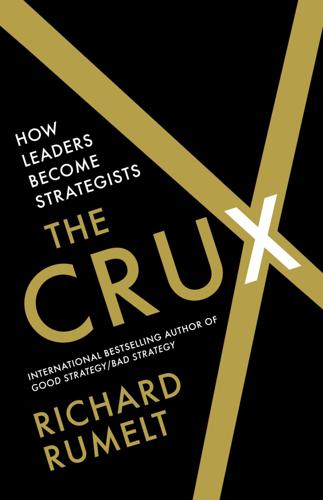
The Crux
by
Richard Rumelt
Published 27 Apr 2022
The industry was projected to lose $10 billion in 2020. The analogy between container shipping and the airlines was weak. To see why, notice how airline traffic has evolved. Under the old hub-and-spokes model, giant jumbo jets would connect key cities, while smaller jets would handle the regional traffic. But as passengers consider their costs of layovers, dealing with security at the large airports, and long walks from one airline to another, the industry has moved to point-to-point traffic using medium-size single-aisle jets. An airline cannot gain the economies of larger aircraft unless it can fill them up, which is one reason Airbus announced that it would quit production of its giant A380 jumbo jet.
…
Maersk was in a tough place with no easy answers. The international airline industry had also faced profitless conditions. One step toward a solution was to have the United States and the EU agree to code-sharing alliances. For example, both American Airlines and British Airways belong to the Oneworld Alliance. This allowed American to sell a through ticket from Portland to Chicago with the Chicago to London flight on British Airways that cocarried (code-shared) an AA flight number. This also helped blunt the incentive for each airline to expand into the other’s turf. Working on the analogy to the airline industry, Maersk led an industry movement to form shipping alliances, gaining an antitrust exemption from the EU (renewed in 2020 for another four years).
…
RYANAIR In 1984 Irish businessman Tony Ryan and two fellow investors formed Ryanair. Tony Ryan had worked for the Irish airline Aer Lingus and afterward built one of the largest airplane leasing companies in Europe. The Thatcher government had loosened the rules about who could run an airline, and Ryan’s intent was to compete with Aer Lingus on the London–Dublin route. He knew that Aer Lingus costs were bloated, as were sole competitor British Airways’, on that route. Ryan calculated that Ryanair could emulate the cost structure of American Airlines, offer good service and lower prices than did the government-owned carriers, and take share on the London–Dublin route.

Makers
by
Chris Anderson
Published 1 Oct 2012
Today’s cottage industry is more typically an Etsy marketplace seller with a computer-controlled vinyl cutter making cool stickers for Mac-books or making and selling perfect replacement parts for vintage cars. Like their Industrial Age ancestors, they typically make the kinds of things big factories do not—they focus on niche markets of thousands, not mass markets of millions. They’re distributed in a way that reflects the natural geography of ideas, not the hub-and-spoke logic of massive supply chains and cheap industrial land. They’re often run out of the Maker’s garage or workshop, at least at the start, and often use family members as help. They make a virtue of their small-batch status, emphasizing handcrafted or artisanal qualities. And they are focused on desktop production tools, best suited for hundreds or a few thousand pieces.
…
He was taking old DC-10s out of mothball storage and fixing them up enough for a crew to take them to Israel, where they could be overhauled and resold to a leasing company for a profit of more than $10 million each. By the late 1990s he had become the airline’s director of technical operations at a time when it was becoming clear that the difference between successful and unsuccessful airlines was all supply-chain management—using global suppliers to get the right part to the right place at the right time. That, in turn, made him realize that there was something bigger afoot than simply running an airline efficiently—the entire process of manufacturing was being reinvented by digital technologies. He took an offer to run regional sales for a CNC machine company, and in the course of doing so, he started talking to more manufacturers.
…
First he manually edited the machine-code files; then he learned how to program software to do it. As sometimes happens, learning to program flipped a switch in his head. He loved it. He had finally found his calling. In 1988, Northwest Airlines, which had a maintenance facility in Atlanta, recruited him to create digital copies of replacement airplane parts that the manufacturer couldn’t supply, so the airline could fabricate them itself if needed. Over time, he became the “innovation guy” at Northwest and grew more expert at digital tools, including a CNC machine he built that could automatically examine turbine blades, looking for flaws.
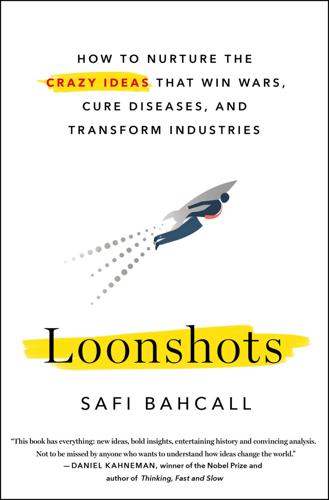
Loonshots: How to Nurture the Crazy Ideas That Win Wars, Cure Diseases, and Transform Industries
by
Safi Bahcall
Published 19 Mar 2019
Allen gave it a name: the Boeing 747. To fill two and a half times as many seats, an airline needs two and a half times as many passengers. Pan Am’s lock on international travel, however, had been weakening. Congress had launched an antitrust investigation of Pan Am’s monopoly on foreign routes in the 1950s. Populist voices complained that regulators were protecting industry giants rather than consumers. Some of the loudest complaints came from startups—Texas Air, Braniff, and, eventually, Southwest Airlines. The startups also brought new ideas to the industry. Hub and spoke. Flying to secondary airports. Reducing turnaround times to 20 minutes.
…
Deregulation, for a brief moment, let the faint, hidden light from S-type loonshots shine through. Most of those S-type loonshots were invented or perfected by American Airlines CEO Bob Crandall. Crandall was a master S-type innovator. Most of the industry’s P-type loonshots were invented or perfected by Pan Am’s founder and CEO, Juan Trippe. Trippe was a master P-type innovator. Between 1978 and 2008, deregulation helped drive 170 airlines out of business or into bankruptcy, including Pan Am and every major US carrier, except for one—American Airlines. Few industries today are as regulated as airlines were before 1978. But sudden shocks happen all the time. When Google announced one morning that it would give away its new mobile phone operating system—Android—for free, the rules of the mobile world suddenly changed.
…
USE “DISRUPTIVE INNOVATION” TO ANALYZE HISTORY; NURTURE LOONSHOTS TO TEST BELIEFS In an article addressing recent controversy about the notion of disruptive innovation, Christensen explains why Uber is not disruptive, by his definition, and why the iPhone also began as a sustaining innovation. In chapter 3, we saw that American Airlines—a large incumbent, not a new entrant—led the airline industry after deregulation with many brilliant “sustaining” innovations targeted to high-end customers. Hundreds of low-cost, specialty airline startups, “disruptive innovators,” failed. If the transistor, Google, the iPhone, Uber, Walmart, IKEA, and American Airlines’ Big Data and other industry-transforming ideas were all initially sustaining innovations, and hundreds of “disruptive innovators” fail, perhaps the distinction between sustaining vs. disruptive, while interesting academically or in hindsight, is less critical for steering businesses in real time than other notions.

Imagining India
by
Nandan Nilekani
Published 25 Nov 2008
Village centers equipped with handheld diagnostic tools could vastly reduce the need for doctors. Doctors could be contacted, via tele-infrastructure, on a case by case basis. And thanks to technology that now provides us connectivity as well as inexpensive, point-of-patient diagnostics tools for a variety of ailments, we can create a truly effective “hub and spoke” for curative health. And taken to its logical end, the model could ultimately make diagnosis a self-service that can be done at home. A chance to redefine our health space We do not have to lurch from crisis to crisis in our health—from shortage to excess, from starvation to fat. If we are able to foresee our biggest health threats, we can shape dynamic new policies that ensure low-cost, universal care, healthy behavior and remarkably long-lived, productive human capital.
…
They are illegal, of course, and so they tend to ply far from the cities. And for its cost—averaging less than Rs 20,000—the vehicle is a steal. Effective, innovative policies will depend on harnessing this ability of people at the local level to take charge and innovate. Our health approach will need hub-and-spoke models that empower workers down to the village level; our pensions systems will need local networks to reach unorganized and casual labor; our environment and energy solutions will have to rope in our tribal and village communities to be truly effective. I believe such approaches are uniquely suited to India, with its untapped pool of local, entrepreneurial and innovative talent.
…
“We build a flyover only when our roads are completely jammed, and people are agitating for it.” In fact, in his first days as the aviation minister, Praful attempted to trigger a similar out-pouring of demand for better air infrastructure. “Our private airlines had to get permissions from the government each time they wanted to buy a plane,” he says. “I gave each airline in-principle approval to buy up to five hundred aircraft.” The surge in airplanes created immense pressures on ground infrastructure and airport capacity—in 2007 India’s airports handled ninety million passengers, up from fifteen million in 2004.

Driverless: Intelligent Cars and the Road Ahead
by
Hod Lipson
and
Melba Kurman
Published 22 Sep 2016
Companies deal with the high cost of salaries by delivering goods to retail outlets using one large truck rather than two or three small ones. Cost-conscious shipping companies aggregate several individual shipments into a single, large delivery vehicle. This approach has led to the widespread use of an inefficient “hub and spoke” transportation model that delays delivery and causes vehicles to drive additional miles. In a hub-and-spoke model, individual shipments must first journey to the nearest hub, or distribution center, where they are aggregated with other small shipments into a single, larger one before being finally dispatched to their final destination. When the cost of the human driver is removed from the equation, a shipment can take a more direct route to its buyer.
…
The way a radar sensor works is reminiscent of the process of throwing stones into a body of water and keeping track of where the ensuing ripples go as they ricochet back and forth. Radar has its roots in military applications. During World War II, radar towers were placed on beaches and fields to detect the approach of enemy aircraft, ships, and incoming missiles. After the war, air-traffic controllers used radar to track and confirm flight trajectories of commercial airliners. Many people have felt the direct effects of radar technology if they’ve ever received a speeding ticket from the highway patrol. In another demonstration of Moore’s Law, radar sensors have become small and robust enough to be mounted on a moving car. Radar sensors are used in modern human-driven cars in adaptive cruise control technology.
…
The lowest tier would be commercial delivery vehicles that could be routed onto slower and less efficient side routes to clear the streets for higher-priority traffic. One potentially controversial possibility would be that city planners set up a “priority free market” where people buy and sell traffic priority, similar to the way airlines offer passengers more money if they give up their seats on an overbooked flight. Privacy Another regulatory challenge that will need to be solved with driverless cars is that of passenger privacy. Smart phones and social media have already introduced a whole new host of ethical challenges involving privacy.

The End of Traffic and the Future of Transport: Second Edition
by
David Levinson
and
Kevin Krizek
Published 17 Aug 2015
Most notably, one possible void is that micro-transit services (as well as MaaS Transport) become feeders to public transport's core routes. Addressing the proverbial 'first-mile, last-mile' problem (a space that bicycling also could address) — that gap at the start and end of every trip that's difficult for traditional transit operators to serve in a cost-effective way. The hub-and-spoke strategy will continue to serve transportation well. How these trunk and feeder systems are organized remains open. Perhaps the public retains the monopoly, capital intensive trunk (macro-transit), but the feeders (micro-transit, MaaS, personal transportation) are private, potentially competitive services.
…
They are more fuel efficient, pollute less (both because they use less energy and because they have better pollution control), are safer, have better user interfaces (we hope) and are more in-sync with changes in information technologies. Society wants fewer cars because that requires less space devoted to the storage of cars (parking), and makes driving less likely. Efficient use of capital, keeping vehicles in motion 24/7, is a hallmark of large, expensive fleets like shipping, airlines, railroads, and to a lesser extent trucks. Furthermore, a single owner of the fleet can achieve larger economies of scale. United Parcel Service controls almost 100,000 vehicles world-wide,112 allowing them to innovate in use of alternative fuels. Transforming this mid-speed technology to faster moving is an opportunity that new technologies portend, an opportunity we discuss in Chapter 8: Mobility-as-a-Service.
…
At a relatively lower price, more people would get a pass. We would expect more people to have passes than use the passes on the system every day (not every pass-holder need be a daily rider). People pay for the option without having to think about price, offering several benefits.236 Loyalty programs are a related strategy, now employed by airlines, to keep customers coming back. Now couple the season pass with a change in system organization. Season-pass holders are members. Membership changes the perspective from being a customer to being a long-term stake-holder and owner of the system. As a member of a club, I want there to be more members, as it helps spread the costs and raises money for the services provided.

The War Below: Lithium, Copper, and the Global Battle to Power Our Lives
by
Ernest Scheyder
Published 30 Jan 2024
And whereas Redwood chose to build a recycling and processing facility in Nevada to which old batteries were shipped, Li-Cycle opted for a so-called hub-and-spoke model, whereby they would build small facilities across the United States and Canada to collect old batteries and crush them down to black mass, which would then be sent to a centralized facility in Rochester, New York, for the black mass to be separated into metals. Depending on the recycling process and other factors, the cost of transporting lithium-ion batteries for recycling can be as much as 70 percent of the entire recycling process, an eye-popping number that shows why Li-Cycle favored its hub-and-spoke model.55 And just as the United States and other nations are having to grapple with the need to mine more of their own metals for the green energy transition, so, too, are they having to contend with the need to recycle more of their own batteries.
…
(McSwane), 10 Paris Climate Accords, 5–6, 13, 19, 30, 35, 293 Patagonia, 72 Patterson, Daniel, 171–73 Patwardhan, Amit, 281–82, 284 Paulson, John, 155, 161–64, 296 Peacey, Vicky, 53 Pebble copper and gold project, x, 14, 66, 165–69, 296 Peehee Mu’huh (Rotten Moon), 143 People of Red Mountain tribe, 133, 135, 139 Pérez de Solay, Martín, 231 Per Geijer rare earths deposit, xi Perpetua Resources Corp., 156–61, 163–65, 169, 208, 296 Peru, 10, 53, 54, 266 Phelps Dodge, 211–12, 214, 218–20, 254 Phillips, Keith, 204–8 Piedmont Lithium, 193, 195–210, 240–41, 243, 292, 297 Piedmont lithium project, x, 191–210 Piehl, Fred B., 102 Pinkas, Oscar, 114–17 Pioneer Mine, 83 Pioneer Museum, 83 Piragis Northwoods Company, 91 playas, 120–21 Pollock, Robert “Bobby,” 215, 217 pollution, by mines, 14, 47, 120–21, 145–46, 154, 158–60, 166, 168, 216, 221 PolyMet Mining project, 57, 164 population control, 138 potash, 265, 267, 282 Pregnant Leach Solution, 216 Prius, 25, 28 Protect Thacker Pass, 139 Putin, Vladimir, 277 Puutu Kunti Kurrama and Pinikura people (PKKP), 17, 54–55, 219 quartz, 193 Quechua people, 264–65 Quirk, Kathleen, 215, 226–27 QVT Financial, 113–14 radioactive waste, 120–21 Rainy River, 82, 83 Rambler, Sandra, 37 Rambler, Terry, 54–55, 57–58, 60, 218 rare earths elements, 8, 102, 105–7 Birthday Claim, 101–3 first identified, 99 found in bastnaesite, 100, 102, 104, 106 found in monazite, 99, 100 increased demand for, 14 industry started by U.S., 11 recycling of, 232 Russia and, 124 separating and processing, 103–5 thorium and, 99, 100, 102 uses for, 98, 100, 103, 109, 110, 123 rare earths magnets, 98, 105, 109, 110, 123, 234 Reagan, Ronald, 23 reclamation, 53 recycling: aluminum, 232 hub and spoke model of, 239 hydrometallurgical, 238–39 lead-acid batteries, 232–33 of lithium-ion batteries, 229–41, 296 pyrometallurgical, 238 Redwood Materials, 237–41, 244 Republicans, 59, 86, 165–66, 167–68, 296 Reschenthaler, Guy, 124 Resolution copper project, x, 34, 36–37, 53, 61, 128–29, 178, 187, 212–13, 218–19, 297 Biden and, 14–15, 37–42 Trump and, 37–38 resources, reserves vs., 265 Responsible Jewelry Council, 67 Reuter, Paul Julius, 15 Reuters, 6–7, 26, 111, 132, 269, 290 Reveal, James, 2–3 Rhyolite Ridge lithium project, x, 2–4, 21–31, 72–73, 170–90, 286–92, 298–99 Definitive Feasibility Study for, 30–31, 174 Rice University, Baker Institute for Public Policy, 230 Rio Tinto, 19, 165, 166, 233, 236, 284, 285 Chinese shareholders of, 60 origin of name, 56 PKKP Juukan Gorge caves destroyed by, 17, 54–55, 219 Resolution copper project and, 34, 36–62, 128–29, 218–19, 297 Rivian, 243 Roadster, 8, 10 Rock Creek copper and silver project, x, 65–66 Rockefeller, John D.
…
If a lithium-ion battery is damaged or overheats, the solution can ignite and fuel a fire that can be very difficult to extinguish. A cargo ship carrying more than four thousand luxury vehicles caught fire off the coast of Portugal in early 2022 and sank, with authorities suspecting thermal runaway caused by some EVs the ship was carrying.12 Germany’s Lufthansa became one of the first airlines to ban lithium-ion batteries from cargo shipments in 2015.13 The U.S. government banned the batteries from the cargo holds of passenger airplanes in 2019.14 That ban came several years after batteries in a Boeing 787 Dreamliner plane had caught fire, raising concerns about the plane’s safety.15 The New York City Council considered a ban on reusing the batteries out of concern they could be more dangerous if used in a device they were not originally built for.16 Beyond bans, the widening use of lithium-ion batteries amid the EV revolution prompted the need to consider what to do with all these batteries and how to transport them to recycling centers.

Intertwingled: Information Changes Everything
by
Peter Morville
Published 14 May 2014
For instance, Walt Disney built a sprawling empire, but each asset fit strategically in his map.lxxxviii He knew how the parts made a whole and never made decisions in the dark. Figure 3-16. Walt Disney’s Theory of the Firm. There’s a similar story behind Southwest Airlines. It began as a triangle on the back of a napkin with direct routes between Dallas, San Antonio, and Houston.lxxxix But the simple plan to ditch hub-and-spoke soon evolved into a textbook case of what Michael Porter calls strategic fit.xc Figure 3-17. The “Fit” for Southwest Airlines. First, there’s simple consistency between each activity and the overall strategy. Second, the activities are reinforcing. Third, the system allows for an optimization of effort that makes the whole greater than the sum of its parts.
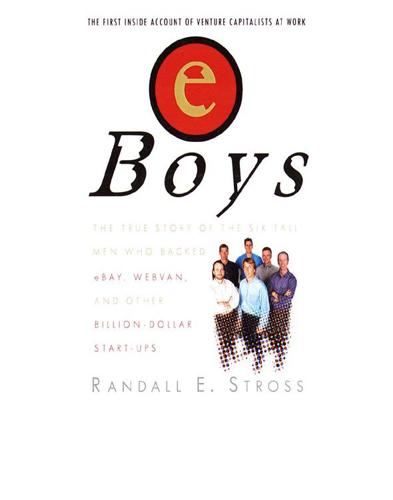
eBoys
by
Randall E. Stross
Published 30 Oct 2008
Borders matter-of-factly defined his chosen corner of the market as “the U.S. retail market,” which happened to be $2.3 trillion as of 1995. When he joined Benchmark, Beirne had said he wanted to pursue a go-big strategy, and this one certainly qualified. But he did not accept the whole vision. He wanted instead to start with groceries only, use Borders’s ideas about hub-and-spokes with an automated warehouse and neighborhood depots to replenish local delivery vans, but drop the idea of retail storefronts, which entailed unnecessary cost and complexity. Would Borders accept a less ambitious vision for this new company’s start? When Dave Beirne met with Borders for the first time, he shared his own thinking about MyStore, with conviction and details that showed it was not something he had cooked up to pander to Borders.
…
Encouraged, Walker pretended to be an imaginary customer: “The bastards are out there working for me! Yeah!” In fact, the bastards were working for the airlines, too, simultaneously, consulting with their revenue-management departments and tailoring arrangements to provide what Walker described to the Benchmark partners as a “dream come true” for airlines: These new customers could be plugged in to a reservations system wherever an airline wished. As an industry, the airlines annually had $38 billion worth of empty seats that they could not fill without weakening their existing revenue-maximization models. Now Priceline said to them—and here Walker picked up and waved a thick pile of computer printouts, bids that Priceline had collected from its website the previous week—here’s $5 million of credit card–guaranteed demand, from every city, to every city.
…
Now Priceline said to them—and here Walker picked up and waved a thick pile of computer printouts, bids that Priceline had collected from its website the previous week—here’s $5 million of credit card–guaranteed demand, from every city, to every city. It’s yours if you want! The average marginal cost of putting an additional passenger on a flight was only $20, so any fare that the airlines charged above $20 was gravy, profit that dropped right to the bottom line of the airline. “Which is why this is so powerfully attractive to the airline,” Walker said, grinning. But was it actually so “powerfully attractive”? Kevin Harvey mock-innocently asked how many of the major airlines had Priceline lined up, and the answer was only two, and relatively small ones at that: America West and TWA. Harvey’s follow-up questions exposed an additional problem: Priceline was unable to secure tickets at a deep discount, so it was selling tickets for below its own average cost in order to secure some customers.
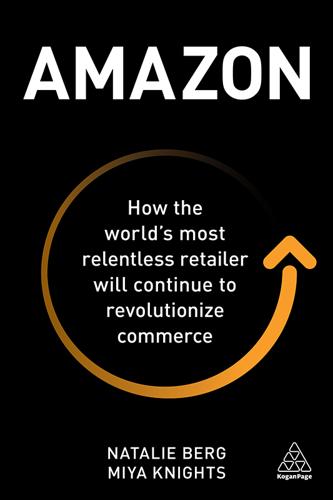
Amazon: How the World’s Most Relentless Retailer Will Continue to Revolutionize Commerce
by
Natalie Berg
and
Miya Knights
Published 28 Jan 2019
Figure 13.1 New fulfilment options driving heightened complexity in retail supply chains This is when you consider the proliferation of options the consumer now has, alongside the traditional shopping trip, where the customer picks, packs and receives their own goods in a store. Supply chain capabilities have had to rapidly evolve beyond traditional hub-and-spoke, distribution and fulfilment centres to store networks to enable shoppers to access products however, wherever and whenever they want them. The ‘terms’, as we have referred to them in this book, of the ‘on-my-terms’ shopper are dictated by the order (Figure 13.2). Figure 13.2 The growing complexity of fulfilling e-commerce customer orders With the consumer in control, the variations of the traditional supply chain are multiplying rapidly.
…
‘I have 1,800 mini warehouses across the country. 460 feature backrooms converted into online order fulfilment centres. Employees who are cross-trained to work the sales floor and the backrooms pick online orders from stores’ shelves or inventory and pack them at the store. UPS picks up the orders and delivers them to hub-and-spoke distribution centres.’ Brian Cornell, Target CEO, 201813 We’ve seen how Prime and Prime Now power the flywheel, and how new additions like Amazon Prime Pantry, AmazonFresh and Amazon Wardrobe add scale and breadth to the wider Amazon ecosystem. But we’ve also begun to explore how these new additions also put increased pressure on its supply chain and fulfilment logistics.
…
Amazon sells everything from nappies to treadmills, but it also produces hit television shows and provides cloud computing services to the US Government. Amazon is a hardware manufacturer, payment processor, advertising platform, ocean freight business, publisher, delivery network, fashion designer, private label business, home security provider and an airline. It doesn’t stop there. Amazon wants to be a supermarket, a bank, a healthcare provider and, by the time you’re reading this, it will probably be on the cusp of disrupting at least one more industry. Amazon is aware that, to the outside world, such diversification seems scattered and illogical. Is Amazon simply a jack of all trades, but master of none?
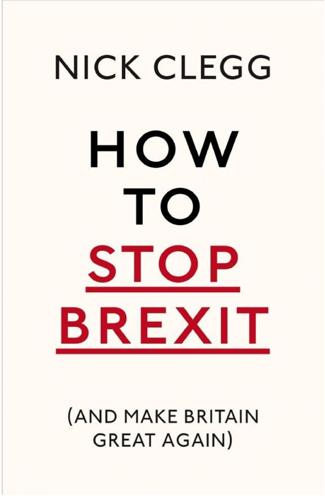
How to Stop Brexit (And Make Britain Great Again)
by
Nick Clegg
Published 11 Oct 2017
Just as Britain is full of angst about the movement of people within the EU, so the EU is grappling with the issue of the movement of people into the EU. So how might a reformed EU actually look? Back in December 2011, as Whitehall’s top brass sat around digesting the fallout from Cameron’s surprise veto of the EU’s draft treaty, I remember there was a lot of talk about the EU developing into a series of ‘concentric circles’ – a kind of hub-and-spoke arrangement – in which the eurozone formed the hub and Britain was located in an outer circle, a spoke-length away from the inner core. The thing we all realised at the time was that the EU countries that shared the single currency were obliged to move ahead at pace to overcome the economic crisis, leaving the non-eurozone members of the EU, and in particular Britain, behind.
…
When the Prime Minister declared that she would pull Britain out of the remit of the European Court of Justice (ECJ), did she realise that the court is the ultimate arbiter for a myriad of crucial day-to-day activities, from mobile telephone roaming charges to cross-border police cooperation and the mutual recognition of professional qualifications? Without a deal, will our aeroplanes even be able to land at European airports? The airline industry has repeatedly warned that flights could be grounded, if the UK leaves the EU’s Open Skies Agreement. What does Brexit mean for the nuclear industry? The government has admitted that it did no formal assessment into the consequences of leaving Euratom, the non-EU, Europe-wide nuclear agency that is vital for nuclear research and safety, but which happens to be subject to ECJ rulings.
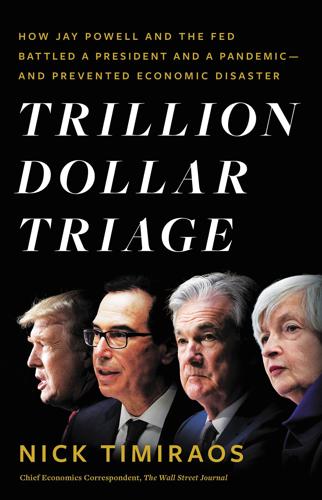
Trillion Dollar Triage: How Jay Powell and the Fed Battled a President and a Pandemic---And Prevented Economic Disaster
by
Nick Timiraos
Published 1 Mar 2022
By the end of March, the markets were beginning to function normally and the Dow was on a steady upward trend. But once people had a chance to breathe, there were new questions, more pushback, and a lot of work still left to do. With a virtual workforce, the Fed’s crisis-management operations relied on a hub-and-spoke approach. Jay Powell sat at the center of the senior-most hub, receiving reports on the banking system from Randal Quarles, on the lending programs from Lael Brainard and Andreas Lehnert, on market functioning issues from John Williams and Lorie Logan, and on longer-run monetary-policy issues from Richard Clarida and Williams.
…
Kudlow looked him in the eye and said, “I’m afraid you’re right.” Chapter Eight MELTDOWN On Sunday, March 8, Dallas Fed President Robert Kaplan took his five-year-old son to his first basketball game—the hometown Mavericks played the Indiana Pacers in front of 20,000 fans at the American Airlines Center. The Mavs lost a close one, 112-109. Three days later the entire league shut down—neither team would play again until the end of July. As the game ended, the Dallas Fed’s top energy analyst called Kaplan with a heads-up: Russia and Saudi Arabia had failed to agree on the oil-production cuts the market had anticipated that weekend.
…
If Treasuries aren’t safe, a global financial panic is virtually guaranteed. That morning, news broke that Boeing planned to make use of the full amount of a $13.8 billion lending facility—a prearranged credit limit that the company had not come close to exhausting—as soon as Friday. Air travel had ground to a halt, and Boeing and the airlines were facing the near-total collapse of their revenues. Investors took the announcement as an act of desperation, sending the plane maker’s shares plunging. Wynn Resorts and Hilton Hotels followed Boeing’s move, converting their credit to cash in case they needed it to maintain operations. As revenue vanished, more companies began to wonder if they would have access to new financing, so they began borrowing from their existing credit lines to sock away dollars to pay workers and bills.
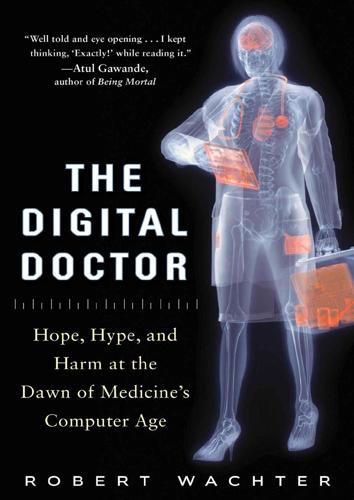
The Digital Doctor: Hope, Hype, and Harm at the Dawn of Medicine’s Computer Age
by
Robert Wachter
Published 7 Apr 2015
Athenahealth’s story is every bit as remarkable as Epic’s, but it bears the unmistakable imprint of today’s generation, with its new way of thinking about technology and its Game On! sensibility. Said Brandon Hull, a venture capitalist who made an early investment in athena: “Epic is a wonderful company, with incredible solutions, but ultimately is on the wrong side of history. Every other American vertical market is migrating away from centralized, client-server, hub-and-spoke architecture toward distributed, SaaS-based applications and open architecture.” This is techno-speak for the difference between using a suite of the old Microsoft Office programs (all of which lived on physical servers in your company’s closets and required lots of training, legions of on-site IT staff, and insertion of new disks for program upgrades) to the modern cloud-based architecture (software as a service, or SaaS) of products like Gmail and Dropbox.
…
Organizational expert Jody Hoffer Gittell, a professor at Brandeis University, studies “relational coordination,” the process by which workers communicate with and relate to each other. Relational coordination, she has found, is crucial in environments characterized by task interdependence, uncertainty, and time constraints. As a PhD student at MIT, she studied the airline industry, particularly the field known as Flight Ops, the folks who manage to get a plane into a gate and turn it around for the next departure. Gittell noticed that Southwest Airlines did something that other carriers considered inefficient: it assigned a single ops agent to coordinate one flight departure at a time. That person was communicating with all the players, sometimes face to face, or by phone, or by walkie-talkie.
…
In other words, the incumbent companies—Big Steel to use one famous example, Ma Bell another—are best able to meet all the requirements (or, through their lawyers and lobbyists, influence them in their own favor). This makes it harder for nimble new entrants to come in and begin taking over a previously ignored part of the market, the pattern of disruptive innovation famously described by Clay Christensen. It was the deregulation of the airlines in the 1980s that paved the way for Southwest Airlines and JetBlue. And the relatively unencumbered world of the Internet has allowed the emergence of companies like Amazon and Airbnb. Such disruptors often sneak around the edges of a market (and sometimes the law; think Napster or Uber), and, by the time the incumbents wake up and begin trying to defend their franchise, the new service is too entrenched to take down.
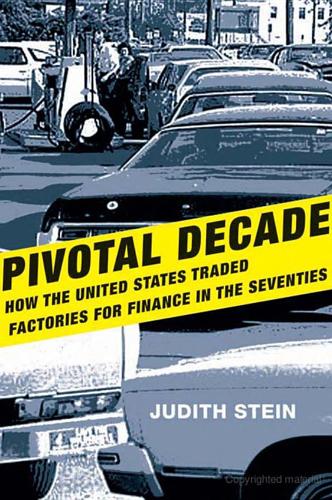
Pivotal Decade: How the United States Traded Factories for Finance in the Seventies
by
Judith Stein
Published 30 Apr 2010
Quirk and William Cunion, “Clinton’s Domestic Policy: The Lessons of a ‘New Democrat,’” in The Clinton Legacy, ed. Colin Campbell and Bert A Rockman (New York: Chatham House, 2000), 220. 81. But the deregulation of the Carter, Reagan, and Bush years did not improve productivity. Airline deregulation evolved into the hub and spoke system, which allowed carriers to raise prices and respond ruthlessly when new carriers attempted to compete. The banking deregulation of the 1980s led to the savings and loan disasters. The deregulation of electricity raised rates. 82. Congressional Quarterly Weekly Report, 55 (Oct. 4, 1997), 2390–92. 83.
…
Agricultural output per worker grew 85 percent in the 1950s and 77 percent in the 1960s.14 New Deal programs in communications, banking, housing, and airlines stabilized investment. To make the telephone accessible to all, the government set tariffs so that richer and urban consumers subsidized poorer and rural customers. New Dealers removed the risk in the mortgage market so that banks and other institutions could lend to many who otherwise never could have entered the housing market. They did not ignore renters, funding extensive public housing construction. The government promoted airlines by offering mail contracts to sustain the new business. The state funded research in defense and space and was itself the market for the products of that research.
…
Kennedy called “the New Deal faith in the science of the regulatory art a delusion,” and said that agency independence “as a practical matter has come to mean independence from the public interest.”99 Was this theory of industry capture valid? Advocates cited Nixon’s appointment of airline executives to the Civil Aeronautics Board (CAB) as a reward for campaign contributions. But Ford appointed John Robson, an airline critic. Most historians conclude that the story of railroad regulation was the story of shippers’, not railroad, control.100 Whatever the theory, government could shape markets and technology but could not ignore them. The left often tried to transcend markets, and the right never acknowledged that all markets are created by laws and that they reflected power as well as efficiency.

The Wealth of Networks: How Social Production Transforms Markets and Freedom
by
Yochai Benkler
Published 14 May 2006
The structure of the mass media resulted in a relatively controlled public sphere--although the degree of control was vastly different depending on whether the institutional model was liberal or authoritarian--with influence over the debate in the public sphere heavily tilted toward those who controlled the means of mass communications. The technical architecture was a one-way, hub-and-spoke structure, with unidirectional links to its ends, running from the center to the periphery. A very small number of production facilities produced large amounts of identical copies of statements or communications, which could then be efficiently sent in identical form to very large numbers of recipients.
…
Cable networks and satellite networks varied to some extent, but retained the basic advertiser-supported model, oriented toward luring the widest possible audience to view the advertising that paid for the programming. 353 Basic Critiques of Mass Media 354 The cluster of practices that form the mass-media model was highly conducive to social control in authoritarian countries. The hub-and-spoke technical architecture and unidirectional endpoint-reception model of these systems made it very simple to control, by controlling the core--the state-owned television, radio, and newspapers. The high cost of providing [pg 197] high-circulation statements meant that subversive publications were difficult to make and communicate across large distances and to large populations of potential supporters.
…
Using Networked Communication to Work Around Authoritarian Control Toward a Networked Public Sphere 377 The fundamental elements of the difference between the networked information economy and the mass media are network architecture and the cost of becoming a speaker. The first element is the shift from a hub-and-spoke architecture with unidirectional links to the end points in the mass media, to distributed architecture with multidirectional connections among all nodes in the networked information environment. The second is the practical elimination of communications costs as a barrier to speaking across associational boundaries.

The Only Game in Town: Central Banks, Instability, and Avoiding the Next Collapse
by
Mohamed A. El-Erian
Published 26 Jan 2016
In effect, IBM identified the bimodal distribution facing it, and while they had the capabilities to manage it well, they failed to do so because they ended up overly influenced by what had worked well for them in the past (when they operated in the belly of a bell-shaped curve) rather than what would work better in the future under changed and more uncertain conditions. Then there is the case of Pan American World Airways (Pan Am) and Trans World Airlines (TWA). They were dominant U.S. airline companies when I was growing up, as was Eastern Airlines. Their networks (and revenues) were tilted heavily in favor of cross-country U.S. routes and international ones. Along came Southwest (and others) with a disruptive technology. The company used one model of aircraft and focused initially on shorter regional routes, before shifting to a hub-and-spoke model. While witnessing Southwest gain traction as a disruptive technology and gradually eat into their market share, the established companies failed to substantially modify their behaviors and strategies.
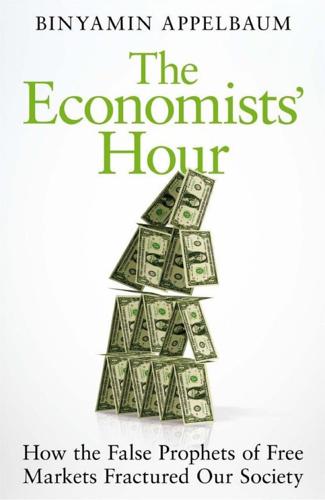
The Economists' Hour: How the False Prophets of Free Markets Fractured Our Society
by
Binyamin Appelbaum
Published 4 Sep 2019
Irish construction workers commuted to London, where jobs were more plentiful; Catholic priests in London spread word of a cheap way home for weddings and funerals.94 The champions of open skies, including Kahn, predicted competition would thrive because every route was a discrete market in which airlines of various sizes could compete on even terms.95 They did not anticipate the ways in which larger airlines would turn size into a competitive advantage, including the rise of hub-and-spoke route systems and frequent-flyer programs. The U.S. government allowed the industry to consolidate: during the Obama administration, the nation’s eight largest airlines paired off and became the nation’s four largest airlines, carrying more than 80 percent of domestic passengers.96 European regulators, by contrast, put limits on consolidation.
…
Trucking was placed under regulation at the urging of railroads, which feared the rise of a rival. Airlines were included at their own behest, but Congress was receptive in part because airlines were seen as railroads by other means. Prices were set at the same level as first-class passenger fares on the same railroad routes, and early airline maps looked like railroad maps: thick, straight lines along the ground, rather than the arcs used on modern maps. * Texas got its own discount carrier in 1971, when Southwest Airlines began flying between Dallas, Houston, and San Antonio. The new airline borrowed Pacific Southwest’s business plan and half its name.
…
— Charles de Gaulle, letter to Alain Peyrefitte (1962)1 In the mid-1930s, the fledging airline industry hired Colonel Edgar Gorrell, a decorated army aviator, to convince Congress that competition was threatening the industry’s survival. Gorrell painted a bleak picture for Congress: new airlines kept entering the business, as all it took was a pilot and a plane; existing airlines kept adding routes; companies competed vigorously to offer the best prices and service. It was “economic anarchy,” said Gorrell — chaotic, cutthroat, and unprofitable. He pleaded for the government to tuck the airlines under its wing.2 Congress obliged Gorrell in 1938, creating the Civil Aeronautics Authority, which issued licenses to sixteen airlines and then refused to let anyone else enter the business for the next four decades.3 “For the first time,” the authority declared in its initial report in 1940, “American air carriers and the public are safeguarded against uneconomic, destructive competition.”4 Even as the United States sought to increase competition across much of the economy in the mid-twentieth century through invigorated enforcement of antitrust laws, it was widely accepted that some industries were “natural monopolies” — sectors in which healthy competition was impossible.

Age of the City: Why Our Future Will Be Won or Lost Together
by
Ian Goldin
and
Tom Lee-Devlin
Published 21 Jun 2023
Venice rose to prosperity as an entrepôt facilitating trade between east and west.39 Later, cities such as Singapore and Hong Kong would grow wealthy by facilitating ocean trade between Asia and the rest of the world. There are many reasons why cities have always been vital to global trade that go beyond merchants requiring resting places on long-distance routes. Hub-and-spoke distribution systems, with cities as the connecting nodes, reduce the total distance of travel required and the amount of physical infrastructure such as ports and roads needed to facilitate trade. Cities also offer translation, financing and other services that facilitate exchange. These in turn are made possible by the presence of migrant diasporas.
…
With time, offices may come to be seen as places to connect and socialize more than places to find a desk. Zoom, admittedly with a vested interest, argues that offices are ‘no longer for doing good work so much as making good work possible, facilitating collaboration and fostering camaraderie. The office is now like an off-site.’32 Early in the pandemic, some suggested that a ‘hub and spoke’ model, with satellite offices located closer to workers’ homes, would emerge as the new standard configuration.33 Increasingly, it looks like workers’ homes will be the ‘spokes’, while the ‘hubs’ will be cutting-edge office buildings in prime urban locations.34 It is in such spaces, which bring together workers from a variety of teams, that the cross-pollination necessary for the vitality of modern companies will take place.
…
In a world of greater automation, delivering products or services typically involves more upfront investment, but lower per-unit cost once those initial investments have been made. That dynamic favours larger firms who can spread these costs over a bigger revenue base. The result has been a phase of increased consolidation across many US industries, from banking to airlines to consumer goods, a process helped along by a shift in anti-trust regulation in the 1980s that made it easier for firms to acquire one another. Experts disagree on whether increased market concentration has been good or bad for consumers. If weaker businesses are hoovered up by the most efficient companies, it can lead to lower prices.

A Demon of Our Own Design: Markets, Hedge Funds, and the Perils of Financial Innovation
by
Richard Bookstaber
Published 5 Apr 2007
Put another way, there is plenty of slack in the system (not to mention many slackers). Another example of a system that is complex but sheltered from catastrophic failure thanks to loose coupling is the hub-and-spoke system for airlines. This is a system that in theory adds efficiency, but in practice has become a questionable approach because of the feedback that propagates unavoidable failures. (I am referring to airline scheduling, not airline safety.) But there are plenty of options available and time to consider them—though that often leaves you cooling your heels in Atlanta. Flights can be delayed or canceled; in the worst case, aircraft en route can be rerouted.
…
But even then, although its name suggests otherwise, statistical arbitrage is a spread trade, not a true arbitrage trade. Bamberger pitched his strategy, and surprisingly, given the politics of the firm, the equity division was willing to let him give it a try. He got a desk just to the side of the futures traders, mounted with monitors that tracked every pair: Ford and GM, American Airlines and United Airlines, International Paper and Georgia-Pacific, and so on. People were dumbfounded by the results: In his first year of trading he made $6 million. Then, in the classic Morgan Stanley style of the time, office politics reverted to the mean, too. Bill Cooke, the head of the systems area and Bamberger’s boss’s boss, gave one of his lieutenants, Nunzio Tartaglia, oversight for the operation at the latter’s request.
…
As with many ideals, its origin is in academia, in this case a theoretical framework that underpins a half-century of work in financial economics called the perfect market paradigm. To understand more concretely the structures and resulting interactions that can lead to unavoidable crisis, here are two case studies drawn from industries in which failures may be measured not just in dollars and cents but in loss of life: nuclear power and airlines.2 Three Mile Island: The Dangers of Safety Systems The objective of a nuclear power plant is simple: to boil water to produce steam. The steam is then used to turn a turbine, a process that dates back at least two millennia to Hero of Alexandria. The complication with nuclear power is in how the water is boiled.
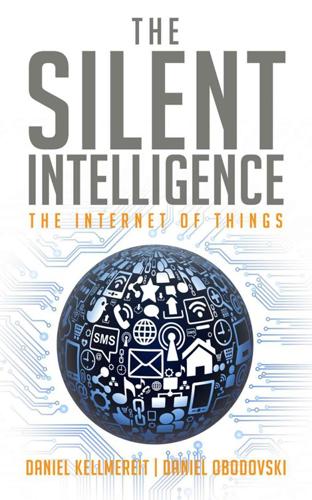
The Silent Intelligence: The Internet of Things
by
Daniel Kellmereit
and
Daniel Obodovski
Published 19 Sep 2013
The big data engines, like SAP or Microsoft, can pull the data off the connected devices and make the streams of data available to interested third parties. It could be any number of value chain participants, and think of it almost like the cable model, where others can subscribe to this data. Says Glen Allmendinger: I’ve always used this notion of simple and complex systems. If I’m just connecting an ATM or MRI machine onto my own hub-and-spoke remote service or remote support system, that’s a simple application. When there’s a ton of confusing data across many different types of machines, environments, and applications within a hospital, or factory or even a city, I call that a complex environment…. When you look at the landscape, the whole world out there, you largely still reside within the simple environment, with bits and pieces of compound values starting to eke themselves out naturally.
…
Finally, as mentioned, the device had the capability of providing its location both outdoors and indoors, which most GPS devices could not do at the time. Who would use such a device and why? From the beginning, we saw huge potential. People could track their loved ones: children, pets, and elderly relatives. Companies could track cargo and packages, law enforcement officers could recover stolen goods, airlines could track lost luggage, and more. The potential could mean millions or tens of millions devices sold. But before you start selling millions of devices, you have to sell the first one, and you need to know who is going to buy it, why they are going to buy it, and what it is they are actually going to buy.

Bank 3.0: Why Banking Is No Longer Somewhere You Go but Something You Do
by
Brett King
Published 26 Dec 2012
According to the survey, the common attributes of these “advanced” companies’ Centres of Excellence included: Table 11.1: Attributes of “advanced” companies’ Centres of Excellence (Credit: Altimeter Group) Centre of Excellence Duties Best Practice Attributes of Advanced Companies Provide leadership from a dedicated and shared central hub established at corporate or divisional level Establish cross-functional, scalably organised in hub-and-spoke formation Centre of Excellence with a Charter Document clarifiyng the business goals and purpose of COE. Provide expert resource on vendor selection, monitoring, analysis and measurement across the company. Establish baseline governance and reinforcement policies Publish and reinforce corporate media policies that clarify how employees can participate in social media in a professional and acceptable manner that legally protects both employees and the company.
…
Where am I going to get this done before I have to travel?” If they are comfortable with the web, they might log on right there and then and apply. Alternatively, they might ring the call centre and see if they can sign up over the phone. Or they might call their travel agent or visit their airline’s website and see if the airline/hotel package they have has some travel insurance deal linked to it. In the world of banking as a utility, however, they’ll have the option to bundle travel insurance with their trip they purchase, or they’ll receive a geolocation- and time-sensitive notification via their phone as they walk into the airport ready to depart on their trip.
…
Wells Fargo calls its branches stores, and while it has opened up the space in its branches somewhat, the fundamental problems of culture and lack of engagement remain because it only went halfway. What are the key components to reimagining the retail space? Figure 3.3: The “check-in” desks at Deutsche’s Q110 branch in Berlin (Credit: Deutsche Bank) Meet and Greet Common to many of the newer designs of retail spaces is an airline- or hotel-type check-in or reception area. Some deploy an actual person to meet or greet, others simply allow the customer to self-serve. However, the meet-and-greet component is important in providing a strong initial service offering, an appearance as a brand with the wish to engage the customer.

The End of Big: How the Internet Makes David the New Goliath
by
Nicco Mele
Published 14 Apr 2013
As he remarked during a conference call, “we will be in a situation where within two years the price of delivered power from solar installations will be able to undercut the retail price of grid power in roughly twenty states. … This low-cost solar power, installed in ever-increasing volumes on a distributed and semi-distributed basis in a way that obviates the need for a lot of very long high-voltage transmission lines, has a potential to revolutionize the hub-and-spoke power system which currently makes up the American power industry.”32 Right now you get your power from a fossil-fuel power plant owned by a big utility or power company. But your neighborhood could set up a shared solar installation to create power for nearby homes (using the blueprints and guidance of the crowd-sourced online community SolaRoof.org), and could even conceivably sell that power to other nearby neighborhoods—puncturing the model of Big Power.
…
The key to making our institutions relevant again is to look at them with new eyes, recognizing again that every person they touch—the people they serve, and the people who work within them—carries enormous personal power thanks to their digital life. How do we reimagine representative government with this insight in mind? How about big companies or big media? We must move institutions from the hub-and-spoke model—the “big will do this for you,” the small, powerless individual—to new models that acknowledge and harness the individual’s intense power and connectivity. At the same time, we need to retain and reconstitute elements of the big institutions that we’re losing: accountability journalism, national security, courts and justice, fiscal policy, safety regulations and quality control, to name a few.
…
Just as the end of Big News has meant a demonstrable loss of accountability journalism, we might worry that the end of Big Companies could mean a demonstrable loss of accountability, especially in industries where technical expertise or competency is required. While I tend to sympathize with the views of Ben Kaufman of Quirky and others who believe that anything—literally anything—can be crowd-sourced, I’m not sure everything should be crowd-sourced. Would you want to fly on a small airline that uses a craft- or maker-produced airplane whose engines come from a craft- or maker-produced engine company? Would you want to buy prescription drugs to treat cancer from a one-person company, a chemist in his basement concocting treatments? Would you really feel comfortable buying your car from a maker company you’d never heard of before?
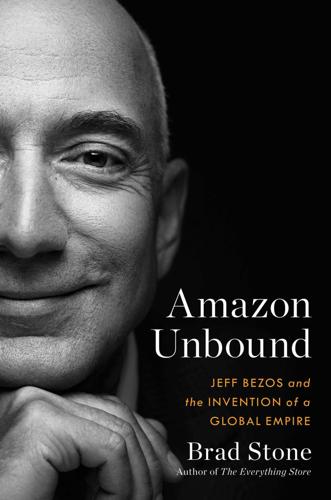
Amazon Unbound: Jeff Bezos and the Invention of a Global Empire
by
Brad Stone
Published 10 May 2021
To fashion a new supply chain for perishable groceries, it created chilled rooms inside existing Amazon fulfillment centers an hour or so to the east of each city, in San Bernardino and Tracy, California. Then Amazon routed trailer trucks twice a day into staging areas in each region, where orders were moved to bright green Fresh vans for the last-mile delivery to customers’ homes. Logistics employees who worked on the California service said this hub-and-spoke model ended up being inefficient and unreliable; one said that Amazon was “basically stapling a $10 or $20 bill to every order.” The Fresh team also tracked a metric called “perfect deliveries”—when an order was promptly delivered and included every item. They found they were hitting that target less than 70 percent of the time.
…
In the resulting white paper, they argued that owning air capacity would allow Amazon to shorten its delivery times and pay only the true cost of transporting cargo in the air rather than the public rates charged by UPS and FedEx Express. Bezos was dubious about buying planes outright and wondered what Amazon would do differently from other logistics companies if it operated a freight airline. Executives were also undoubtedly aware that operating an airline would come with plenty of actual baggage: it could expose the company to a potentially belligerent pilots’ union, a surfeit of regulations, and an oversight authority, the FAA, that had a dim view of Silicon Valley–style corner-cutting and innovation. The solution they came up with, which Clark successfully proposed to the S-team, allowed Amazon to avoid those drawbacks.
…
Like Amazon’s parallel initiatives on the ground, the plan called for controlling air freight while not necessarily owning it or exposing the company to the dangerous messiness of the aviation industry. The details provide a fascinating window into the self-amplifying advantages of Amazon’s size and power. Over the spring of 2016, Amazon announced it was leasing forty Boeing 767 freighters from a pair of airlines: ATSG, based in Wilmington, Ohio, and Atlas Air, based in Westchester County, New York. The airlines would continue to maintain and operate the aircraft, but the planes would be rebranded with the Prime Air logo and requisitioned into Amazon’s service for a period of five to ten years. As part of those deals, Amazon purchased warrants to buy 19.9 percent of ATSG stock at $9.73 a share and 20 percent of Atlas’s parent company at $37.50 a share.

The Content Trap: A Strategist's Guide to Digital Change
by
Bharat Anand
Published 17 Oct 2016
And they may be precisely why so many companies find digital transformation hard, misdiagnose threats to their business, and miss opportunities. These prescriptions tend to lead firms to focus on customers one by one and miss the connections that arise from managing customers as a portfolio. They lead us to believe that content quality is the key to success—when connections are. They lead us to believe that traditional hub-and-spoke marketing still wins—when networks do. They lead us to believe that traditional media is threatened by better and more varied digital content that lures customers in droves—when fixed costs are the real culprit. In each case, they lead us into the Content Trap. User connections come in different forms: network effects (as in the PC wars or news classifieds), preference connections (as in print-digital usage or broadband-cable viewership), or fixed costs (as in most content businesses).
…
But They’re Definitely on the Decline,” Fortune , September 24, 2015; Alexandra Alter, “The Plot Twist: E-Book Sales Slip, and Print Is Far From Dead,” New York Times , September 22, 2015. near the top in customer satisfaction Information about Southwest drawn primarily from James Heskett and Roger Hallowell, “Southwest Airlines—1993 (A),” HBS No. 694-023 (Boston: Harvard Business Publishing, rev. April 2, 1997), and Ramon Casadesus-Masanell et al., “Two Ways to Fly South: Lan Airlines and Southwest Airlines,” HBS No. 707-414 (Boston: Harvard Business Publishing, rev. March 15, 2010). “Resisting the urge to say yes” I am grateful to Chris Stibbs for an interview in October 2013 (all quotes in this section are from this interview).
…
But why is it that the world’s largest retailer, and one of the most profitable companies on the planet, doesn’t invest in providing a more upscale, warmer shopping environment for its customers? Similarly surprising behavior can be seen from leading companies in other industries. Southwest Airlines, the most profitable airline in the United States for most of the last two decades, is also consistently near the top in customer satisfaction surveys, except in one category: food. Apple, the most valuable company on the planet, also has customer ratings that are off the charts, except when it comes to two attributes that electronics buyers often care about—compatibility with other products, and low prices.
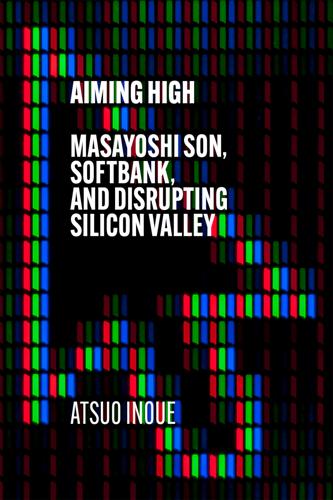
Aiming High: Masayoshi Son, SoftBank, and Disrupting Silicon Valley
by
Atsuo Inoue
Published 18 Nov 2021
In any sector or business, being at the right place at the right time – random acts of fate, essentially – plays an important role in success and with the Covid-19 pandemic and social-distancing requirements companies have been forced into a rethink of population density within the workplace, with some concluding agreements with WeWork to accommodate their employees. It also presents a solution in terms of new trends in reducing the distance between the workplace and employees’ places of residence, such as with Facebook telling its employees they can work from any WeWork they please. Furthermore, a large number of companies have adopted a hub-and-spoke model approach to business, with a head office and then a number of satellite offices, including WeWork spaces. Son certainly took a large gamble when he asked Marcelo Claure to take over at Sprint, given the latter knew nothing about the technology – it actually ended up taking him three years to get his head around it, although Claure is adamant that ‘when you get older, you get smarter and you get wiser’.
…
People’s expectations have changed as well: they may be perfectly happy working from home or they may not want to work from home but would still like to avoid the hassle and time-sink of a commute (the notorious three-hour commutes into Tokyo on crowded trains immediately spring to mind here). The hub-and-spoke model has been adopted by businesses as a means of addressing this, with a smaller head office but a relatively larger number of satellite offices. In a number of surveys conducted amongst company employees asking whether they would want to go back to working in an office once the pandemic is over, 10 per cent stated they wanted to go back to the old way of working, 20 per cent stated they were happy with work-from-home arrangements, and an overwhelming 70 per cent stated they would prefer a hybrid model where the two systems were mixed.
…
This flexible way of working is going to be part of our business life and WeWork allows the enterprises to create these flexible working arrangements, so in the long term, Masa is going to be right.’ Son has his own thoughts. ‘Right now, it’s a lockdown situation, stay-at-home, as you are well aware. People are not supposed to go to their offices. So, I think businesses in real estate, hotels, and airlines right now are in a state of collapse, no matter who is running them. However, if vaccines are widely available, I understand enough vaccines and antibodies will be distributed by the end of next year. When that happens, I wonder if the lifestyle in the post-pandemic era would go back to the way it was before the pandemic.
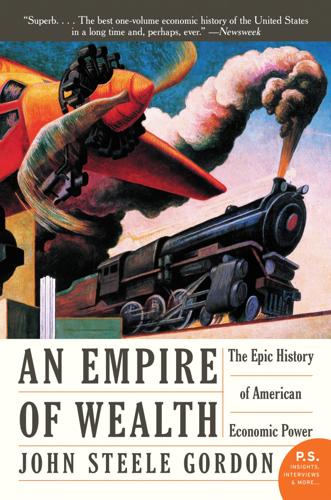
An Empire of Wealth: Rise of American Economy Power 1607-2000
by
John Steele Gordon
Published 12 Oct 2009
In 1978 its power to set rates and routes was taken away by Congress, despite the ferocious opposition of both the airline companies and the airline unions (when both management and labor oppose a change in regulation, it’s a sure sign that a cartel is in operation). The airline business, regulated since its infancy, underwent a painful period of adjustment as airlines began to compete by means of fares. A hub-and-spoke route system soon evolved, and air fares changed frequently as price wars broke out among the airlines. Many old airlines, such as Pan American, Eastern, and Braniff went bankrupt, and many new ones, such as Southwest Airlines, entered the business. Air fares fell drastically on average and air travel increased rapidly.
…
For that reason, market share is crucial to profitability on the lines where there is competition, as every additional passenger or ton of freight adds to income without adding much to expenses. Because of the need for market share, price wars were common between competing railroads in the nineteenth century (and are common between airlines today for precisely the same reasons). But there are natural limits to these price wars, as below a certain point, rate cuts become economically suicidal. The board of the Erie, however, was largely unconcerned with such mundane, long-term matters as profitability or even viability. They were far more interested in short-term trading profits on the Street.
…
Instead the averages declined, sometimes sharply, sometimes gently, although many individual stocks, especially those that had been publicly offered toward the end of the great bull market, lost much of their value. There was no reason to believe that anything more than a normal, if considerable stock market correction with a very mild recession was taking place. THEN, ON THE MORNING of September 11, 2001, an almost lyrically beautiful late summer day, a hijacked airliner slammed into the north tower of the World Trade Center in New York. A few minutes later a second hit the south tower. In less than two hours both buildings collapsed, killing thousands of innocent people. A pall of smoke and dust spread across the nation’s largest city and its financial district that had been the very beating heart of world capitalism for three generations.

Wealth and Poverty: A New Edition for the Twenty-First Century
by
George Gilder
Published 30 Apr 1981
He returns and restores it to supremacy as a multifarious supplier of drinks and food and home comforts outside of home. Herb Kelleher leaves the northeast to become a lawyer in Texas. On the proverbial napkin he outlines plans for a new kind of airline in Texas. Defying the deepest beliefs of the experts in the established airlines—their gouge-and-gotcha pricing, hub-and-spoke routing, and diversity of aircraft sourcing—Kelleher builds Southwest Airlines. Bringing bus-like convenience, singing stewardae, and business innovations, he creates the world’s leading airline and a fortune for himself. Rather than retiring, he becomes Chairman of the Dallas Federal Reserve. This process of wealth creation is offensive to levelers and planners because it yields mountains of new wealth in ways that could not possibly be planned.
…
The investor must appraise a vast, traveling bazaar of new products, the overflow of a million garages and laboratories, hobby shops and machinery “skunkworks”; companies all on the edge of “new breakthroughs”; takeoff trajectories; unique product niches in the “fast-moving, high-tech semioptical bioconductor floppy tacos field”; firms offering fame and fortune and tax shelter; businesses providing low-cost fuel, high-margin fast food, automatic profits in mail-order marketing, forty-seven magazines the world needs now, the Photonic Chip!, the people’s airline, fourteen plausible cures for asthma, the perfect coffee cup, the new Elvis, all demanding huge infusions of instant capital, all continually bursting beyond the ken even of banks and experts, let alone government planners, regulators, and subsidizers, no matter if they bear such promising titles as Small Business Administration or National Enterprise Board.
…
As these methods are perfected, office productivity rises in the same sort of quantum leaps that Adam Smith described in his famous analysis of the economies of scale and specialization in the manufacture of pins. The new office technology had a dramatic impact on many service companies. Indeed, on the list of favored industry stocks for 1979, three service groups came after energy and office equipment: they were banks, health care, and airlines, all heavily dependent for growth on the use of the new computing, data-processing, and telecommunications systems. Other services that benefited from the semiconductor and microprocessor revolution included fast foods, discount retailing, communications, insurance, real estate, and the media, both print and broadcasting.

All the Money in the World
by
Peter W. Bernstein
Published 17 Dec 2008
He cofounded Internet company Yahoo in the mid-1990s and became a multibillionaire while still in his thirties. * * * As every business school student knows, FedEx founder Fred Smith was an economics student at Yale when he wrote his senior thesis on improving overnight delivery services through a hub-and-spoke system. The paper only earned a C, but that didn’t stop Smith from plowing a $3.2 million inheritance, $8 million of his family’s money, and $70 million in venture capital into proving that his idea was viable. It worked so well that he took the company public in 1978 and grew it into the world’s largest overnight delivery service.
…
Carl Icahn, for example22, a secretive former Wall Street stock arbitrageur and fiendish poker player, came out of nowhere to earn over $100 million from hostile purchases of stock in companies like Marshall Field’s and over $500 million from Texaco, whose corporate boards paid him to go away—the greenmailing strategy. Not all of his deals23 prospered: His purchase of Trans World Airlines (TWA) in 1985 with excessive junk debt caused the airline to go bankrupt after he busted its union. Icahn landed on the Forbes 400 list in 1987 (net worth: $525 million). Dallas-based oil tycoon T. Boone Pickens, another Drexel client, also came home rich from raiding. Arguing that he was increasing shareholders’ value, he bought stock in Cities Services (Citgo).
…
Griffin’s company financed the deal using $325 million of junk bonds and went bankrupt a year later when it couldn’t handle interest payments. Trump, who had retained36 only the unfinished Taj Mahal hotel casino (along with a $12 million cash settlement) survived. But then he further added to his debt burden in 1988, when he bought the Plaza Hotel in New York City for $390 million and the Eastern Airlines shuttle, which he renamed the Trump Shuttle, for $305 million. By 1990 Trump was more than $3 billion in debt. As Mark Singer wrote in The New Yorker in 1997, Trump’s “excessively friendly bankers37 infected with the promiscuous optimism that made the Eighties so memorable and so forgettable had financed Trump’s acquisitive impulses to the tune of three billion seven hundred and fifty million dollars.”
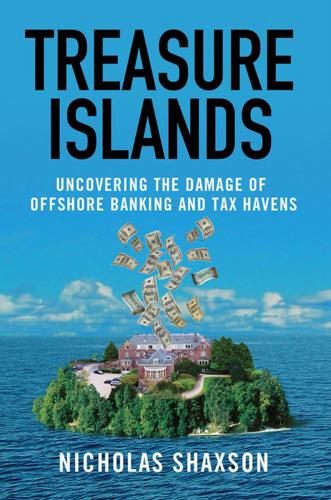
Treasure Islands: Uncovering the Damage of Offshore Banking and Tax Havens
by
Nicholas Shaxson
Published 11 Apr 2011
A couple of other small European micro-state havens are worth noting, including Monaco and Andorra, with occasional cameo roles from odd places like the Portuguese Islands of Madeira, which was central to a major Nigerian bribery scandal involving the U.S. oil service company Halliburton17 that resulted in the second largest fine ever paid in a prosecution under the Foreign Corrupt Practices Act. The second offshore group, accounting for about half the world’s secrecy jurisdictions, is the biggest. This is a layered hub-and-spoke array of tax havens, centered on the City of London, which mostly emerged from the ashes of the British empire.18 As I will show, it is no coincidence that the City of London, once the capital of the greatest empire the world has known, is the center of the most important part of the global offshore system.
…
He soon began looking further afield: first targeting an estimated 2.5 million U.S. expatriates around the world, then the British postimperial expatriate networks, then traders in Hong Kong, settlers in Kenya, French rubber-planters in Laos and Vietnam, Belgian miners in Congo, the Lebanese in West Africa, the overseas Chinese, and so on. He took money with no questions asked and an assurance that depositors’ secrets would be safe. When he bought his first airline, a joke went around inside IOS that he was starting up “Capital Flight Airlines,” and its couriers, according to Tom Naylor’s book Hot Money, spirited huge sums out of developing countries. “As civil war raged in Nigeria and international relief for the traumatised civilian population rolled in, “ Naylor wrote, “IOS was on the scene to help: the international aid funds often wound up in the safe in Geneva.”
…
Moreover, the second most important tax haven in the world is located on an island. It is a city called London in the United Kingdom.”36 Jason Sharman, an Australian academic, checked how easy it was to set up secrecy structures, using the Internet and those seedy offshore advertisements that infest the back pages of business publications and airline magazines. In his report published in 2009 he records making forty-five bids for secret front companies. Money laundering controls seem to be in operation patchily, but of those 45 bids, 17 companies agreed to set them up without even checking his identity. Only four of these were in the “classic” havens like Cayman or Jersey, while the other 13 were in countries from the wealthy Organisation for Economic Cooperation and Development (OECD), including seven in Britain and four in the United States.

City on the Verge
by
Mark Pendergrast
Published 5 May 2017
Over the next three years, Woolard and Gravel held neighborhood meetings, first in District Six, then, when she became city council president in January 2002, in all the BeltLine communities.* In April 2002, Maria Saporta, longtime reporter for the Atlanta Journal-Constitution, gave the BeltLine its first press coverage. The MARTA system was “woefully inadequate,” Saporta noted. “By using existing railroad rights of way, Atlanta could build on its hub-and-spoke transit system. Perhaps more importantly, it could open thousands of acres to urban redevelopment.” She quoted Woolard: “For the inside-the-Perimeter gang, we need a vision,” and the BeltLine was it. Besides, what else could you do with the corridor? “People can have either kudzu and vagrants, or a very big train, or this.”
…
Also, as part of his graduate work, he had compiled a facilities inventory for the Atlanta Public Schools, which took him into every city neighborhood. “My experience touring around, combined with knowledge of the old rail lines, got me interested in how connected these communities could be.” He realized that four of those lines—originally the Atlanta & Richmond Air-Line Railway, Seaboard Air Line Railway, Atlanta & West Point Belt Line, and Louisville & Nashville Railroad Belt Line—encircled the city, within two or three miles of the downtown area, and ran through dozens of diverse neighborhoods. By the late 1800s, a spiderweb of rail lines had converged in Atlanta’s congested downtown area.
…
For the long warm season, April to September, they extended the Peachtree line in a ninety-degree turn to the east to Ponce de Leon Springs, in the watershed that produced Clear Creek. There, like the legendary Florida “Fountain of Youth” of Spanish explorer Juan Ponce de Leon, the waters supposedly possessed curative powers. Railroad workers building the Atlanta & Richmond Air-Line Railway, the first rail constructed on what is now the BeltLine loop, had discovered two springs in 1868. The rail line was completed in 1871 and renamed the Southern Belt Line by 1894. The water tasted of sulfur, but the crew credited it with helping to cure their various afflictions. This health spa eventually became an amusement park, with a four-acre lake on the north side of the tracks.
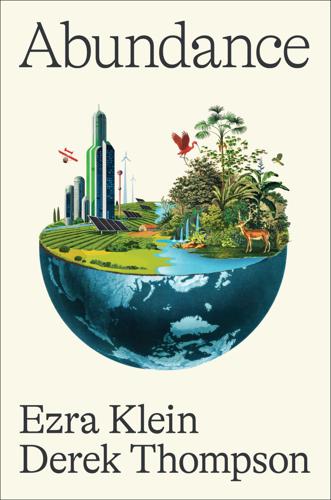
Abundance
by
Ezra Klein
and
Derek Thompson
Published 18 Mar 2025
They are founded on new principles and new conceptions, which in turn are painstakingly developed by research in the purest realms of science.60 It was a dreamy—even radical—depiction of American science. Rather than rely on private philanthropy, or the closed-door laboratories of corporate behemoths, Bush saw the future of science as a kind of hub-and-spoke system, with the federal government directing funds to the most deserving university researchers. Bush’s vision of a government organization for science funding led to the creation of the National Science Foundation (NSF) in 1950. As OSRD wound down—its charter depended on a wartime designation—contracts for medical research were transferred to the National Institutes of Health (NIH).
…
“That the individual share in those social decisions determining the quality and direction of his life; that society be organized to encourage independence in men and provide the media for their common participation.”4 Policy is downstream of values, and by the 1970s, Washington was a changed place. Jimmy Carter, a Democrat, deregulated large parts of the economy, including the trucking and airline industries.5 In the 1980s, Ronald Reagan slashed the high tax rates that Harry Truman had imposed and that Dwight Eisenhower had kept.6 Much of even the liberal legislation of the age—including the major environmental bills we’ve discussed throughout this book—worked by centering the individual, making it easier for Americans to slow the government by suing it.
…
Tom Hayden, The Port Huron Statement, written for the Students for a Democratic Society, June 15, 1962. Courtesy Office of Sen. Tom Hayden, https://images2.americanprogress.org/campus/email/PortHuronStatement.pdf. 5. Motor Carrier Act, 94 Statute 793, Public Law 96-296, 96th Congress (1980) (enacted), https://www.govinfo.gov/content/pkg/STATUTE-94/pdf/STATUTE-94-Pg793.pdf#page=1; Airline Deregulation Act, 92 Statute 1705, Public Law 95-504, 95th Congress (1978) (enacted), https://www.govinfo.gov/content/pkg/STATUTE-92/pdf/STATUTE-92-Pg1705.pdf. 6. Tax Foundation, “Historical US Federal Individual Income Tax Rates & Brackets, 1862–2021,” August 24, 2021, https://taxfoundation.org/data/all/federal/historical-income-tax-rates-brackets/; Adam Carasso and Gene Steuerle, “A Brief History of the Top Tax Rate,” Tax Policy Center, November 25, 2002, https://www.urban.org/sites/default/files/publication/59856/1000459-A-Brief-History-of-the-Top-Tax-Rate.PDF; Josephine Nesbit, “5 Presidents Who Raised Taxes the Most, and 5 Who Lowered Them: Is Trump One of Them?

The Bicycling Guide to Complete Bicycle Maintenance and Repair: For Road and Mountain Bikes
by
Todd Downs
Published 16 Mar 2005
Special lacing patterns, alternative spoke materials, and computer design are all employed to take into account the various stresses a rider applies to a mountain bike wheelset through drive-torque, hard braking, and highand lowspeed maneuvering over rough terrain. Freeride and downhill mountain bikers use wheels that are designed to be almost indestructible, with heavy rims, tires, hubs, and spokes. Unlike cross-country wheels, weight is a secondary consideration for downhill racing, where races are won and lost in tenths or even hundredths of a second, so reliability is paramount. This is even more so in freeriding, where anything less than ultimate durability could result in serious injury.
…
To work on a bike-mounted wheel, suspend the bike from the rafters, fasten it in a repair stand, or simply upend it so the wheels can turn freely. At least once a month, clean the wheels with a rag or with soap and water (keep it away from the hub bearings and brake discs). Inspect the tires for cuts. If they're grimy, wipe down the rims, hubs, and spokes with a clean cloth lightly dampened with a solvent such as rubbing alcohol. (Again, keep the solvent away from the hub's bearings.) Brake pad material that accumulates on the rim can interfere with braking performance and is tough to dislodge. Use an abrasive pad or mild-grade steel wool to remove this residue.
…
If you don't want to double the box, you can simply put in pieces of cardboard on the sides of the box to reinforce it. Or, if you have some ¼-inch plywood or old paneling, use pieces of that to reinforce the cardboard. Keep in mind that airlines charge an additional fee for bringing your bike on the plane. It's often cheaper to ship the bike using UPS or FedEx. This is also easier than dragging the bike through the airport. In today's time of heightened security awareness, it's best not to try to fool the airlines by disguising boxes or lying about their contents. It could mean the difference between making your flight and spending 3 hours in a security shakedown. The step-by-step instructions on boxing a bike that begin on the opposite page refer to mechanical skills described later in the book.

The Stack: On Software and Sovereignty
by
Benjamin H. Bratton
Published 19 Feb 2016
Airports, even in the deep national interior, contain within them legal international borders, safe zones, duty-free zones, security screens, unsafe and quarantine zones, and other liminal jurisdictions and complementary policing programs. Looking at airports as a model for intermodal information exchange, we see that the global mobility of people and things is possible in part because of the protocological standardization of an interfacial network of airports and cities, arranged by increments of first-person travel time, hub-and-spoke econometrics, and its flattening affectless provisionality of boarding lounge culture. Movement through the airport's multistage rituals of filtering and sorting paces the User through densely juxtaposed police and leisure zones. Security agents examine and handle your person in ways usually reserved for criminals and sans-papiers as you pose in the midst of the leisure corridors where summary versions of human culture have been miniaturized into inspirational magazines and the unchallenging solicitations of snack food.
…
But not only is the totality of The Stack itself deeply unstable, it's not clear that its abyssal scope of addressability and its platform for the proliferation of near-infinite signifiers within a mutable finite space are actually correspondent with the current version of Anthropocenic capitalism. Concurrent to its immediate programs, deep address also distributes a mesh over existing supply chains that has the potential to destabilize their closed hub-and-spoke topologies. The valorization of the node within a decentralized network provides to it a certain degree of autonomy to form new edges on its own without the permissive provision from a central authority, market, or provider. The apparently irreducible plane of the addressable landscape begins to percolate with odd links and “conversations” between unpredictable pairings of sender and receiver.
…
Our design interest therefore is not aligned with a notional sustainability conceived as conservative homeostasis, but with the force routes of a disequilibrium that reverberate through matter and transform the world in creative rhythms, slow and fast, including especially its plastics and fleshes. The Cloud layer, just above the Earth layer in The Stack, makes epic, rapidly expanding energy demands (the total carbon footprint of the world's data centers has already surpassed that of the airline industry and is presumed to triple by 2020), and so risk is not hard to find. Data centers are located to mitigate cost and uncertainty, away from likely natural disasters, in proximity of cheap or clean energy sources, diverse power grid interconnects, favorable land use zoning, and inexpensive intermediate bandwidth, for example.51 Because there is no planetary computational economy that is not first a planetary energy economy, the limits to growth for The Stack are not only Moore's law and Shannon's law (accelerating the speed of processors and squeezing more information into existing channels) but also, and perhaps foremost, to secure the energy necessary to power those data centers, smart cities, homes, cars, roads, smart objects, and phones, as well as the real costs (or benefits) of doing so at the expense of other infrastructure, like new roads and buildings.52 In principle, there is a potentially virtuous correlation at work for innovation across computation and energy sectors, and the gamble on that potential is another generative accident of the Earth layer.
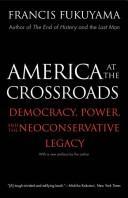
America at the Crossroads: Democracy, Power, and the Neoconservative Legacy
by
Francis Fukuyama
Published 20 Mar 2007
Now that NATO has twenty-six members, it is reasonable to seek a different type of decision-making process, based on weighted votes or delegation to a smaller executive committee. There is room for considerable creativity in designing other new multilateral security organizations. East Asian security, for example, has been based since the end of the Second World War on a bilateral hub-and-spoke system of alliances centered on Washington. Cold War bipolarity has given way, however, to a more complex situation: North Korea has become the chief short-term regional security threat; China presents a long-term danger but can be helpful with Korea now; South Korea has moved to- Rethinking Institutions for World Order ward North Korea and away from the United States; and Japan seeks to use the U.S. alliance to balance China and North Korea.
…
The United States led the way in the reversal of this trend, partially dismantling its postwar welfare state. American markets had always been less regulated than their European counterparts, and the difference became even more conspicuous in the last two decades of the twentieth century as the United States deregulated airlines, telecommunications, electricity, and other services. This unleashed a wave of technological innovation and growth that was associated with the information technology boom of the 1990s. Americans are justly proud of their role in inventing the transistor, the integrated circuit, the personal computer, and the In- American Exceptionalism ternet.

WTF?: What's the Future and Why It's Up to Us
by
Tim O'Reilly
Published 9 Oct 2017
It’s easy to conclude that two companies selling similar products and services are in the same business; the Beams argued otherwise. Yes, Southwest is an airline like any other, but its business model—the way all the pieces work together to create customer value and company advantage—is very different from that of an airline company using the more traditional hub-and-spoke model. In a similar way, we were trying to understand what made us different from our competitors in the technical book and conference business. As part of the exercise, the Beams ask their clients to develop a vision of their core strategic positioning and a vision of who they want to become.
…
Dan and Meredith help companies build maps of their business models—one-page pictures that describe, to use their words, “how all the elements of a business work together to build marketplace advantage and company value.” The Beams used Southwest Airlines as one of their examples, basing their business model map of Southwest on work originally done by Michael Porter. As you can see from the diagram on the next page, various differentiating factors in Southwest’s model all go together. No seat assignments, point-to-point routes, no interconnection with other airlines: all are part of a strategy that allows Southwest to offer low fares with lean ground crews and rapid turnaround. It’s easy to conclude that two companies selling similar products and services are in the same business; the Beams argued otherwise.
…
For the women and men who drive with Uber, our app represents a flexible new way to earn money. For cities, we help strengthen local economies, improve access to transportation, and make streets safer. When you make transportation as reliable as running water, everyone benefits. Here’s a possible business model map for Uber or Lyft like the one Dan and Meredith Beam drew for Southwest Airlines. What are some of the core elements of this business model? Replacing Ownership with Access. In the long run, Uber and Lyft are not competing with taxicab companies, but with car ownership. After all, if you can summon a car and driver at low cost via the touch of a button on your phone, why should you bother owning one at all, especially if you live in the city?
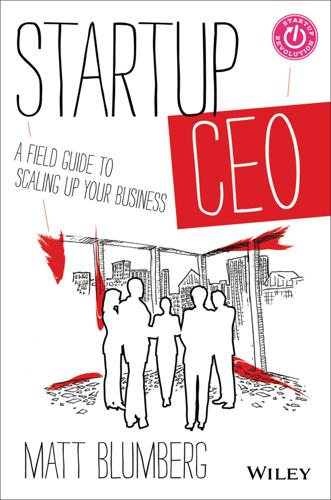
Startup CEO: A Field Guide to Scaling Up Your Business, + Website
by
Matt Blumberg
Published 13 Aug 2013
We were up front with the team at Authentic Response when we started that sale process and we instituted retention bonuses to make sure we kept people engaged. I think we made the right call on it but it was really difficult to get through. That said, it would have been unthinkable for us to just sell off the business and spring it on employees as a fait accompli. Management Moment Don’t Run a Hub-and-Spoke System of Communications Command-and-control managers often like hoarding information or forcing everything to go through them or surface in staff meetings. There’s no need for that! If you’re a senior manager, almost everyone on your team should have individual bilateral relationships and regular one-on-one meetings without your being there.
…
But if your TAM is $1 billion and there are four companies going after it, you are unlikely to see $1 billion in revenue any time soon. Pay careful attention to indirect competitors or substitute products. These will eat away at the TAM, even if you don’t think of them as a competitor. For example, if you were starting an airline running between New York and Washington, D.C., you’d look at Amtrak as a substitute product even though it’s not an airline. Cost Structure and Revenue Streams The financial part of the Lean Canvas isn’t about creating a profit-and-loss statement (P&L). It isn’t about convincing someone to invest in your business. It’s helping you articulate what the basic numbers will or should look like on your path from idea to functional prototype, or MVP.
…
in the early 2000s, one of his employees described Terry’s method of communication: “sitting in between Terry and the Internet is a secretary and a printer.” He had his emails printed out, wrote his responses longhand, and then had the secretary type them in. He didn’t use the Internet. Seriously. Can you imagine Twitter CEO Dick Costolo not tweeting? Or the CEO of General Motors driving a Mercedes? Or the CEO of American Airlines being afraid of flying? I’m not saying that an overweight middle-aged white guy can’t be the CEO of a company that makes beauty products for hip, young Latina women, but it sure is tough to have a high degree of credibility within your organization if you are that personally disconnected from what your company does.
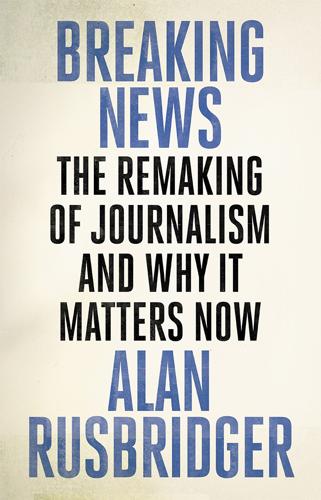
Breaking News: The Remaking of Journalism and Why It Matters Now
by
Alan Rusbridger
Published 14 Oct 2018
But the real envy in Fleet Street commercial departments was directed at the Telegraph, which was still turning in profits in excess of around £55 million before tax. Editorially, it may have been unstable, chopping and changing editors and switching directions of travel. In November 2009 its then editor, the ambitious 40-year-old Will Lewis,15 decamped from the shiny new hub-and-spokes newsroom in Victoria to set up a digital outpost near Euston station in North London. He was given a large budget and a team of 50 in order to ‘capitalise on cutting edge ideas’ and ‘drive new revenue streams’.16 Six months later Lewis was gone; a year later the Euston Project was no more. Nevertheless, the paper kept throwing off cash.
…
Proudler began an investigative journey of her own, demanding all the relevant financial statements from Aitken’s solicitors. We were not to get sight of them until 12 June, more than a week into the hearing. From those records – car rental, airline tickets, etc. – Proudler was able painstakingly to piece together Lolicia’s movements. It took time. British Airways’ own microfilm archive was held in a warehouse near Heathrow. The airline estimated it could take more than a month to provide the clinching evidence. Proudler offered them help. The detective trail was moving agonisingly slowly. Back in court, Aitken was by now so confident of success he played one last daring card.
…
‘Is this really something that we would do if we were purely digital?’ became the key question. * The division (including the Observer losses) was due to lose £9 million in 2000/1. Circulation was still over 400,000 but all papers were beginning to pad out their figures by distributing ‘bulk’ copies either abroad, or in hotel chains, airlines and trains. Advertisers, it seemed, were none too fussy about whether a reader had parted with cash for a newspaper or whether the copy ‘sale’ had, in effect, been ‘subsidised’ by the publisher. Headline numbers seemed fine. It was the dying light of the broad-brush world. Within a decade advertisers would want scrutiny of figures down to the level of individual users.

Arriving Today: From Factory to Front Door -- Why Everything Has Changed About How and What We Buy
by
Christopher Mims
Published 13 Sep 2021
Once fully loaded, these semitrailers will take packages to their second-to-last destination, the yet smaller warehouses where they are put on vans and delivery trucks and carried to homes and businesses. One such delivery station is attached to this sortation center. In the past, says Ted, FedEx and other carriers relied on a hub-and-spoke model to take packages from large central facilities through ever smaller ones, like blood flowing from the heart into arteries and, ultimately, individual capillaries. Now the model is, by necessity, quite different. The entire network is more of a “mesh,” a system in which every single ground station can both sort packages and get them onto delivery vehicles.
…
C., 159 “essential” workers in pandemic, 90 Estonia, manufacture of Starship robotic delivery systems in, 270 Evergreen, 22 Every Which Way but Loose (film), 109 FAA (Federal Aviation Administration), 264 Facebook, 74, 231 factory system: Amazon fulfillment centers resembling, 170; incorporation of supply chain into, 2, 90–92 Fair Labor Standards Act, 279 Fanuc industrial robot arm, 159–60, 193 Fast Company, 237 Fauci, Anthony, 108, 195 Federal Aviation Administration (FAA), 264 Federal Motor Carrier Safety Administration, 124 Federal Trade Commission (FTC), 168 Federal-Aid Highway Act (1956), 128 FedEx, 107, 155, 244, 245, 252, 253–62, 265, 276, 278, 280 FedEx Ground, 256 Field, Sally, 109 fissured workplaces, 278, 280 5S, 228 Fizyr (robotics company), 246 flag state and flags of convenience, 32 Flaubert, Gustave, 274 Flinn, Craig, 49–55, 57, 61, 64 flywheel, 231 Ford, Henry, Ford Motor Company, and Fordism: Amazon warehouses and robotic warehousing, 163–64, 184; Bezosism and, 198, 207, 214–16, 219, 220, 231; scientific management (Taylorism) compared, 91, 99–101; supply chain in, 2, 8, 12 Forditis, 216 Foxconn (Hon Hai Precision Industry Co.), 17–18, 221 freight brokers and trucking companies, 134–39 Freud, Sigmund, 87 Frontline (PBS documentary series), 201 FTC (Federal Trade Commission), 168 fulfillment center, concept of, 169–70 “fulfillment center alley,” 217, 242, 245 Galetti, Beth, 237 Gallard, Robert, 114–18, 120–21, 125–26, 133, 134, 135 gantry cranes, 78–79 Gantt, Henry, and Gantt chart, 98 Gap, 168 Garcetti, Eric, 72 gemba walks, 227, 229 General Electric, 104, 204, 221–23 General Motors (GM), 8, 154, 177, 247 Generation Z, 235, 266 George, Rose, Ninety Percent of Everything, 113 George Mason University (VA), 263–66, 268 Germany: Autobahn, 130–32; Hamburg, port of, 79 gig economy, 91, 102 Gilbreth, Frank and Lillian, 89–90, 98, 102–4, 185; Cheaper by the Dozen (memoir by Gilbreth children, 1948), 89–90; The Psychology of Management (Lillian Gilbreth), 103 Gladwell, Malcolm, 97 GLONASS, 64 GM (General Motors), 8, 154, 177, 247 Goddard, Robert, 143–44 Google, 142, 153, 184, 204, 231 Google Classroom, 7 Google Maps, 50, 120, 123, 126, 283 Google smartphone, 16 Government Accountability Office, 240 GPS, 37, 59, 64, 118, 120, 143, 145–46, 217, 268 Great Depression, 250, 278 grooming, 83 Gross, Bill, 167 Grubhub, 266 Guendelsberger, Emily, On the Clock, 200, 202–3, 205, 208, 219, 220, 234 Guillet, León, 102 Gutelius, Beth, 233–35 Gyeongsangnam-do, South Korea (shipyard), 26 gyrocompass, electronic, 37, 42 Hagerstown, MD, FedEx sortation center in, 253–61 Hamburg, port of, 79 Hamilton, Tyler, 171–76, 179, 186, 205, 206 harbor pilots, 36–37, 47, 49, 50, 54–55, 58–61, 63, 65 Harper’s Weekly, 103 Hemingway, Ernest, 98 High-Ballin’ (film), 109 high-speed sorter, 190 Hitler, Adolf, 128, 130–31, 144, 145 HMPE (high-modulus polyethylene), 60 Hoffa, Jimmy and James P., 277 Hon Hai Precision Industry Co. (Foxconn), 17–18, 221 Hong Kong, as port, 40, 48 Hou, Xiaodi, 152, 153–54 hub-and-spoke model of delivery, 261–62 Hubei Province, China, 6 Hyperloop, 79 Hyundai Merchant Marine, 26 I Love Lucy (TV show), 191, 213 idle time, 74–76, 137–39, 268 ILWU (International Longshore and Warehouse Union), 69–74 immigrants and immigration, 94, 249 IMO (International Maritime Organization), 28–29 IMUs (inertial measurement units), 143–45, 147, 268 income inequality, 3, 74 Industrial Revolution, 91, 92, 94, 212, 214–15 injury.
…
The totality of all these forces is that putting a ship as colossal as the Netherlands through a channel of these dimensions is more like forcing a fencepost down a rain gutter than floating a paper boat down a stream. Just ahead is the Vincent Thomas Bridge. After passing the Iowa, John stops the ship’s engine completely. The rest of his maneuvers, until the moment the ship is alongside the berth, he’ll complete using only the vessel’s residual momentum, like an airline pilot coming in on an emergency dead-stick landing. It’s low tide, so as the Netherlands comes under the bridge, the highest point on its superstructure comes within ten feet of the bridge’s underside. If this were high tide, clearance would be just eight inches. Regulations say that a ship must be at least two and a half feet lower than the bottom of the bridge, which is just enough to account for variability in the height of the bridge as it sags in summer heat or under the weight of heavy traffic, and also to account for the subtle flexing up and down of a ship at its midpoint, known as hogging and sagging.
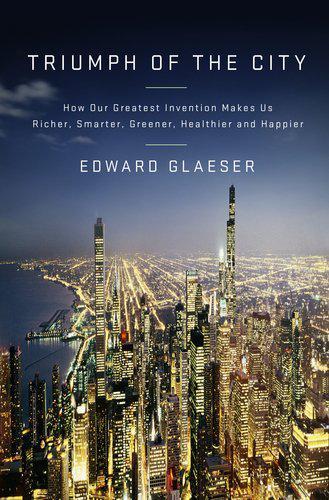
Triumph of the City: How Our Greatest Invention Makes Us Richer, Smarter, Greener, Healthier, and Happier
by
Edward L. Glaeser
Published 1 Jan 2011
Just like today’s Boeing 747s, which land at major hubs and transfer their passengers onto smaller planes that take them to their final destinations, the big clipper ships came to one central harbor and then transferred their goods to smaller vessels for delivery up and down the Eastern seaboard. New York was America’s superport, with its central location, deep, protected harbor, and river access far into the hinterland. When America moved to a hub-and-spoke shipping system, New York became the natural hub. The city’s position was only strengthened when canals made Manhattan the eastern end of a great watery arc that cut through the Midwest all the way to New Orleans. Shipping was the city’s economic anchor, but New Yorkers were more likely to work in the manufacturing industries—sugar refining, garment production, and publishing—that grew up around the harbor.
…
Telephone calls are disproportionately made among people who are geographically close, presumably because face-to-face relationships increase the demand for talking over the phone. And when countries become more urban, they engage in more electronic communications. Certainly some people still work alone, handling customer complaints or airline reservations, perhaps, over the phone in some spot far from any city. However, most of those jobs require less skill and accordingly pay less. In the average U.S. county with less than one person per acre, 15.8 percent of adults have college degrees. In the average county with more than two people per acre, 30.6 percent of adults have college degrees.
…
The World Bank rates Singapore as having the world’s best logistics for trade and transport. Good infrastructure and the rule of law helped lure foreigners who brought their skills to the island, and Singapore makes it especially easy for them to come by maintaining a superb airport and national airline. Singapore attracts expatriates, in part, with a quality of life that is remarkably high, given its minute land area, absence of natural resources, and sweltering location right on the equator. While New York City could readily import water from upstate via the Croton Aqueduct, Singapore has no hinterland and inherently lacks water.
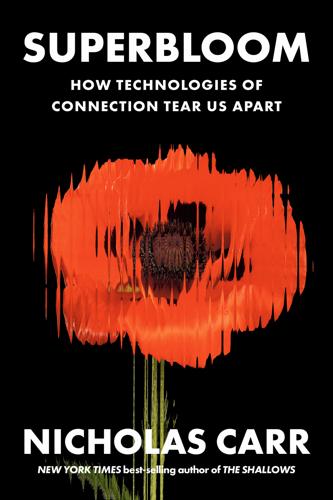
Superbloom: How Technologies of Connection Tear Us Apart
by
Nicholas Carr
Published 28 Jan 2025
Across five hundred pages of dense, suitably technocratic prose, he argued that “the Internet revolution” was well on its way to supplanting mass media’s centralized “industrial information economy” with a radically decentralized “networked public sphere.” Spurring the epochal transformation were two developments, one technical, the other economic: The first element is the shift from a hub-and-spoke architecture with unidirectional links to the end points in the mass media, to distributed architecture with multidirectional connections among all nodes in the networked information environment. The second is the practical elimination of communications costs as a barrier to speaking across associational boundaries.
…
On television, half-hour news programs, aired around dinner time, provided fast-paced, visual summaries of the day’s events. Talk shows such as 60 Minutes and Meet the Press offered longer reports on topics and controversies of the moment, often including interviews with public figures. TV bulletins were reserved for momentous events—an assassination, an airliner crash. Radio news offered a bit of everything, with some stations broadcasting news all day, others giving brief reports on the hour, and still others giving longer roundups in the evening. While the content of the various news media overlapped, their reports were complementary, entailing different journalistic methods, levels of detail, and political perspectives.

The Power of Pull: How Small Moves, Smartly Made, Can Set Big Things in Motion
by
John Hagel Iii
and
John Seely Brown
Published 12 Apr 2010
And Industry Value Networks (IVNs) brought together customers to address issues specific to particular industries—for instance, bank managers looking to develop software interfaces to help them collaborate more effectively. SAP realized that collaboration among participants was essential, and it designed these creation spaces to encourage peer-to-peer interactions. The creation space replaced the hub-and-spoke model that technology companies had traditionally used in their sponsored communities and networks. To further demonstrate NetWeaver’s capabilities, SAP built each of its new networks on the NetWeaver platform. The results have been impressive, not only in the scale of the creation space but in the learning and performance improvements it has produced.
…
First, they often involve a single company making significant commitments to a disruptive innovation in technology or business design, rather than an individual or group bringing together very large numbers of companies to make complementary investments. Think of the iconic examples of disruptive innovators such as Nucor or Southwest Airlines. These companies bet big, but they largely bet alone. On one hand, for those who win in pursuing disruptive innovations, the prize is very large because it does not have to be shared with anyone else. On the other hand, there is little opportunity to manage risk by sharing investment across large numbers of players.
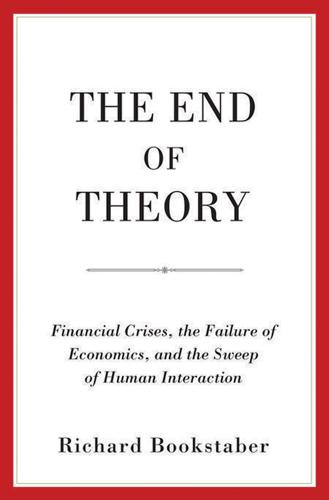
The End of Theory: Financial Crises, the Failure of Economics, and the Sweep of Human Interaction
by
Richard Bookstaber
Published 1 May 2017
If you cannot know the string of numbers without writing out the numbers one by one, that is not much different from not knowing the course of future states without going through each of those states. Connectedness and Complexity The concept of connectedness and complexity measures how one action can affect other elements of a system—that is, it measures the complexity of interactions. A simple example of connectedness is the effect of a failure of one critical node on the hub-and-spoke network of airlines. When snow shuts down Chicago’s O’Hare airport, a lot of people are going nowhere, even those in sunny Orlando. Dynamical systems also emerge from the actions and feedback of interacting components. Herbert Simon posed a fractal-like measure of system complexity by looking at the layering of hierarchy, that is, the depth to which a system is composed of subsystems, which in turn are composed of yet deeper subsystems.

The Post-American World: Release 2.0
by
Fareed Zakaria
Published 1 Jan 2008
As the political scientists Naazneen Barma, Ely Ratner, and Steven Weber point out, in a world where everyone feels empowered, countries can choose to bypass this Western “center” entirely and forge their own ties with one another.9 In a post-American world, there may be no center to integrate into. U.S. Secretary of State James Baker suggested in 1991 that the world was moving toward a hub-and-spoke system, with every country going through the United States to get to its destination. The twenty-first-century world might be better described as one of point-to-point routes, with new flight patterns being mapped every day. (This is true even in a physical sense: in just ten years, the number of Russian visitors to China increased more than fourfold, from 489,000 in 1995 to 2.2 million in 2005.)
…
When it comes to terrorism, the United States has been too narrow-minded. The best systemic protection against the threat of terrorism would be a global set of customs and immigration controls that checks people and cargo around the world, using the same standards and sharing databases. As it is now, America’s unilateral approach forces countries and airlines to comply, but only at its own borders—creating chokepoints, with negative consequences for the economy and for America’s image in the world. That’s why, in the midst of a worldwide tourism boom, travel to the United States has been sluggish ever since 9/11. The more significant ongoing example of this tension has to do with nuclear proliferation.
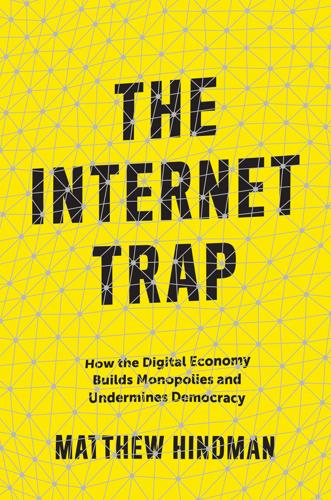
The Internet Trap: How the Digital Economy Builds Monopolies and Undermines Democracy
by
Matthew Hindman
Published 24 Sep 2018
—Tracy Kidder, The Soul of a New Machine, 1981 Somewhere around 1790, New York City grew to 32,000 inhabitants, and passed Philadelphia as the largest city in North America. New York’s early emergence as America’s metropolis was driven by both new technology and natural advantage.1 While shipping in the 1700s had mostly followed a point-to-point pattern, larger ships and speedier passage across the Atlantic meant a shift to a hub-and-spoke model with New York as the cheapest shipping hub. New York’s harbor was deeper than Philadelphia’s, and less likely to freeze in winter. The Hudson River provided better access to the interior of the continent, an advantage that grew when the Erie Canal connected New York with the Great Lakes and the Midwest.
…
Critically, many tactics that promote stickiness get cheaper per user as sites get bigger. The internet thus provides economies of scale in stickiness. Bigger, more popular sites and platforms thus find it easier to attract still more visitors, and to build up habits of readership. The economies of scale that shape countless traditional industries, from airlines to automakers, remain powerful in the digital economy. Understanding digital audiences starts with digital economies of scale. This chapter does not attempt to provide an exhaustive list of every online economy of scale—that would require a much longer chapter. Rather, the goal is to highlight some of the most powerful and bestdocumented forces that skew the game toward the largest players.

The Code: Silicon Valley and the Remaking of America
by
Margaret O'Mara
Published 8 Jul 2019
And, in those very buggy days of early programming, they could only run the program in the first place after they’d spent considerable time refining their instructions—another stage that took even more time and further batches of cards. There had to be a better way. The fix, argued McCarthy, was to adapt a mainframe so that multiple users could work with the machine at once, creating a hub-and-spoke system with a mainframe at the center and user terminals at the periphery, networked by coaxial cable. Instead of waiting, users could receive results in seconds, and immediately try again if there were errors in the data. Instead of submitting punch cards, people would type instructions on terminals, in real time.
…
Hart, known as the “conscience of the Senate,” introduced a sweepingly antimonopolistic “Industrial Reorganization Act” into Congress. Hart described it as “the greatest effort which has been put forth to finding a solution for economic concentration.”31 The adverse effects of this concentration on consumers seemed obvious when it came to the computer industry. Automation of everything from paychecks to airline reservations may have increased business efficiency, but it created everyday hassles when the system messed up. Every misdirected utility bill or lost hotel booking became a proof point for the computer skeptics. Industry executives found themselves on the defensive. “Perhaps if we look inside a little bit,” one protested to Hart’s committee, “you’ll observe that it is not a computer that ever makes a goof; it’s the people who use it and the people who write programs for it.”32 Baby-boomer activists Lee Felsenstein and Liza Loop never would have imagined they’d have much in common with a suit-and-tie executive of a big computer company.
…
JET CITY William Henry Gates III was a Cold War kid from Seattle, born and bred in a place and time where opportunities abounded for a curious boy to learn about computers. His childhood coincided with the apex of Seattle’s Boeing boom, when the aerospace giant employed hundreds of thousands and produced successive generations of innovative commercial airliners at an astonishingly rapid pace. Seattle was also home to the University of Washington and its multiple federally funded science and engineering programs, including in the new academic discipline of computer science. The city of modest bungalows sprawled into a metropolis of millions, as highways snaked through neighborhoods and floating bridges unfurled across the lake to connect the Eastside suburbs.

The Sirens of Mars: Searching for Life on Another World
by
Sarah Stewart Johnson
Published 6 Jul 2020
I didn’t want mere pieces of that mighty system, some surficial understanding. I wanted the coherent whole. * * * — THE MARS PLANNING map that hangs in my office is full of cartographic detail—a panoply of features and names. But if you step back a bit, what first catches the eye is the light and the shadow. All across the map are hubs and spokes: an extensive interconnected system of perfectly straight lines. The crisscrossing patterns are the color of smoke. They’re not black, not unambiguous, but they are impossible to miss. They decorate the surface like a Victorian lace collar. The lines date to the late 1800s, when they were first extensively recorded by Giovanni Schiaparelli, an astronomer in Milan who would forever change our vision of the planet.
…
He’d met every engineer and considered every failure path. I’d done nothing to help get those rovers to Mars, but because of his hard work, I’d been given the chance to zoom to the very epicenter of modern planetary science, where everything was shot through with light. Instead of packing for my flight home, I called the airline. I couldn’t stop smiling when the woman on the phone confirmed, “Return indefinite.” * * * — THERE WAS NO shortage of fascinating work. As we inched below the western ridge of Endurance Crater, we realized the rocks were stippled with blueberries all the way down. And as we looked at orbital images, it seemed that the same geologic formation probably extended tens if not hundreds of meters down and kilometers across.

Wired for War: The Robotics Revolution and Conflict in the 21st Century
by
P. W. Singer
Published 1 Jan 2010
In turn, it is also unclear which one will prove to be the best. Indeed, the choices may mix and mingle. Some envision that the concepts of swarms and motherships could be blended, with the human commanders inserting themselves at the points where swarms start to cluster. It wouldn’t be the same as the direct control of the mothership’s hub and spoke system, but it would still be a flexible way to make sure the leader was influencing what’s going on at the major point of action. Whatever doctrine prevails, it is clear that the American military is getting ready for a battlefield where it sends out fewer humans and more robots. And so, just as the technologies and modes of wars are changing, so are the theories of how to fight them.
…
That they even had the authority to do so was again because of Aegis; Robo-cruiser was the only ship in the area authorized to fire without having to seek permission from more senior officers in the fleet. Again, the computer was trusted even more than any human captain’s independent judgment on whether to shoot or not. The Aegis system took out the jet. Only after the fact did the crew realize that they had accidentally shot down an airliner, not a fighter jet, killing all 290 passengers and crew, including 66 children. This tragedy demonstrates how a redefinition is already taking place of what it means to have humans “in the loop” over autonomous systems and their weapons. As Drew Bennett at iRobot describes, “In ten to twenty years humans will still be ‘in the loop,’ but it will be a wider loop.”
…
For these reasons scientists already see the day coming at which surgeons, who may require the most years of training of all professions, will be replaced by robotic surgery systems like the da Vinci. Rod Brooks of MIT and iRobot predicts that the future for doctors is likely to be the same as for airline pilots: There mainly to appease the patient and regulatory boards and charge exorbitant amounts for skills they rarely use and knowledge that the computer can call up faster and in more depth. By contrast, as one scientist at the Idaho National Lab puts it, “My job will be eliminated before my hairdresser’s will.”
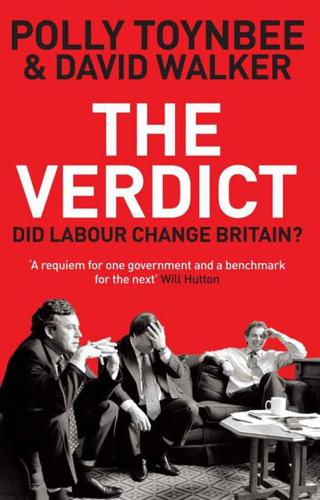
The Verdict: Did Labour Change Britain?
by
Polly Toynbee
and
David Walker
Published 6 Oct 2011
That is a difference; but was it worth all the fuss and professional antagonism? Labour published a national plan in 2000. Despite its Stalinist overtones, this was a consensual and popular document. It ended the internal market created by the Tories, where GPs bought care from competing hospitals. Instead, it envisaged a co-operative hub-and-spoke model, in which GPs referred patients to smaller hospitals, which, in turn, recognizing the limits of their competence, referred them to regional centres of excellence. The plan begot a new contract for GPs, linking payments to clinical and service objectives. The plan meshed with the report commissioned separately by the Treasury from the former banker Sir Derek Wanless, which made the case for a National Insurance increase to pay for increased spending.
…
It retained its twenty-six bishops in the House of Lords, who swung debates on such issues as the right to die. Suddenly, 9/11 made religion political. Even without the attack, shifts in the geology of belief in Pakistan and the Middle East might have shaken the sons of Muslim families settled in the UK. The shoe-bomber, Richard Reid, arrested after attempting to blow up an American Airlines plane to Miami in December 2001, exemplified a new pattern, where young British-born people were radicalized through contact with Wahabi extremism and sent to Pakistan for training to return as human bombs – this was before the Iraq invasion. Labour, as puzzled as the rest at the translocation of fundamentalism to Luton, set itself the subtle task of policing areas of Muslim concentration while persuading adherents into moderation.

Scale: The Universal Laws of Growth, Innovation, Sustainability, and the Pace of Life in Organisms, Cities, Economies, and Companies
by
Geoffrey West
Published 15 May 2017
This unexpected result was first analyzed mathematically by the applied mathematician Steven Strogatz and his then student Duncan Watts.10 They showed that small-world networks typically have an overabundance of hubs and a large degree of clustering relative to randomly connected networks. Hubs are simply nodes with an unusually large number of links associated with them. This is familiar from the way airline companies organize their flight schedules using a “hub and spoke” algorithm derived from network theory. For example, Dallas is a major hub for American Airlines, so in order to fly from almost anywhere in the western half of the United States to New York City on American, you have to go through Dallas. This greater degree of clustering because of this hub structure means that small-world networks tend to contain modular subnetworks, called cliques, which themselves have high connectivity within them so that almost any two nodes are connected.
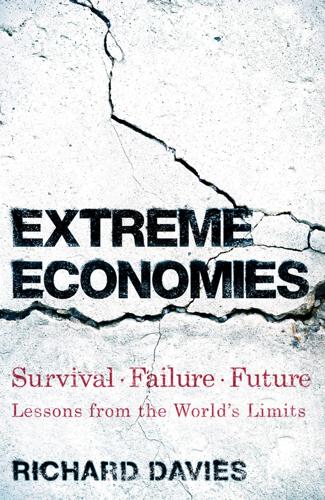
Extreme Economies: Survival, Failure, Future – Lessons From the World’s Limits
by
Richard Davies
Published 4 Sep 2019
Knowing that knafeh – miniature pastry nests with nuts nestling inside – is a strong seller, he makes huge quantities of these and other baked sweets at his main bakery. Doing these big batches keeps costs down, and his employees then transport trays of baked goods to his four outlet kiosks dotted across Zaatari. Offering a taste of Syria is so popular that he is opening a fifth outlet soon. This hub-and-spoke method of cooking and selling food is exactly the so-called ‘dark kitchen’ model now being pursued by Travis Kalanick, the founder of Uber. Other entrepreneurs pull on the refugees’ nostalgia for their lost homeland too. Hamid Harriri’s sweet shop mainly sells knockoffs including ‘Chiko’ chocolate eclairs, an imitation of the Cadbury’s version.
…
Mr Jendi agrees: he must keep switching the styles and colours of the clothes he sells to stoke demand. This on-the-ground wisdom is exactly the sort of lesson taught to budding entrepreneurs on MBA courses, who study the success of companies such as Rolls-Royce – who, in addition to its car manufacturing business, sells aircraft engines to airlines and makes money servicing them – and, more recently, in the business-school obsession with subscription models for music, clothes and food, all designed, as the Syrian entrepreneurs have done, to keep the customer coming back. As I talk with Qaseem, he is soldering away, mending the dynamo on a longstanding customer’s bike.
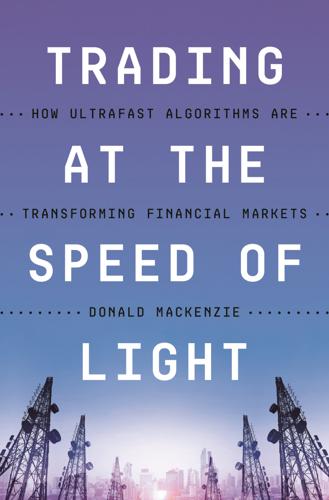
Trading at the Speed of Light: How Ultrafast Algorithms Are Transforming Financial Markets
by
Donald MacKenzie
Published 24 May 2021
For nearly all human purposes, those existing networks were and are amply fast, so that telecoms had not needed to focus on speed of signal transmission. Rather, they chose paths (such as alongside railroad lines) along which it was easy to negotiate permission to dig trenches to lay their cables; they shaped their networks so that they served the maximum number of large population centers; and they often used hub-and-spoke configurations, sending signals not via the most direct path between two points but via their own switches or a meet-me-room in a centrally located datacenter such as Cermak or Halsey, a datacenter in Newark that is the main telecom hub in New Jersey. As will be discussed below, telecom companies also prioritized ease of repair over minimum cable length.
…
Another consortium of major dealers, BrokerTec, was formed, and in 2000 it launched a rival anonymous electronic interdealer trading platform. Cantor was then struck by horrific human tragedy. Its main offices were on floors 101 to 105 of the North Tower of the World Trade Center, above the point at which the hijacked airliner hit the tower on September 11, 2001, and 658 of its brokers and other employees died, more than two-thirds of Cantor’s total workforce. Lutnick’s brother died, and he himself survived only because his son had started kindergarten that morning and he had wanted to accompany him. ESpeed’s computer systems, however, were across the Hudson River in Rochelle Park, New Jersey.

Site Reliability Engineering: How Google Runs Production Systems
by
Betsy Beyer
,
Chris Jones
,
Jennifer Petoff
and
Niall Richard Murphy
Published 15 Apr 2016
To echo the words of Ben Treynor Sloss: by taking the approach that this was a software problem, the initial automation bought us enough time to turn cluster management into something autonomous, as opposed to automated. We achieved this goal by bringing ideas related to data distribution, APIs, hub-and-spoke architectures, and classic distributed system software development to bear upon the domain of infrastructure management. An interesting analogy is possible here: we can make a direct mapping between the single machine case and the development of cluster management abstractions. In this view, rescheduling on another machine looks a lot like a process moving from one CPU to another: of course, those compute resources happen to be at the other end of a network link, but to what extent does that actually matter?
…
This response is especially likely when a team believes that the postmortem process is retaliatory. This attitude comes from subscribing to the Bad Apple Theory: the system is working fine, and if we get rid of all the bad apples and their mistakes, the system will continue to be fine. The Bad Apple Theory is demonstrably false, as shown by evidence [Dek14] from several disciplines, including airline safety. You should point out this falsity. The most effective phrasing for a postmortem is to say, “Mistakes are inevitable in any system with multiple subtle interactions. You were on-call, and I trust you to make the right decisions with the right information. I’d like you to write down what you were thinking at each point in time, so that we can find out where the system misled you, and where the cognitive demands were too high.”
…
Reliability stakes in the nuclear Navy are high—problems that arise in the case of incidents range from damaged equipment, to long-standing environmental impact, to potential loss of life. Matthew Toia is a Site Reliability Manager focused on storage systems. Prior to Google, he worked on software development and deployment of air traffic control software systems. Effects from incidents in this industry range from inconveniences to passengers and airlines (e.g., delayed flights, diverted planes) to potential loss of life in the event of a crash. Defense in depth is a key strategy to avoiding catastrophic failures. Now that you’ve met our experts and gained a high-level understanding of why reliability is important in their respective former fields, we’ll delve into the four key themes of reliability.

The Tyranny of Experts: Economists, Dictators, and the Forgotten Rights of the Poor
by
William Easterly
Published 4 Mar 2014
The Erie Canal meant that a cigar importer like Benjamin now had access to the vast markets of the American interior. Cigars were not the niche item they are today: mid-nineteenth-century Americans consumed 300 million cigars a year. Benjamin also benefited from good transportation links to the rest of the world indirectly created by the Erie Canal. Oceanic shipping was developing as a hub-and-spoke system.13 It was cheaper to run large ships from a hub on one side of the Atlantic to another hub on the opposite side, and then offload the goods onto smaller ships to take them to other ports on each side. With the boost that New York had already gotten from the Erie Canal, it became the hub on the American side.
…
Their extra private payoff does not correspond to a social payoff; it is just redistribution from consumers to producers. The producers are self-restricting their problem-solving for consumers and getting rewarded for doing so. If you think of an industry where there is lots of monopoly power you might notice how they often are lacking in great customer service. Allow this knowledge about the semimonopolistic airline industry to comfort you the next time your luggage gets rerouted to Idaho. Economists since Smith have identified lots of other examples of what they call “market failures.” These include unintentional spillovers of solving one problem that creates new problems (like improved manufacturing processes that nonetheless then contaminate public water supplies).
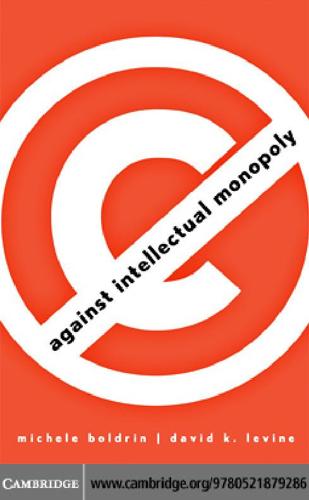
Against Intellectual Monopoly
by
Michele Boldrin
and
David K. Levine
Published 6 Jul 2008
And all of this happened in the complete absence of any form of intellectual monopoly. This story, sadly, is now over. On July 23, 1998, in State Street Bank & Trust Co. v. Signature Financial Group, Inc. , the U.S. Court of Appeals for the Federal Circuit held patentable Signature’s data-processing system for hub-and-spoke financial services configuration. Prior to this ruling, methods of doing business and mathematical algorithms could not be patented. After this ruling, at least insofar as they are embodied in computer code, business methods and algorithms are patentable; in particular, it is now possible to patent financial securities: there are now tens of thousands of patented “financial inventions.”
…
Shakeouts P1: KNP head margin: 1/2 gutter margin: 7/8 CUUS245-06 cuus245 978 0 521 87928 6 May 21, 2008 16:48 134 Against Intellectual Monopoly happen in the market for shoes and in that for lollipops, so we expect them to happen in a competitive market for copies of ideas as well. You may recall when the last shakeout in a competitive market for ideas took place – it was the dot-com bust of 2000–1. Using the Internet to do business, from selling airline tickets to managing your financial portfolio, was a great, innovative idea that someone, perhaps Al Gore, had. Fortunately for us all, it was not yet patentable, and once the first dot-com business was created, other entrepreneurs started to make copies of this idea, and other dot-com companies were created.

The Last Tycoons: The Secret History of Lazard Frères & Co.
by
William D. Cohan
Published 25 Dec 2015
"He didn't do it but kept talking about doing it, which was even worse." Much the same thing would be said over time about Michel. The reasons Cook's efforts flopped were made evident by his comments to the Times. Cook explained that the old Lazard management style--and here he drew a picture of a hub and spokes for the reporter--was a wheel with Meyer at the center. "He was obviously the dominant figure but the wheel-and-hub organization no longer will produce the best results for the firm." In the Cook regime--and here he drew another diagram--Lazard would be run in a pyramid structure, with a board of directors at the top, a CEO beneath the board, and executives reporting to the CEO, a "more classic" corporate structure, he explained: "I'm the resident bureaucrat; what I can do for this firm is be the architect of the transitional period."
…
To the disgust of Lazard's senior partner, Andre Meyer, Rohatyn appeared at the Governor's side during a weekend of particularly momentous meetings on the city's fate last fall, wearing a black turtleneck sweater. His trench coat with button-in lining is the only overcoat he owns and his safari hat from Hunting World is the result of a sudden revelation, walking past that 53rd Street store in the rain, that "my head was getting both cold and bald." He travels with a small vinyl flight bag, the kind the airlines give away free or for next to nothing. But the Times article was one big head fake. Yes, Felix lived at the Alrae, but not alone. He lived there with Gaillet, and it was plenty luxurious, she said, although these facts were never reported. He certainly was not living the life of a bachelor, because she was with him there from the beginning of the affair until its end.
…
Lazard, led by Felix and Luis Rinaldini, his then golden boy, had the lucrative assignment advising the special committee of the RJR board of directors in its consideration of the bids; the firm earned $14 million for its trouble. The true fallout from the crash of 1987, though, did not hit Wall Street until almost two years later, during the summer of 1989, when the financial markets buckled amid the effort to finance the LBO of United Airlines, a $6 billion deal and one of the largest of the so-called employee-owned buyouts. Lazard was advising United, thanks to the management relationships of Eugene Keilin, whom Felix had recruited to the firm from MAC. At the eleventh hour, Citibank pulled its financing commitment for the buyout after failing to syndicate the huge loan package.
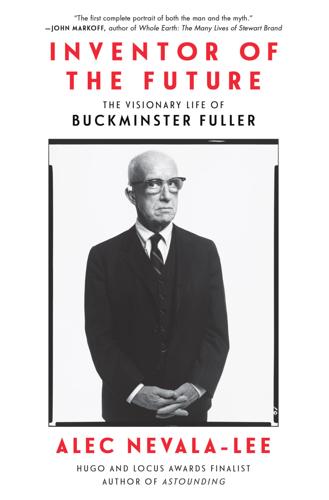
Inventor of the Future: The Visionary Life of Buckminster Fuller
by
Alec Nevala-Lee
Published 1 Aug 2022
Like Fuller, he had wavered between approaching the military or “peaceful types,” and he found a client in the Scottish glaciologist Patrick Baird, who needed a structure to protect equipment on Baffin Island. Lindsay developed a metal “firecracker umbrella” with a nylon shell, which he and Fuller installed for testing on Mount Washington in New Hampshire. Larger domes presented a challenge, partly because their structure was still based on great circles, requiring numerous hub and spoke types. Although Fuller was reluctant to change it, he finally switched to an icosahedral design. To be sturdy enough to stand, the framework of any substantial dome had to be subdivided into smaller triangles, and he decided to divide the faces of the icosahedron into the three-way grid of the Dymaxion Map, even as he continued to overlook the invisible gaps, or “windows,” where the lines failed to cross exactly.
…
As he became publicly known as a Renaissance man, Fuller often spoke on subjects of which he had minimal knowledge, using scraps of information gleaned from newspapers and his own itinerary. He also told Tomkins that he had been marked by travel in another way: “I gained twenty pounds on this last trip. It’s one of the really big problems on this kind of schedule—big, rich dinners everywhere, and all that airline food.” His weight, which normally hovered around 165 pounds, was up to nearly 200. Fuller had always been conscious of how it looked on his short frame, and after experimenting with the chalky low-calorie supplement Metrecal, he decided to base his diet entirely on beef. He justified this approach by arguing that solar energy was impounded by plants and concentrated by herbivores, as his colleague Edgar J.
…
Their partnership would test all of Applewhite’s considerable ingenuity. At his own expense, he joined the roster of travel companions on whom Fuller depended, which often generated insights in itself. On one occasion, before his move to Philadelphia, Fuller’s bags were misplaced at Washington National Airport. When the airline agent innocently asked for his address, Fuller grew red and banged his fists on the counter: “Address! That isn’t the right question. Young man, I live on Planet Earth! Man was born with legs, not roots!” Applewhite noted the exchange quietly for his card index. Much of the writing was done in transit, with one section sketched out on a menu—Fuller loved drawing domes on placemats—at a coffee shop at the Boston airport.
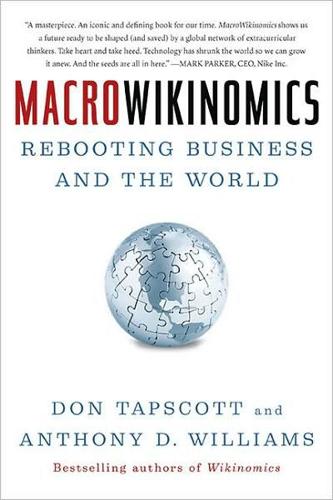
MacroWikinomics: Rebooting Business and the World
by
Don Tapscott
and
Anthony D. Williams
Published 28 Sep 2010
In the meantime, the Iranian democrats have a powerful new weapon with which to expose the regime’s failings. At long last the Internet and the rise of popular social networks have broken the Iranian regime’s stranglehold on power, allowing new groups to communicate and organize outside the boundaries of control set by government and religious leaders. Unlike the older, hub-and-spoke architecture of the mass media, the peer-to-peer architecture of the blogosphere is more resistant to capture or control by the state. Despite repeated attempts to extinguish the flowering of independent online dialogue among Iranians at home and abroad, Iranians are enthusiastically blogging, twittering, and connecting in a way that would have been impossible just a few years previously.
…
Army; Kay Carson, MassRIDES; Fred Carter, Office of the Information and Privacy Commissioner of Ontario; Joel Cawley, IBM; Robin Chase, Zipcar; Bob Chen, Columbia University; Calvin Chin, Qifang; Aneesh Chopra, federal chief technology officer, U.S. government; Jacob Colker, The Extraordinaries; Peter Corbett, iStrategy Labs; Marilyn Cornelius, Stanford University; Jim Cortada, IBM; Robert Crandall, formerly at American Airlines; Duane Dahl, EarthLab; Ron Dembo, Zerofootprint; Sean Dennehy, CIA; John De Souza, MedHelp; Peter Diamandis, X-Prize; Paul Dickinson, Carbon Disclosure Project; Teddy Diggs, Educause; Frank DiGiammarino, executive office of the president; Cory Doctorow, Boing Boing; Chris Dorobek, FederalNewsRadio; Jodi Echakowitz, Echo; Ken Eklund, World Without Oil; Derek Elley, Ponoko; Michael Evans, University of Toronto; Niki Fenwick, Google; Ariel Ferreira, Local Motors; Matt Flannery, Kiva; Ann Florini, Brookings Institution; Maryantonett Flumian, Institute On Governance; Joe Fontana, former member of parliament in the government of Canada; Gordon and Susan Fraser, the Ravina Project; Tory Gattis, Houston Strategies; Ian Gee, Nokia; Dan Gluckman, BBC; Heather Green, Twilight; Robert Greenhill, World Economic Forum; Bill Greeves, Virginia county government; Jim Griffin, Pho; Peter Gruetter, Cisco; Simon Hampton, Google; Lisa Hansen, Twilight; Rahaf Harfoush, author; Craig Heimark, Open Models Corporation; Kim Henderson, Ministry of Citizens’ Services, government of British Columbia; Ben Heywood, PatientsLikeMe; Paul Hodgkin, Patient Opinion; Paul Hofheinz, Lisbon Council; Mathew Holt, Health 2.0; Rob Hopkins, Transition Towns; Steve Howard, Climate Group; Lee Howell, World Economic Forum; Arianna Huffington, Huffington Post; John C.